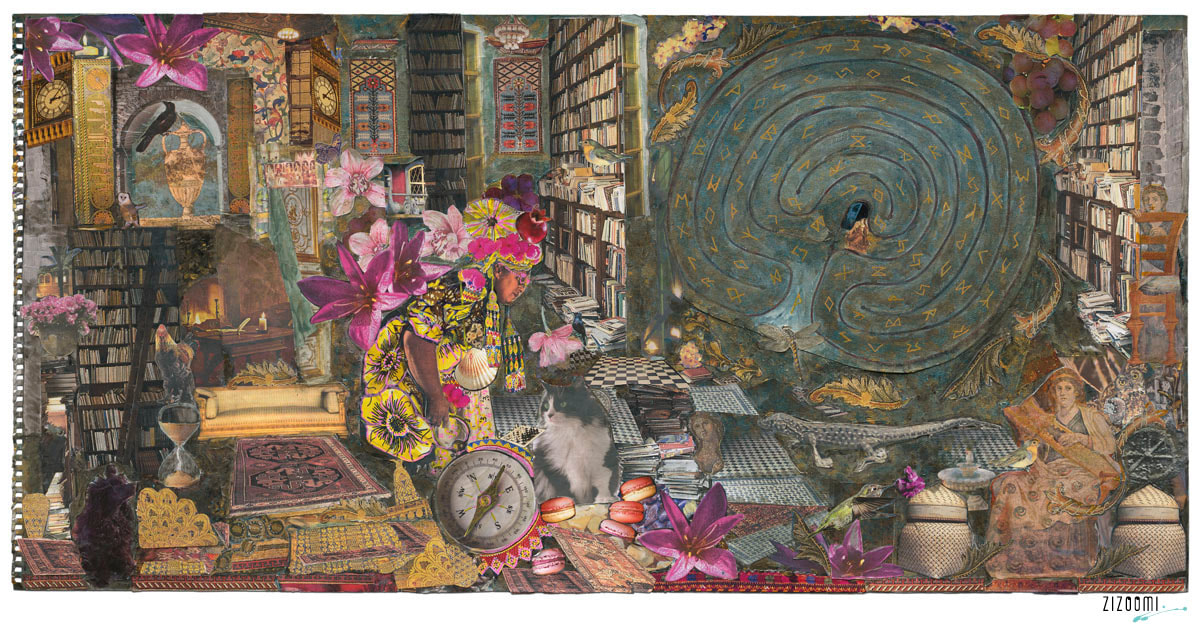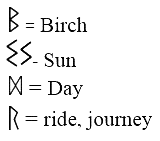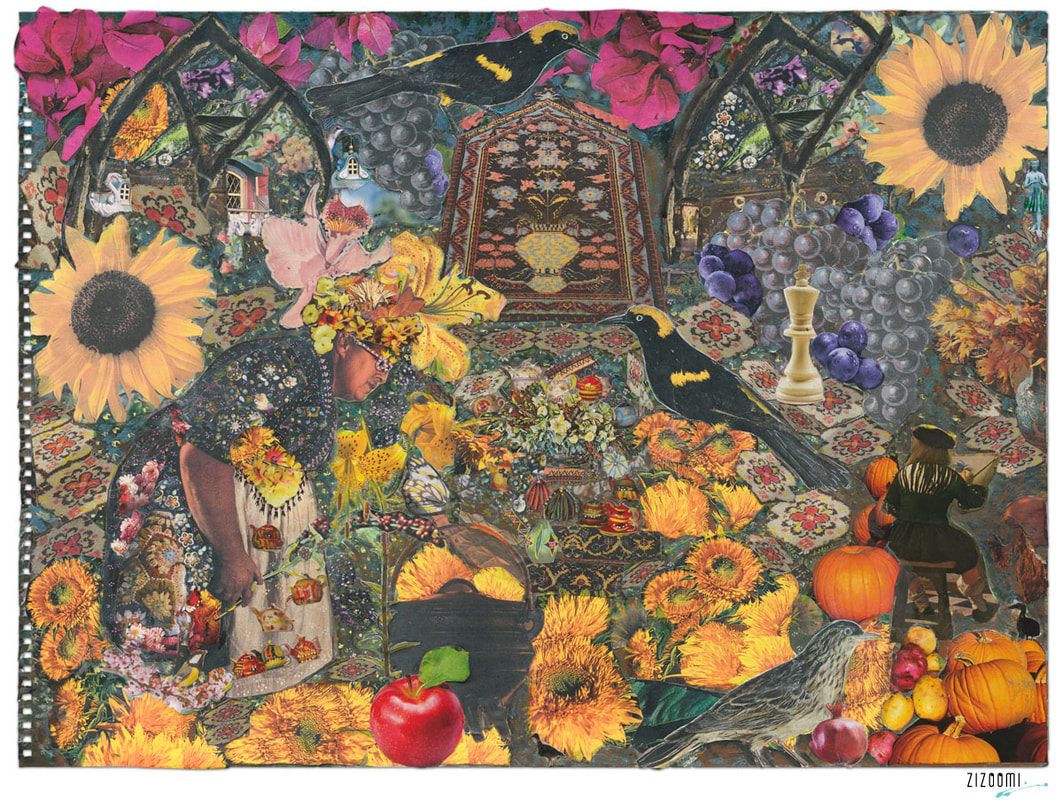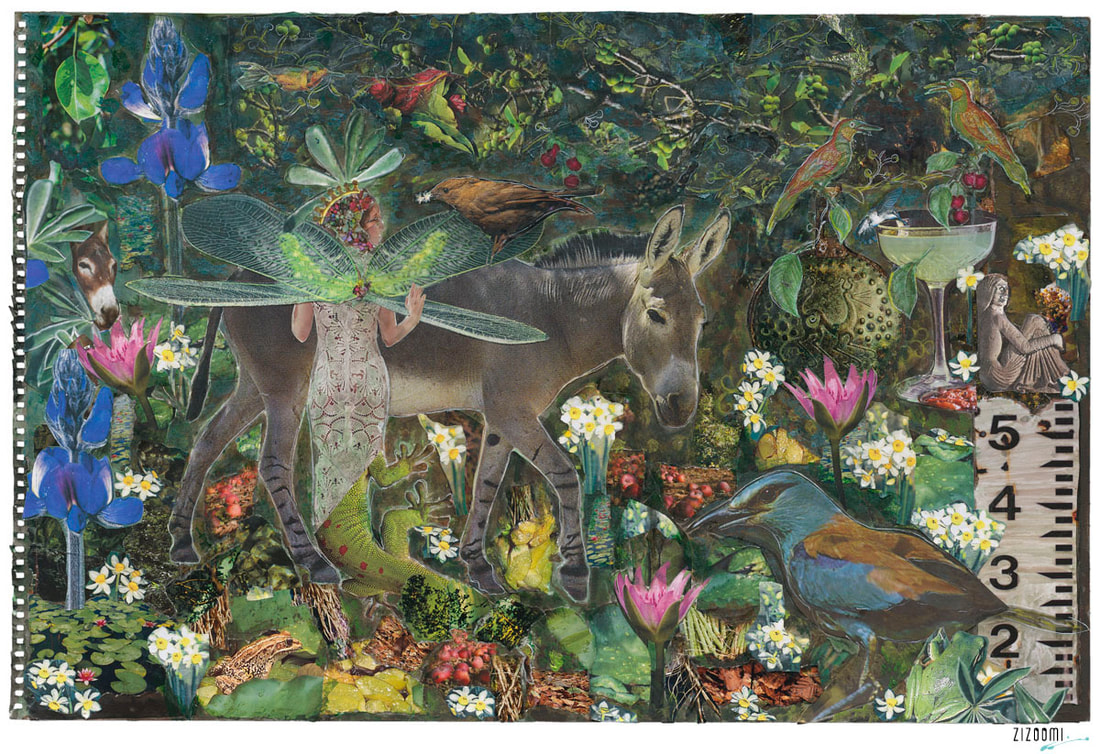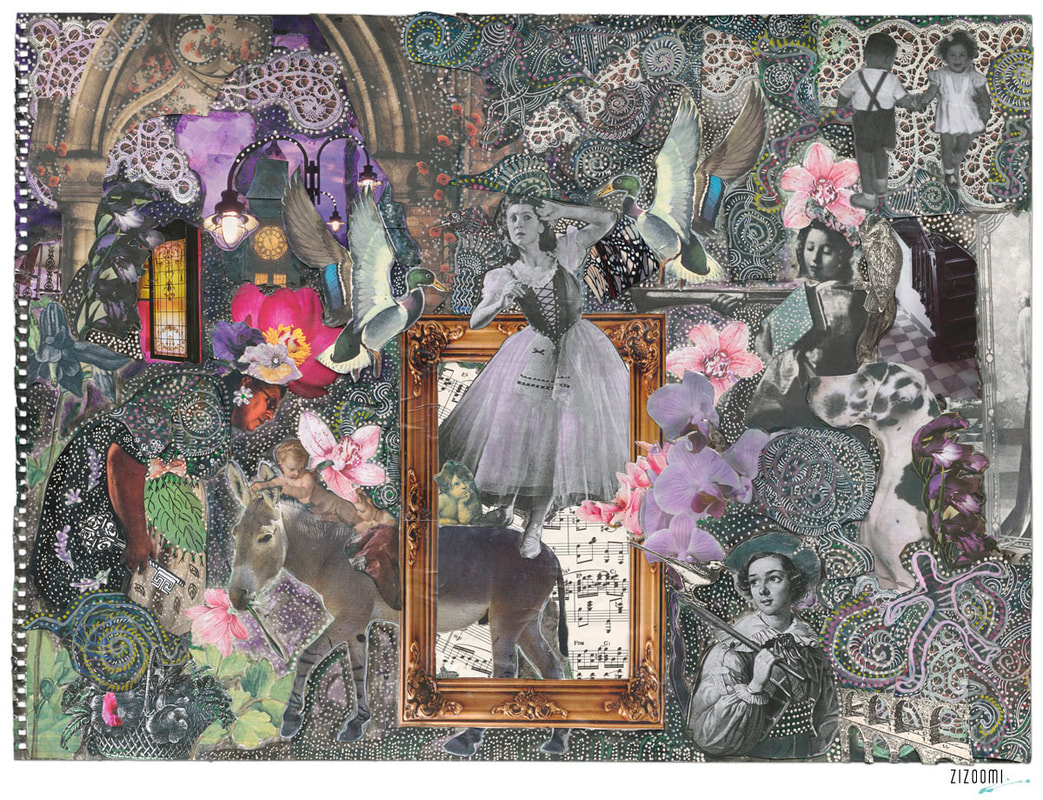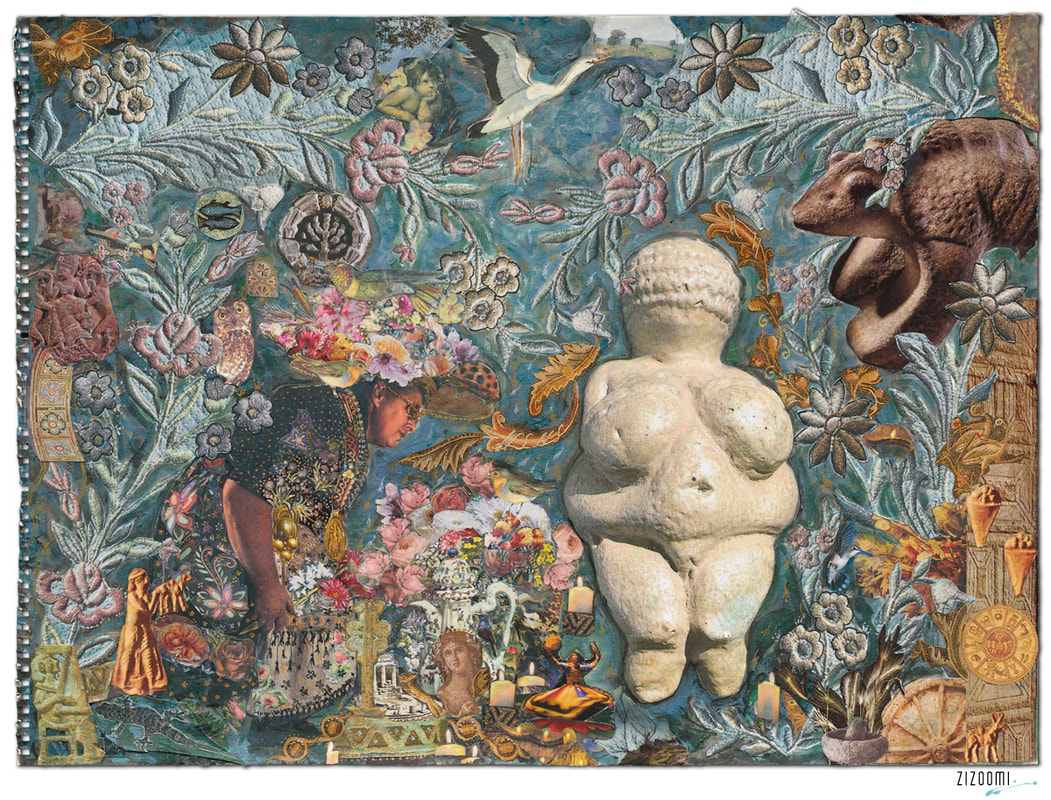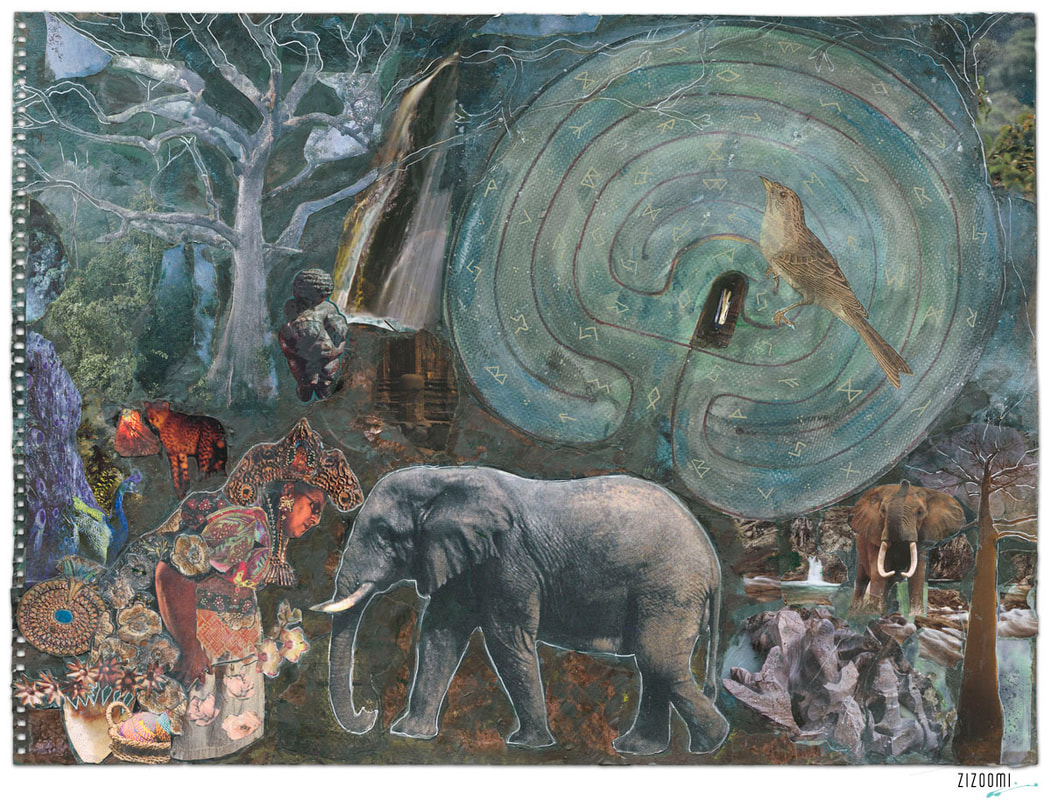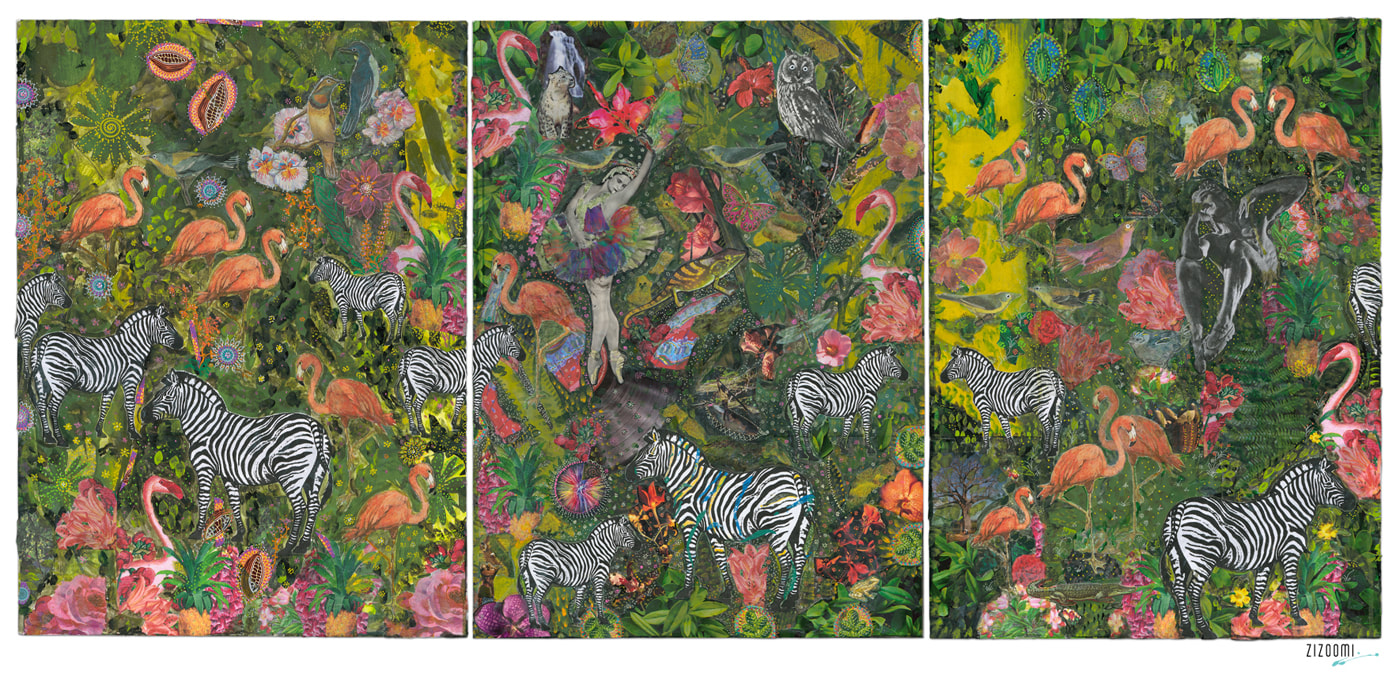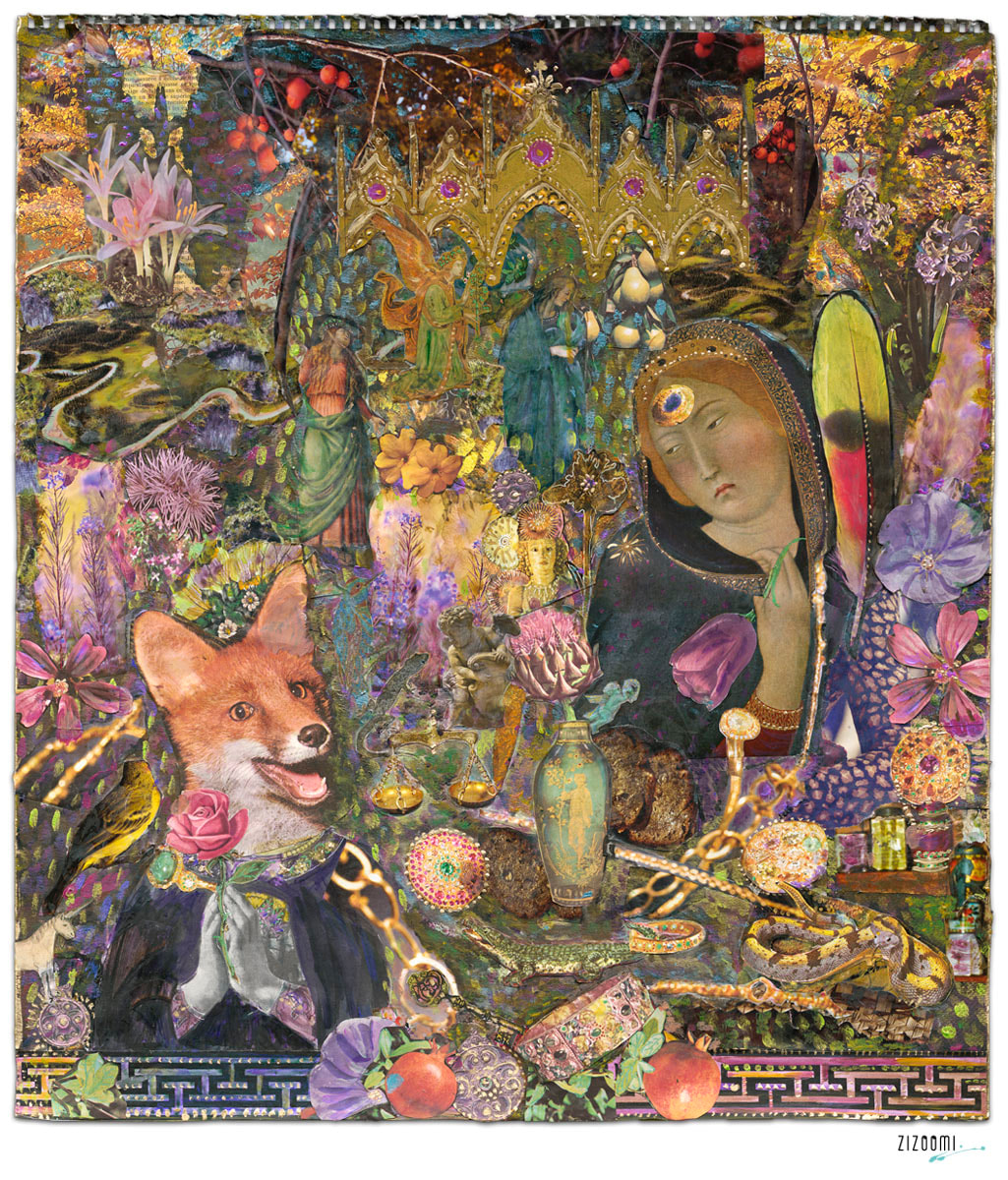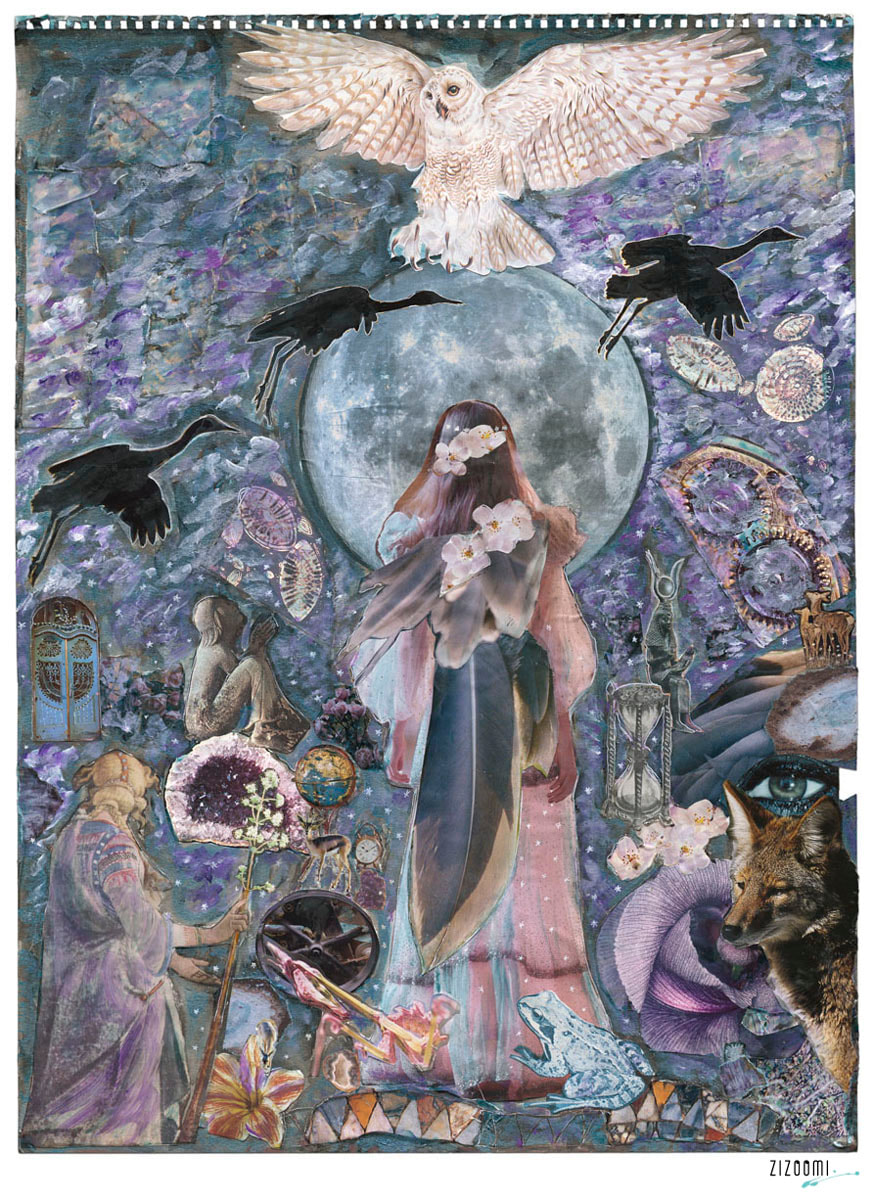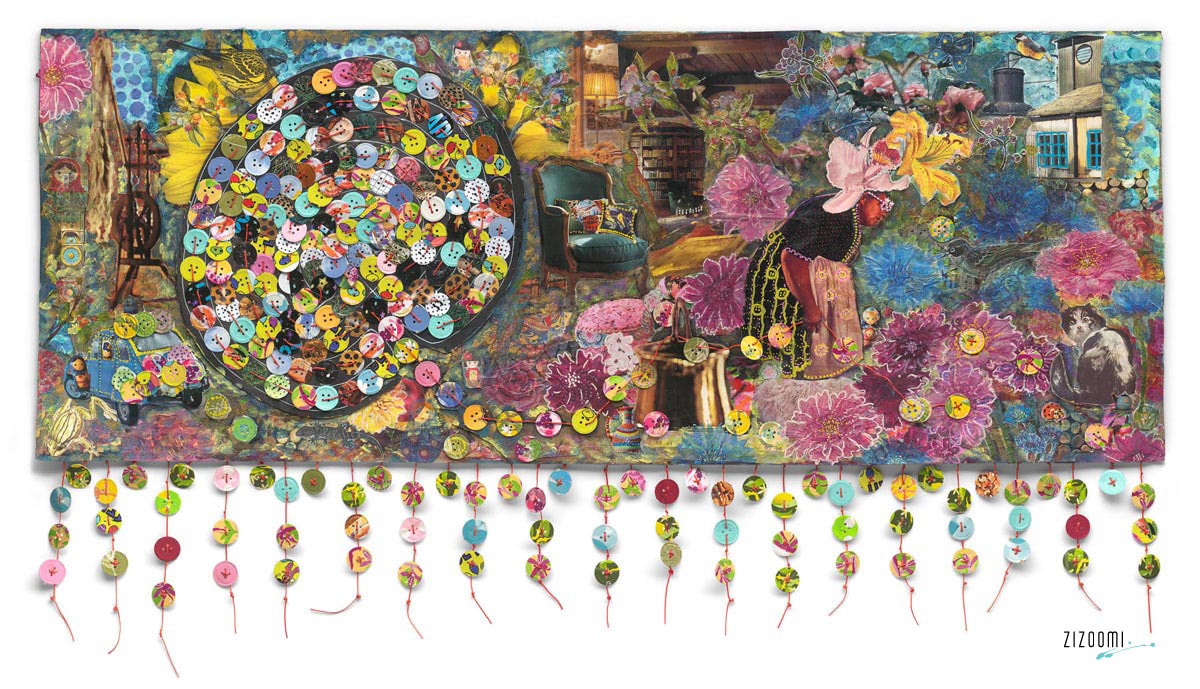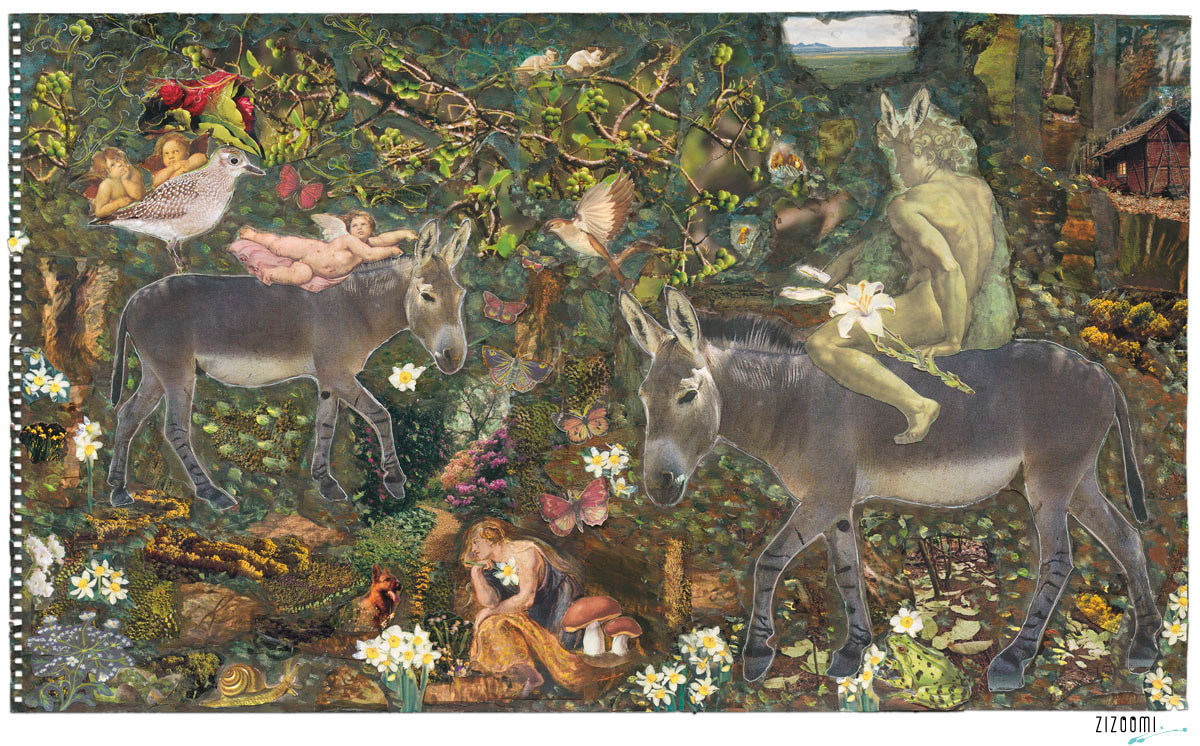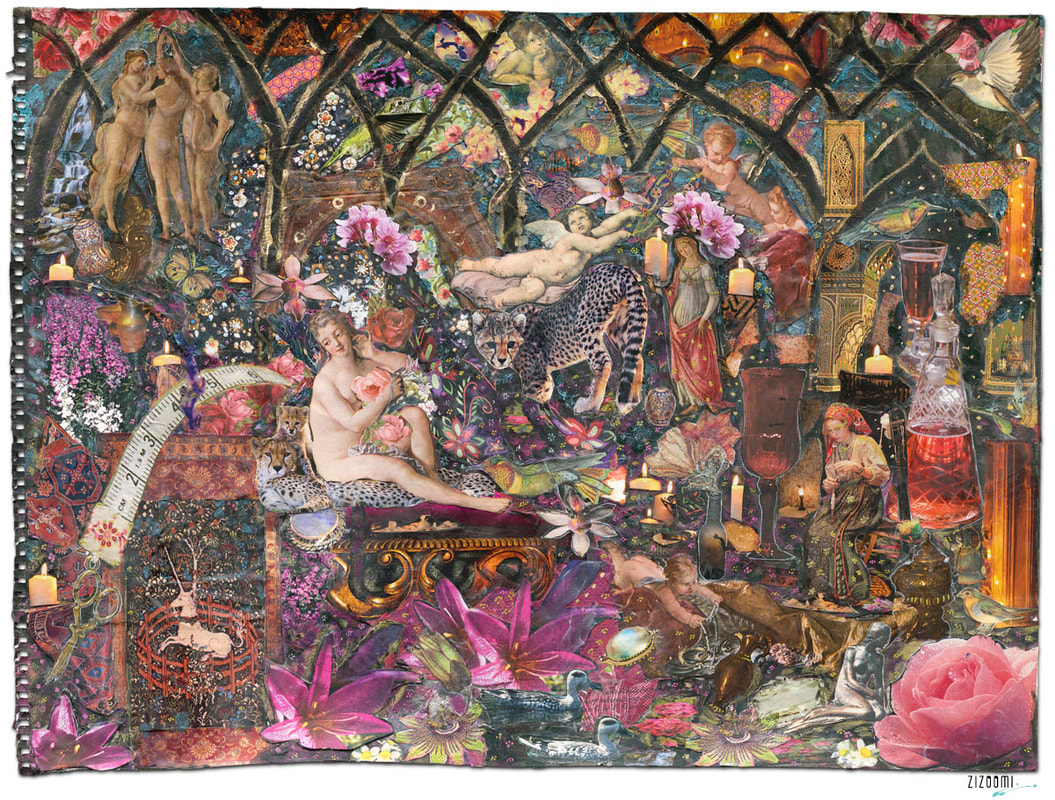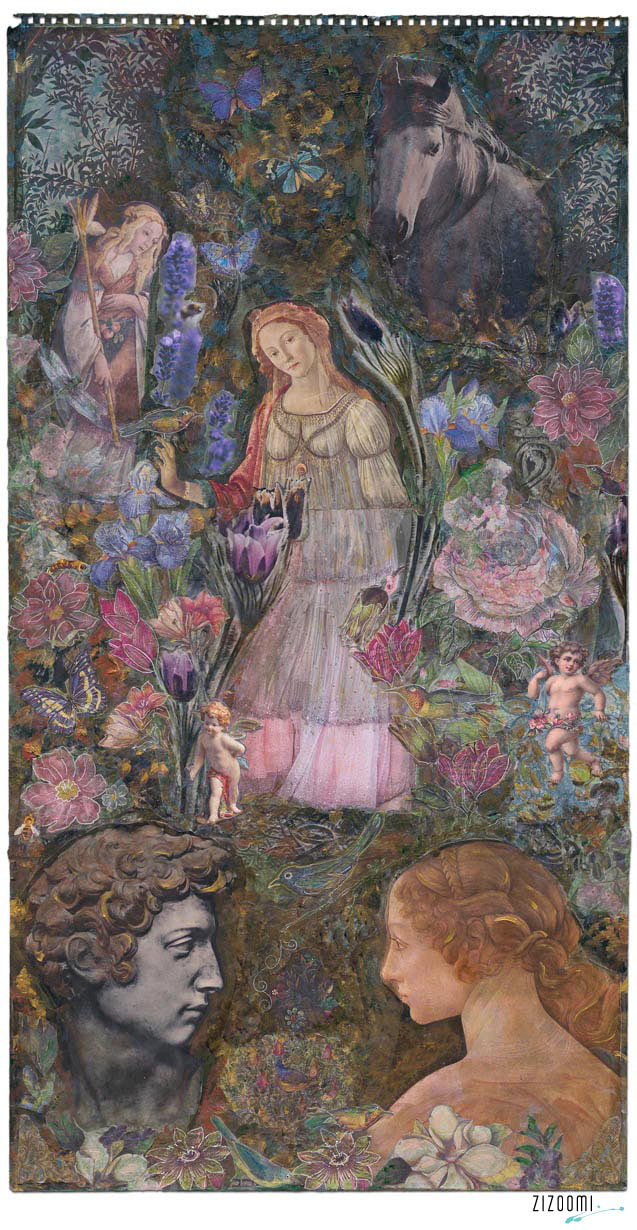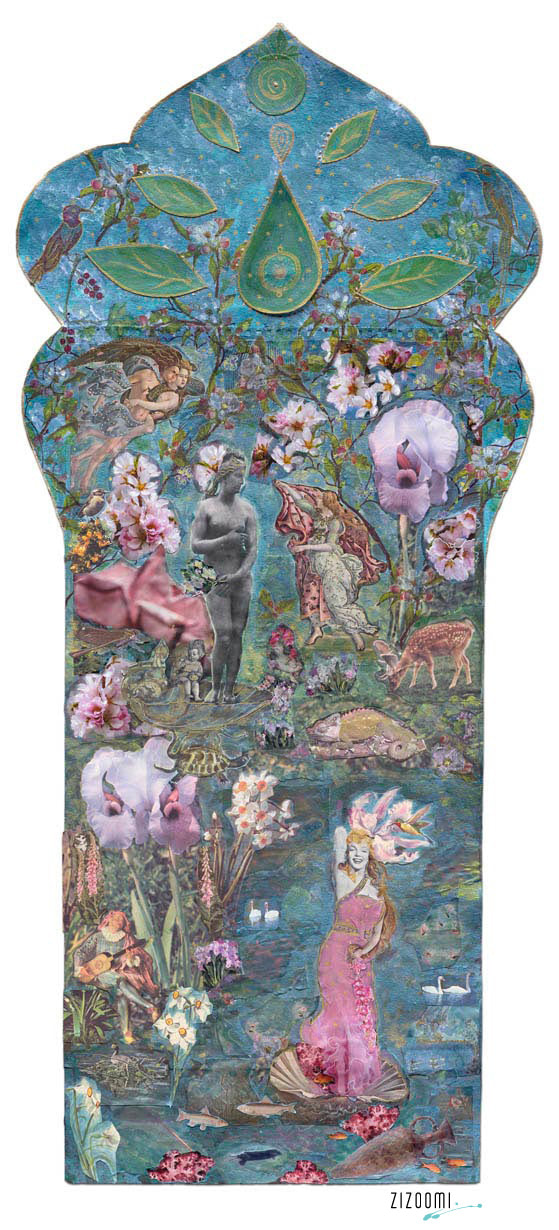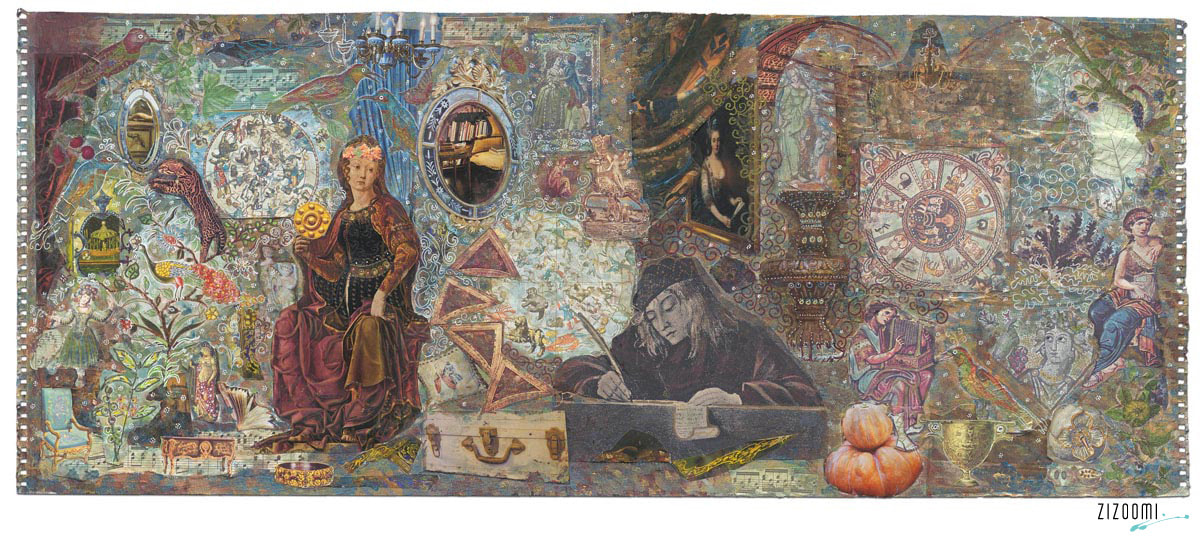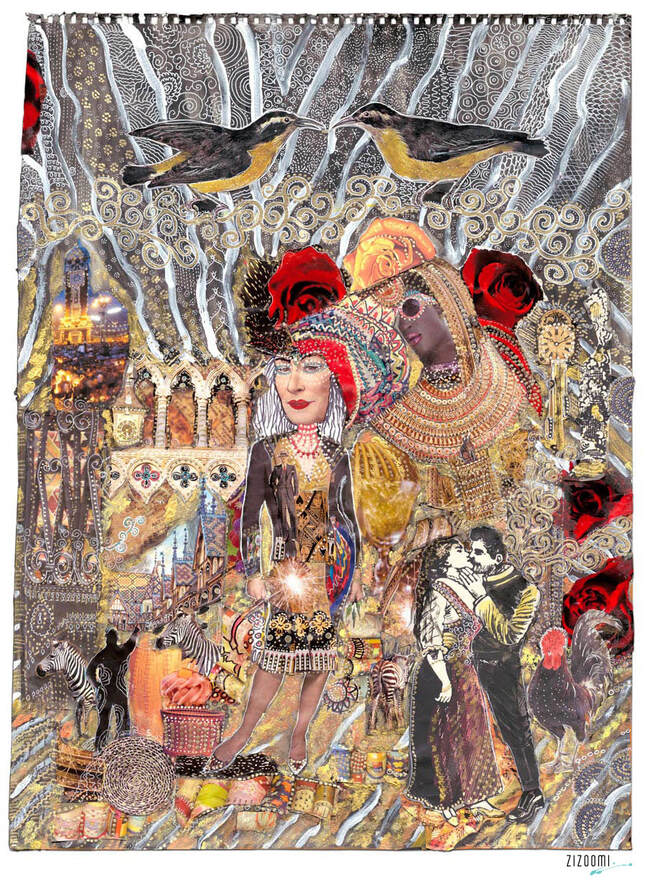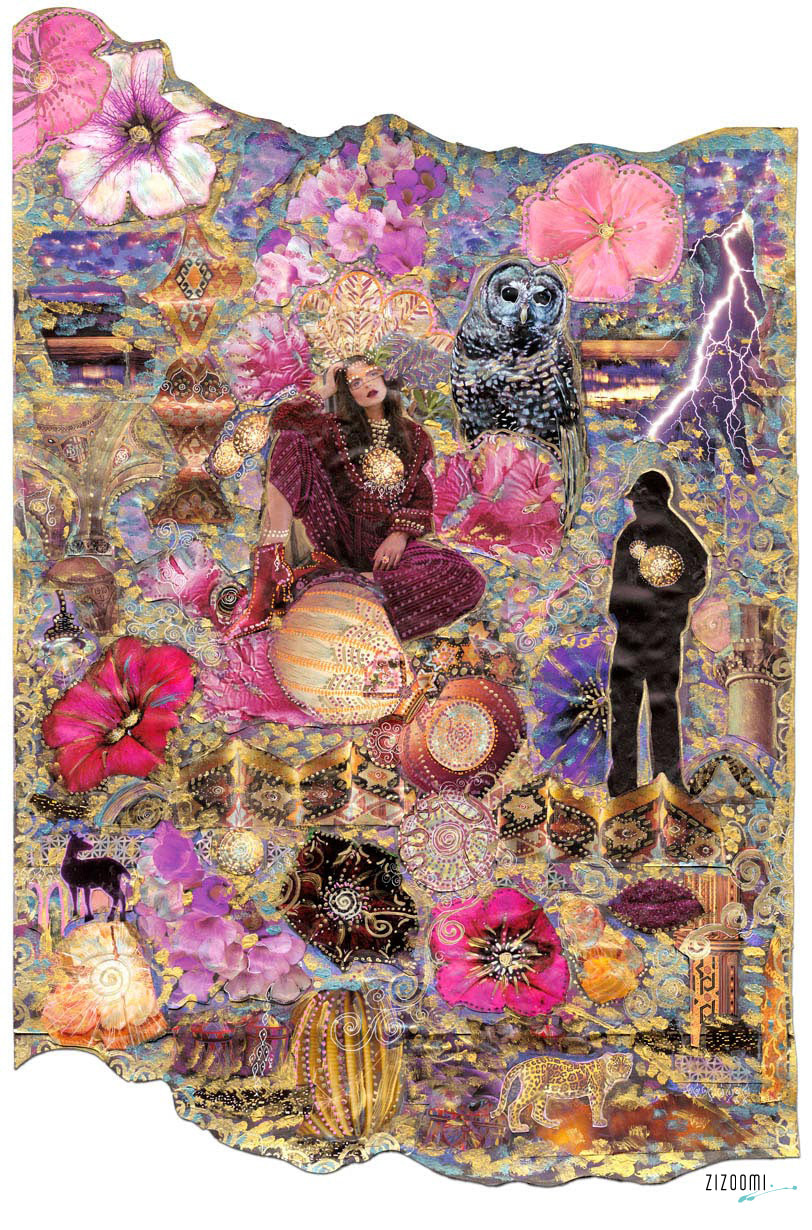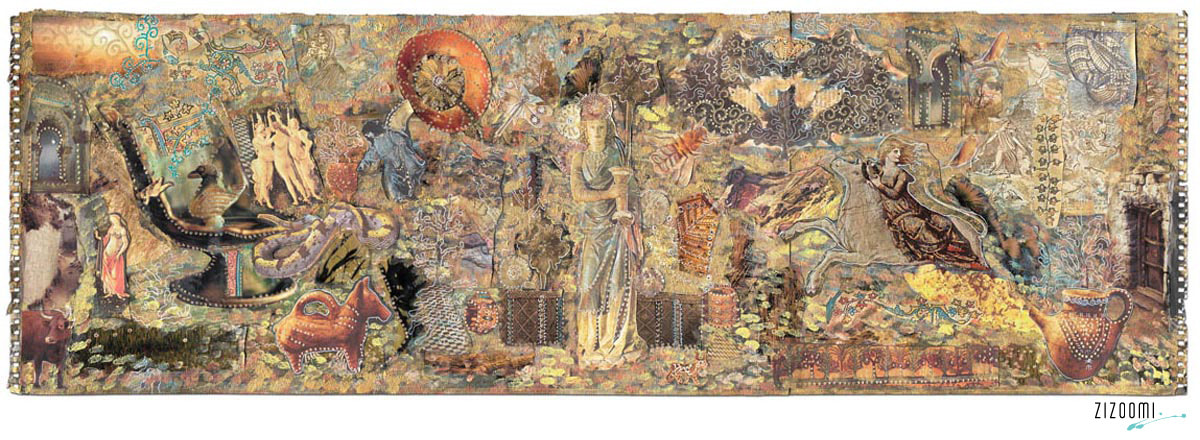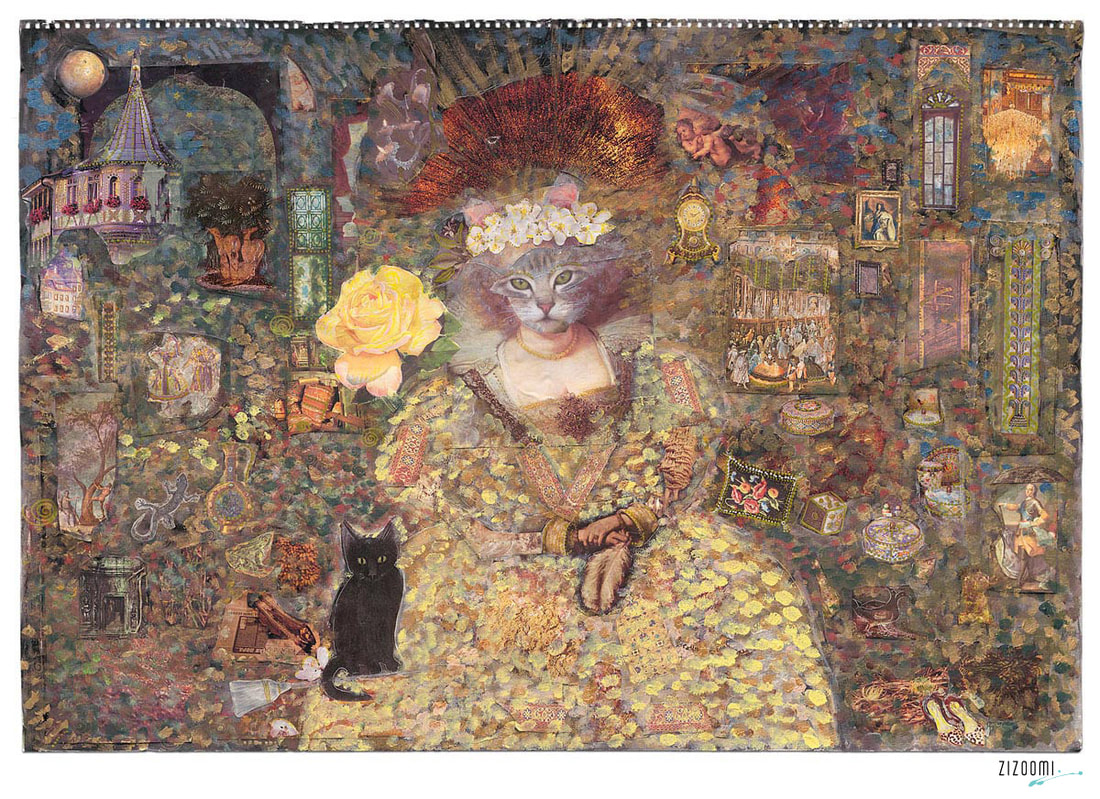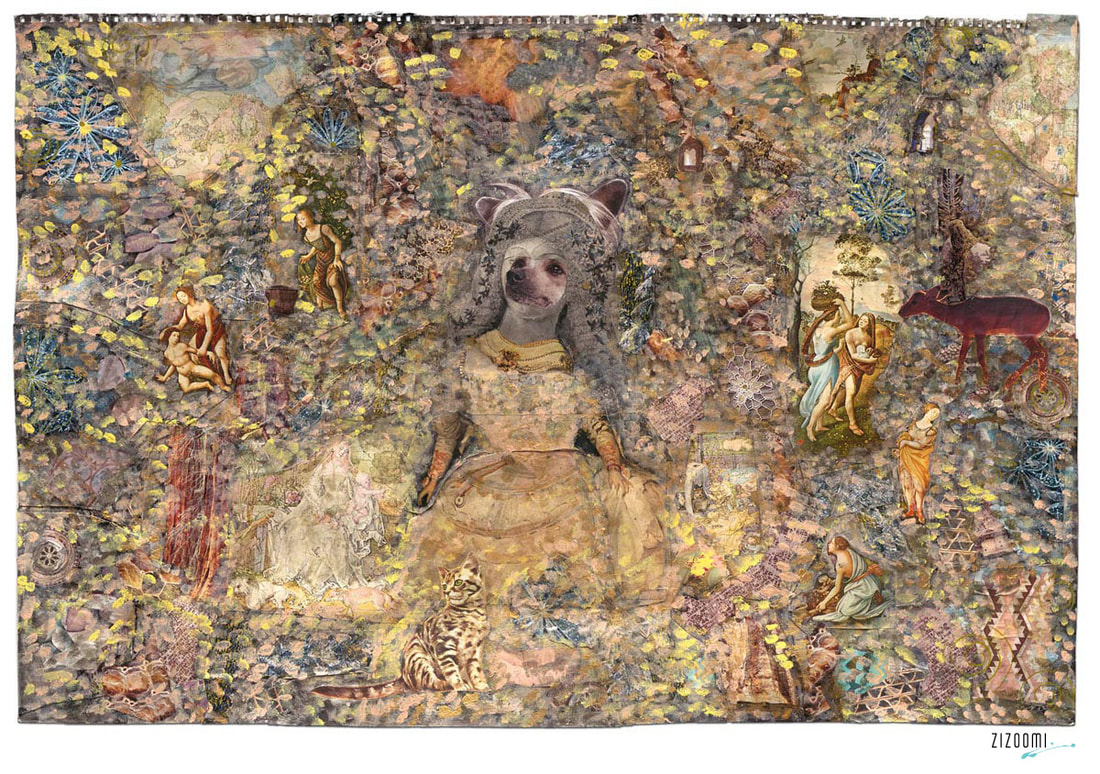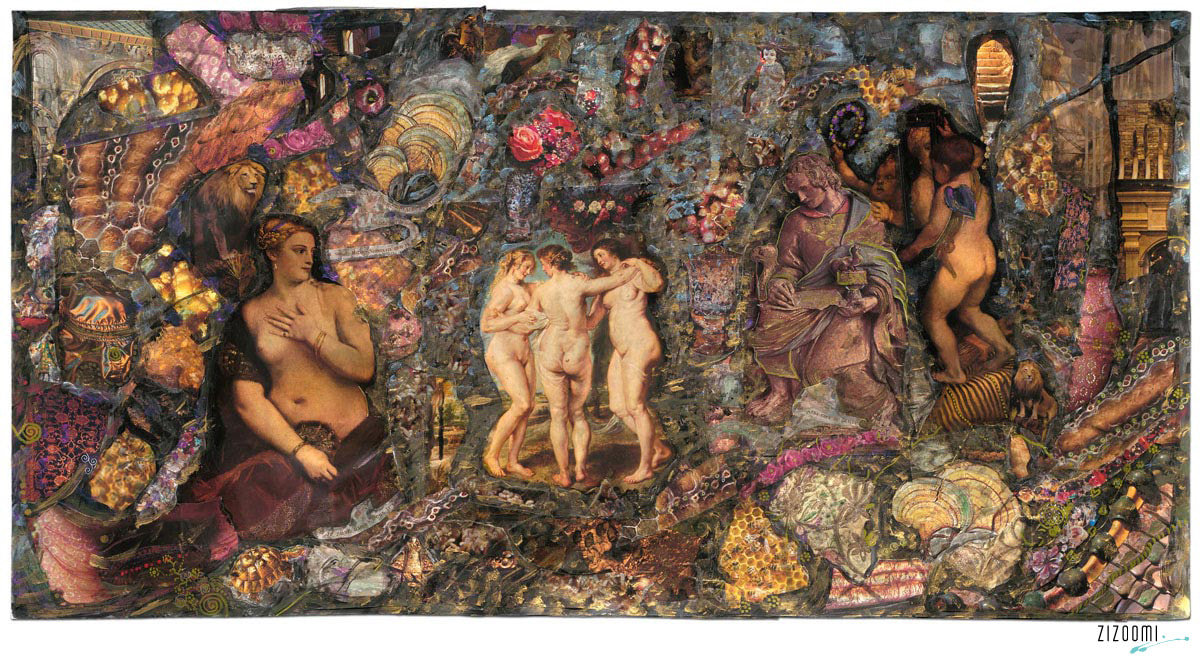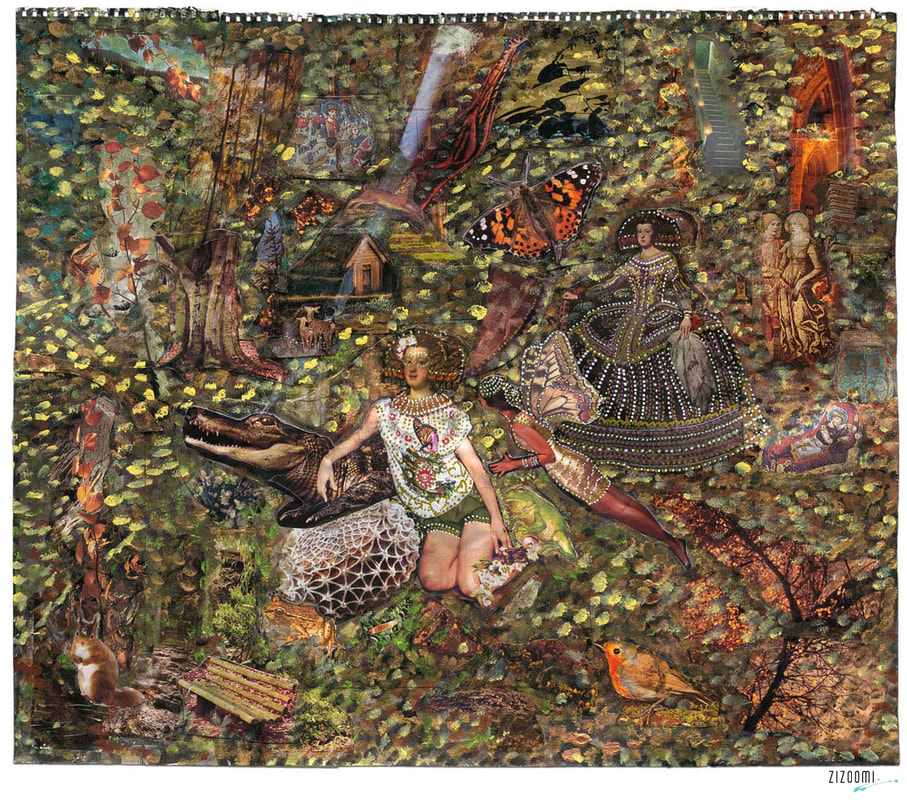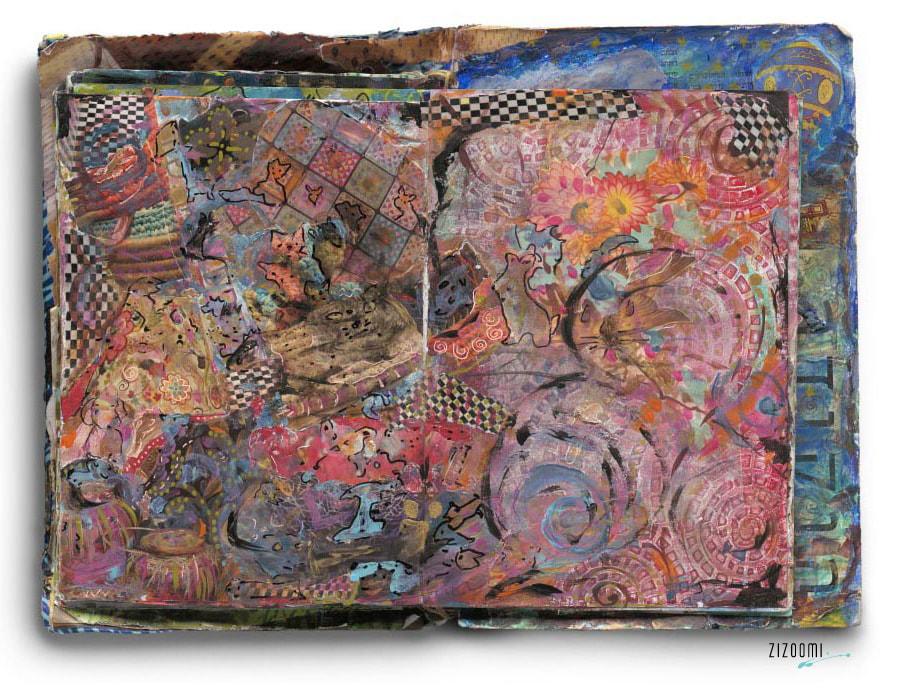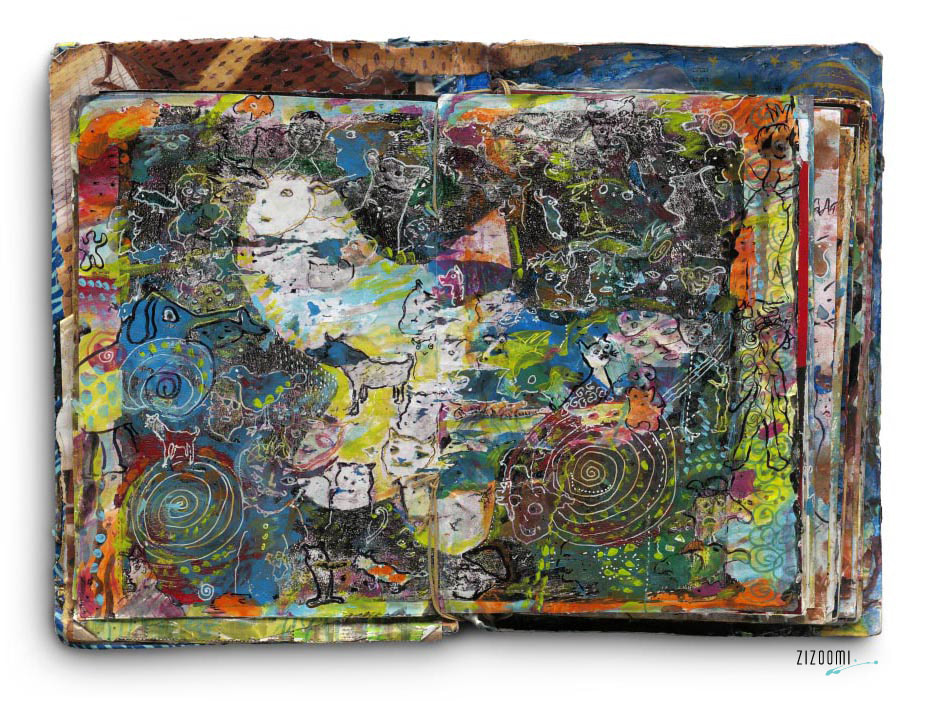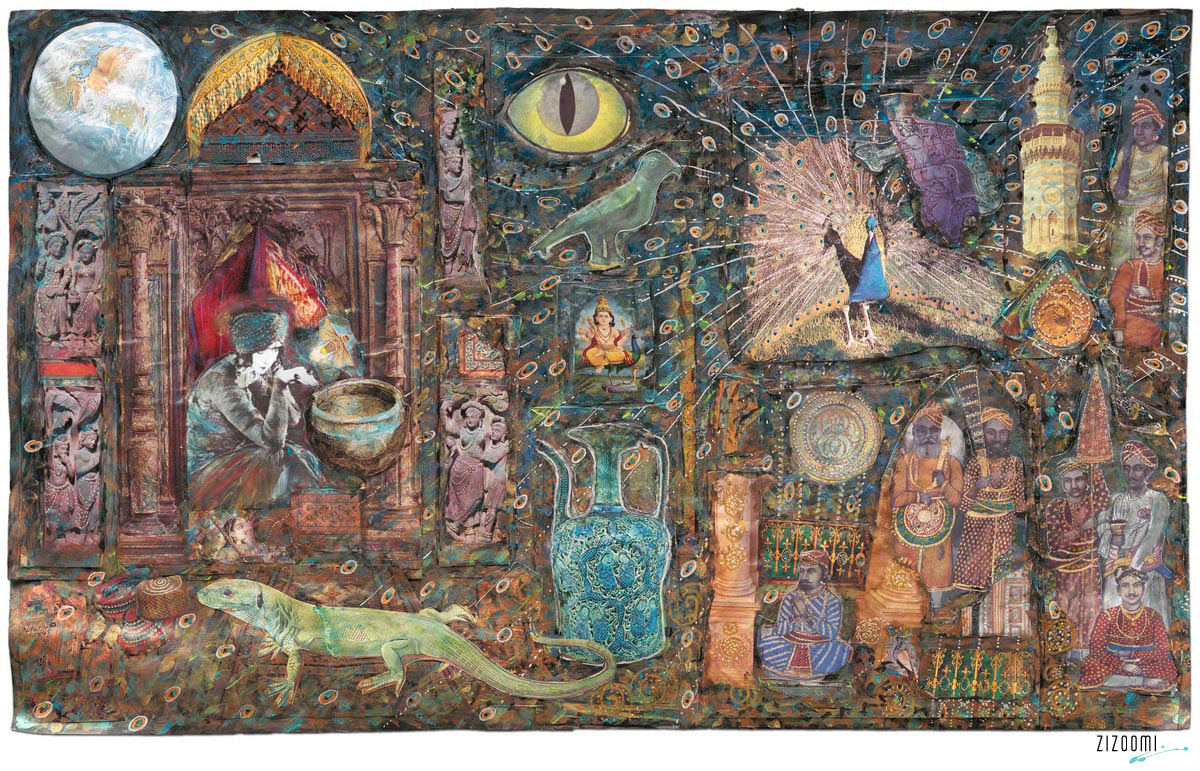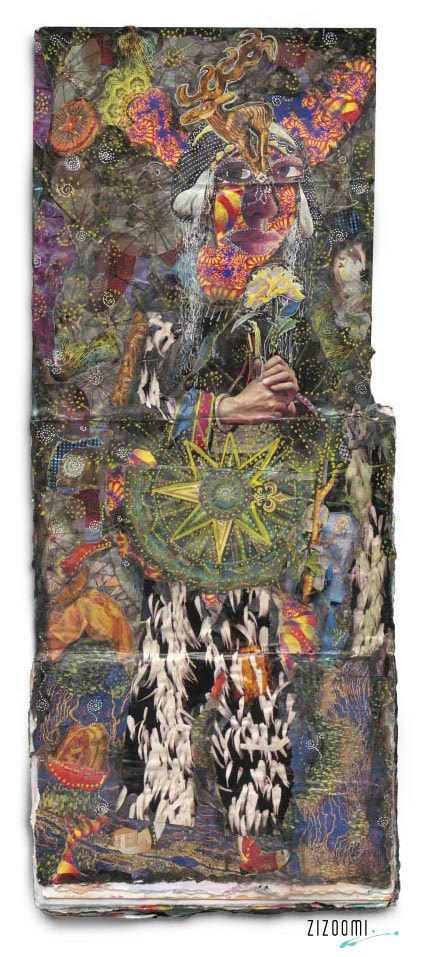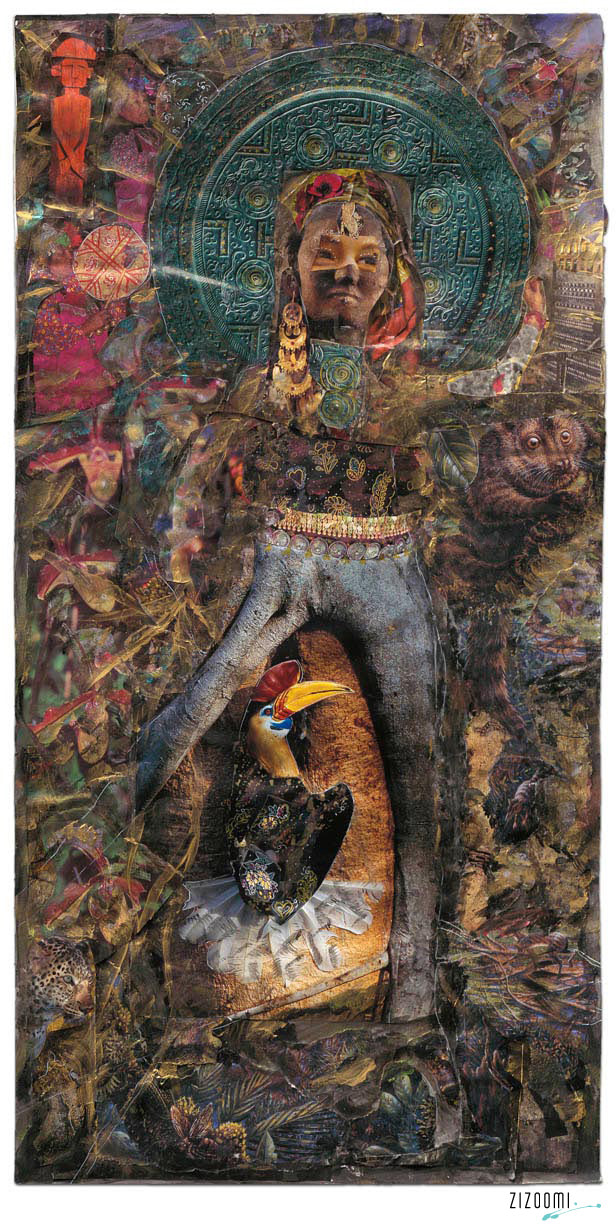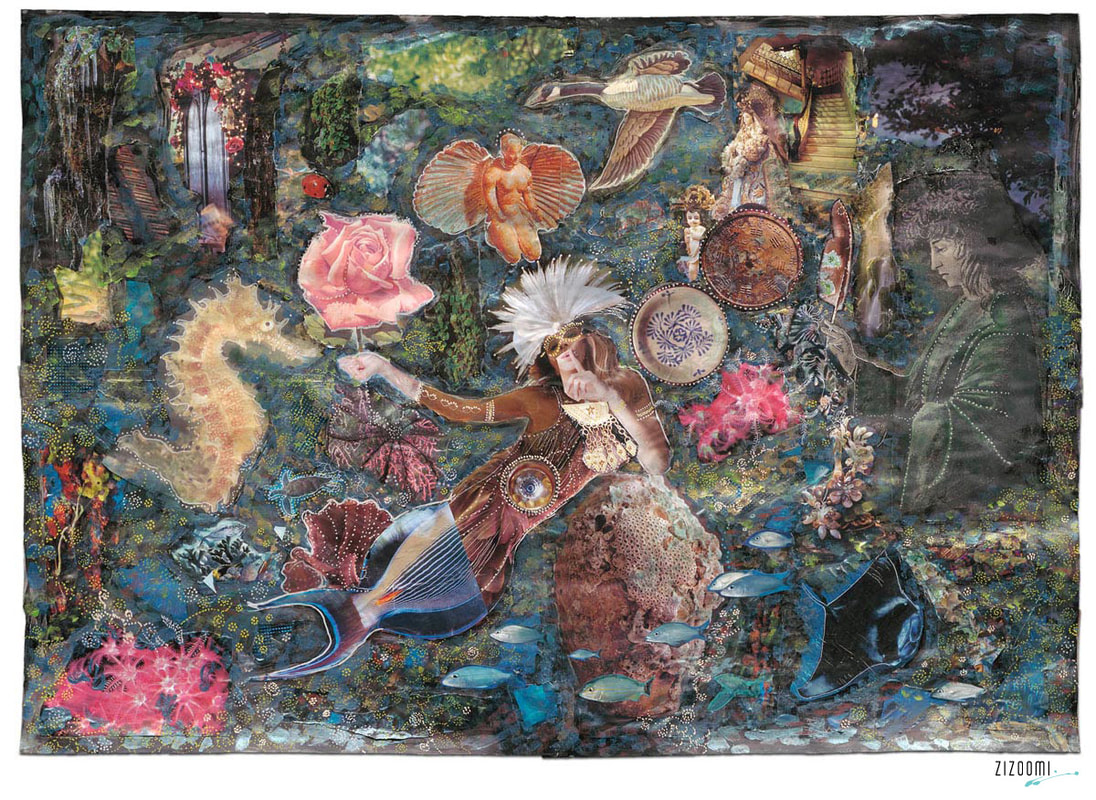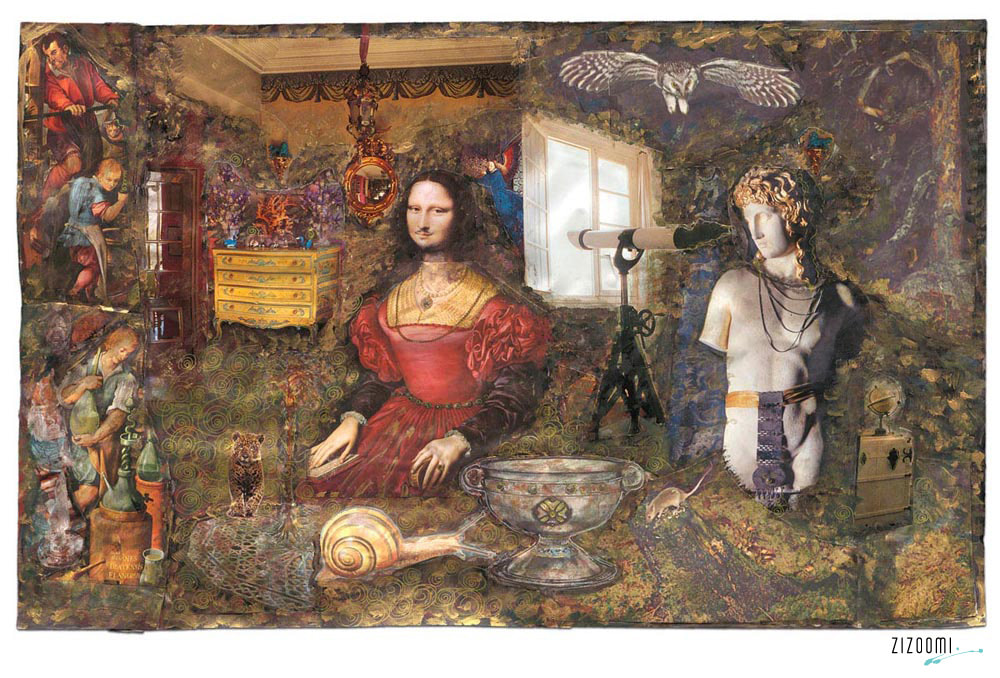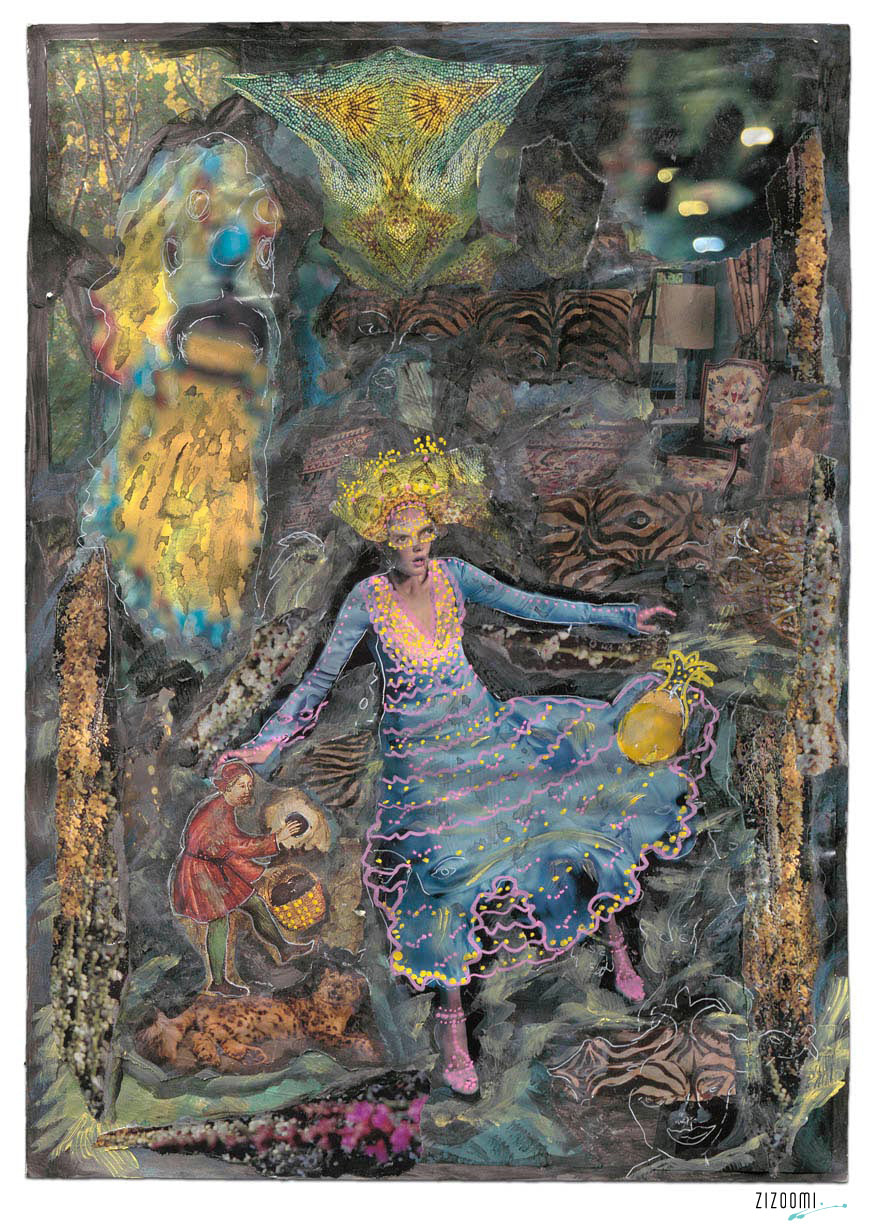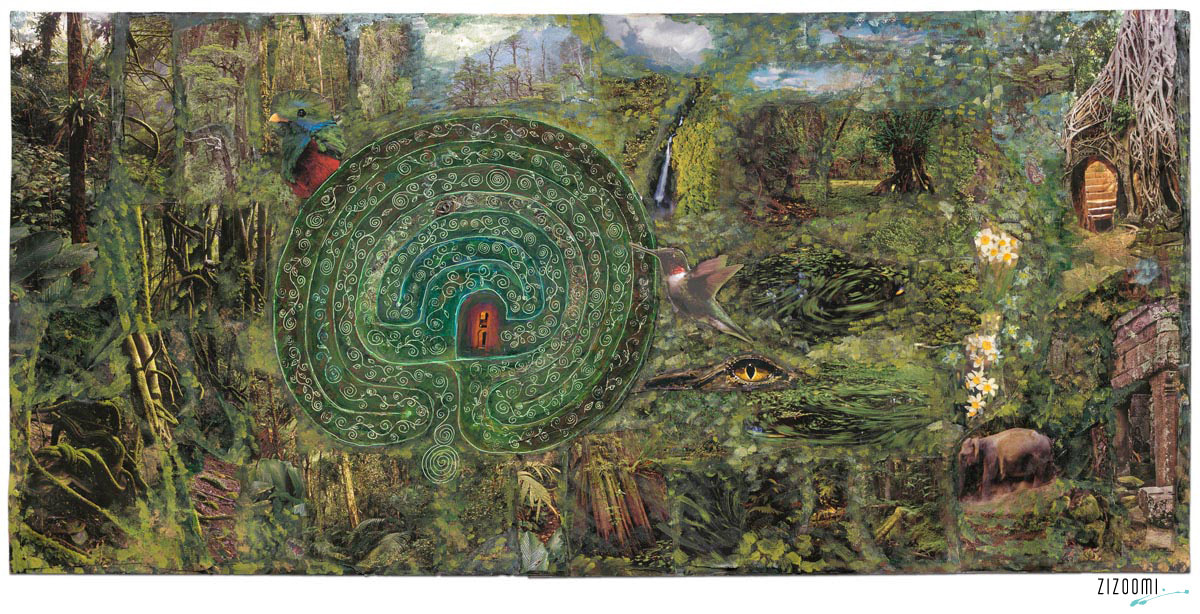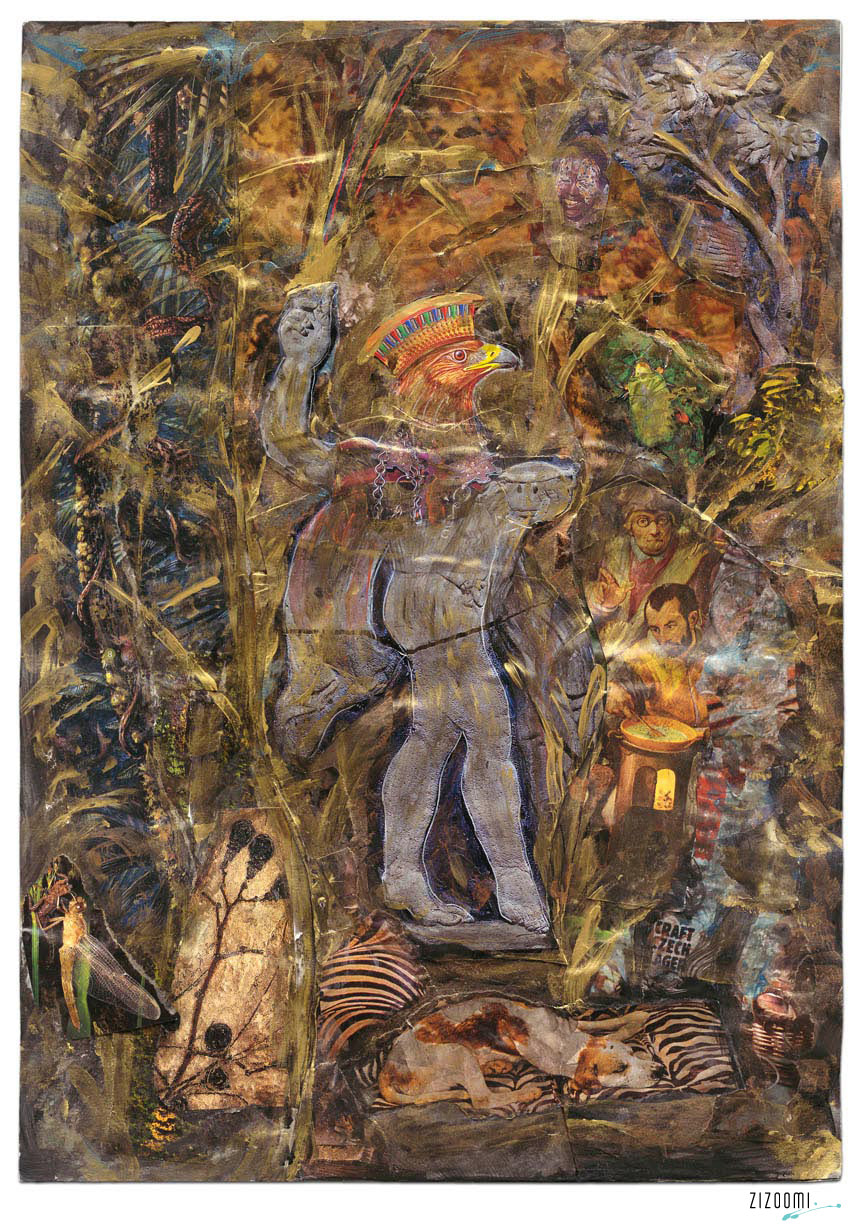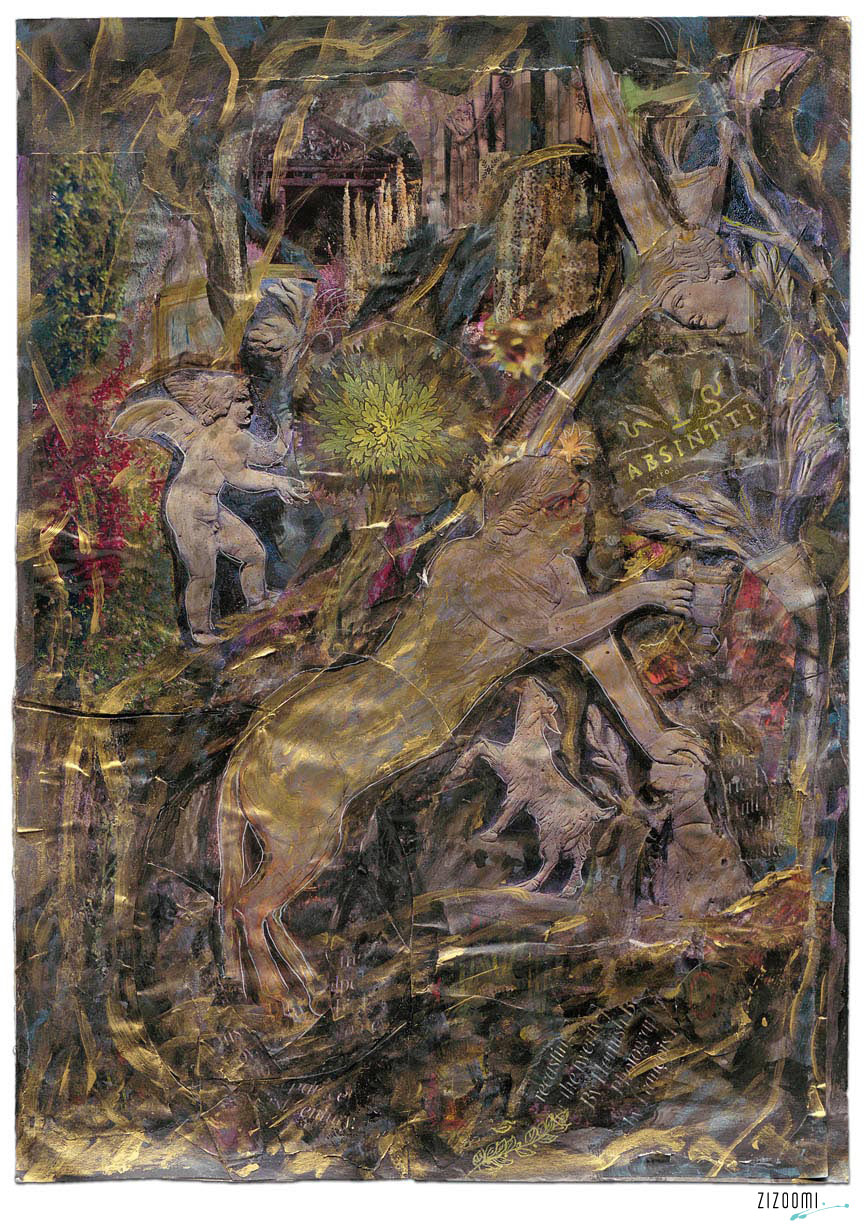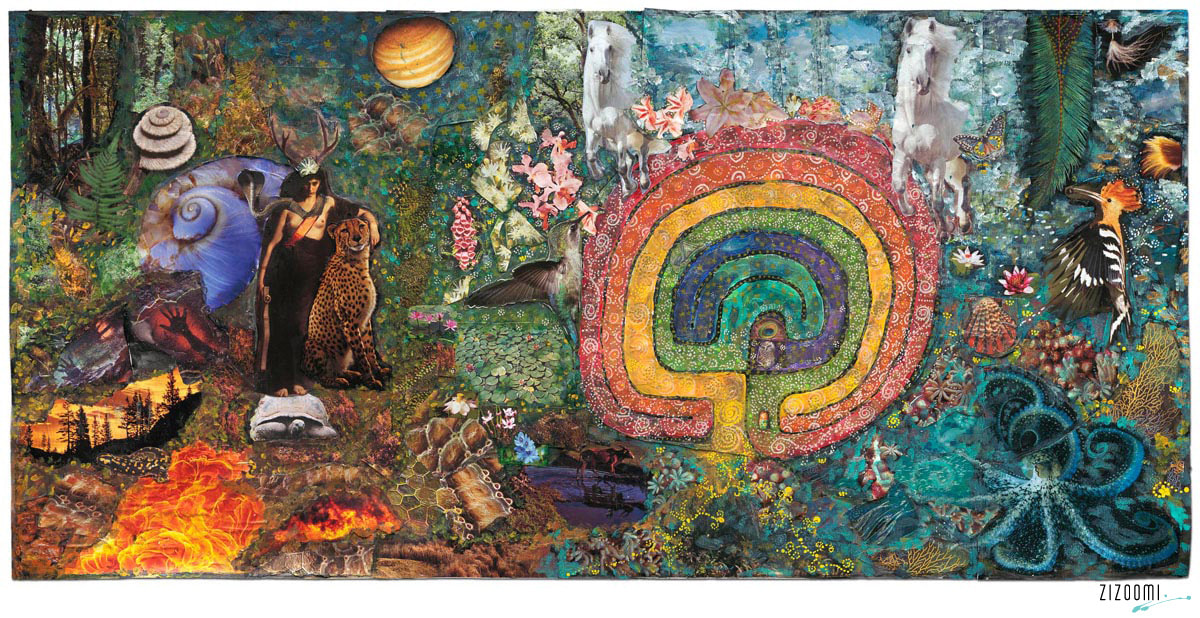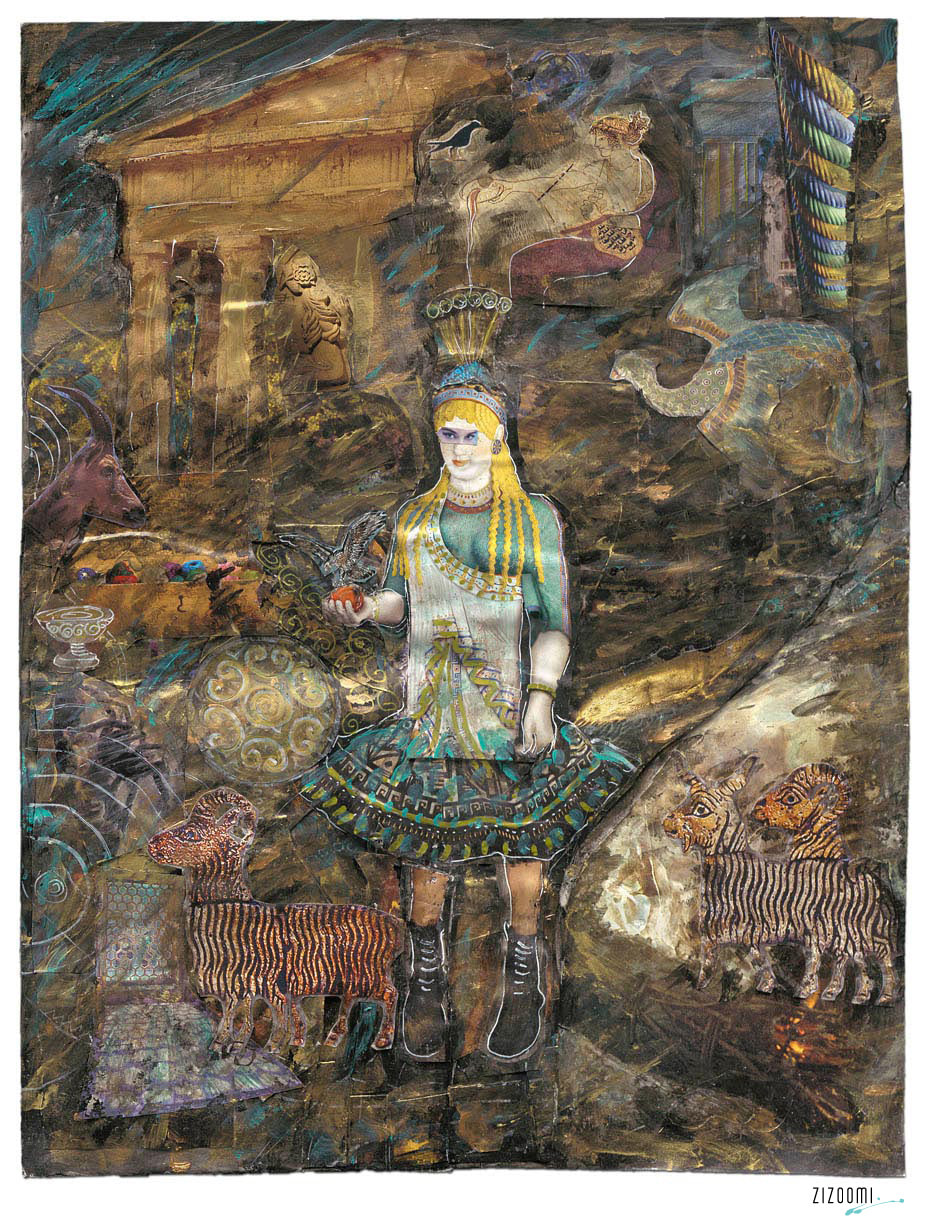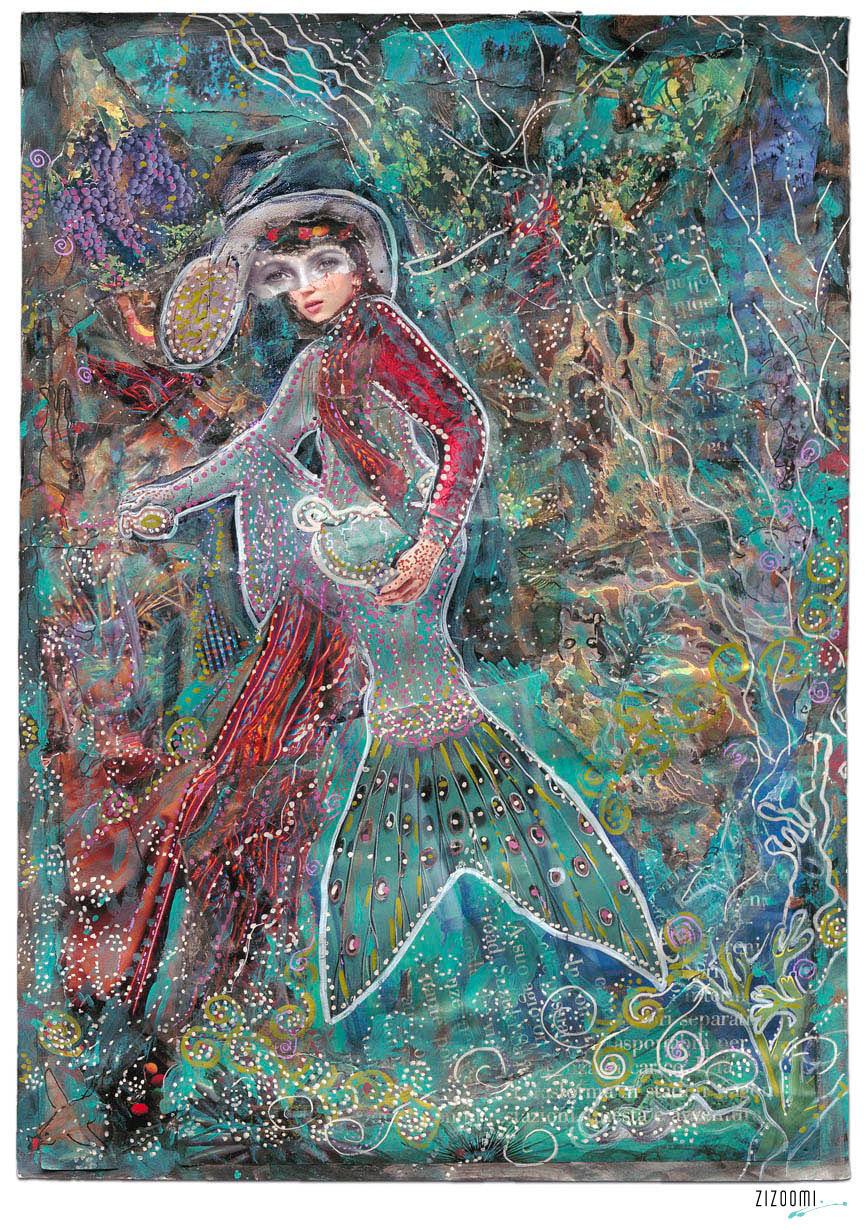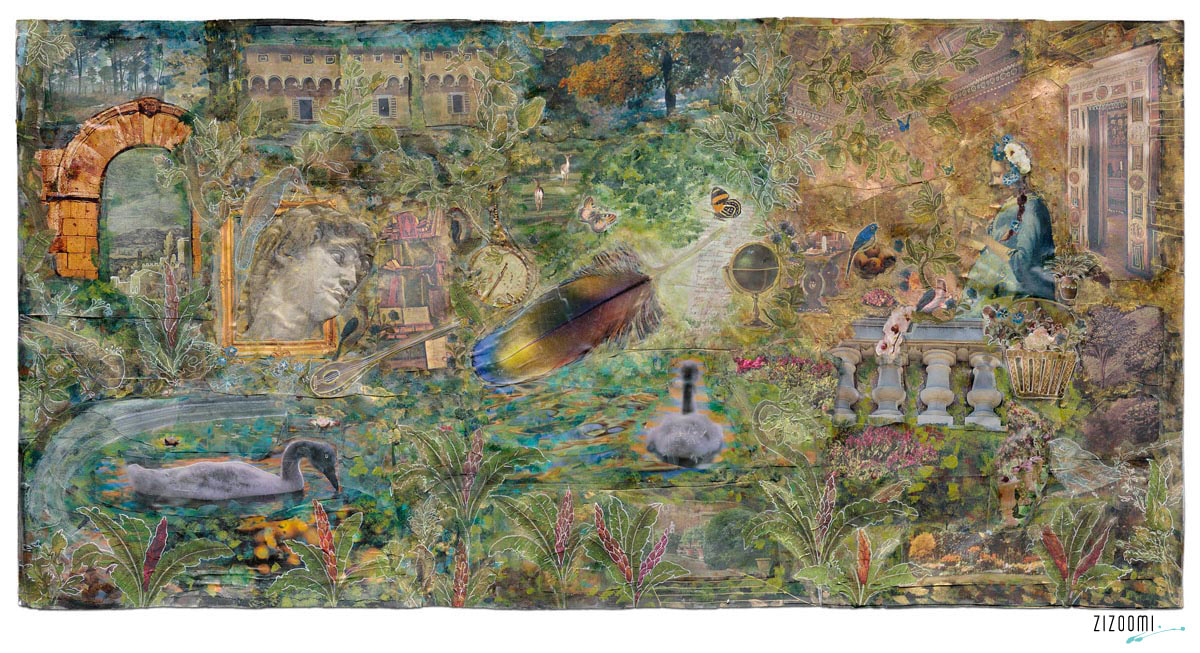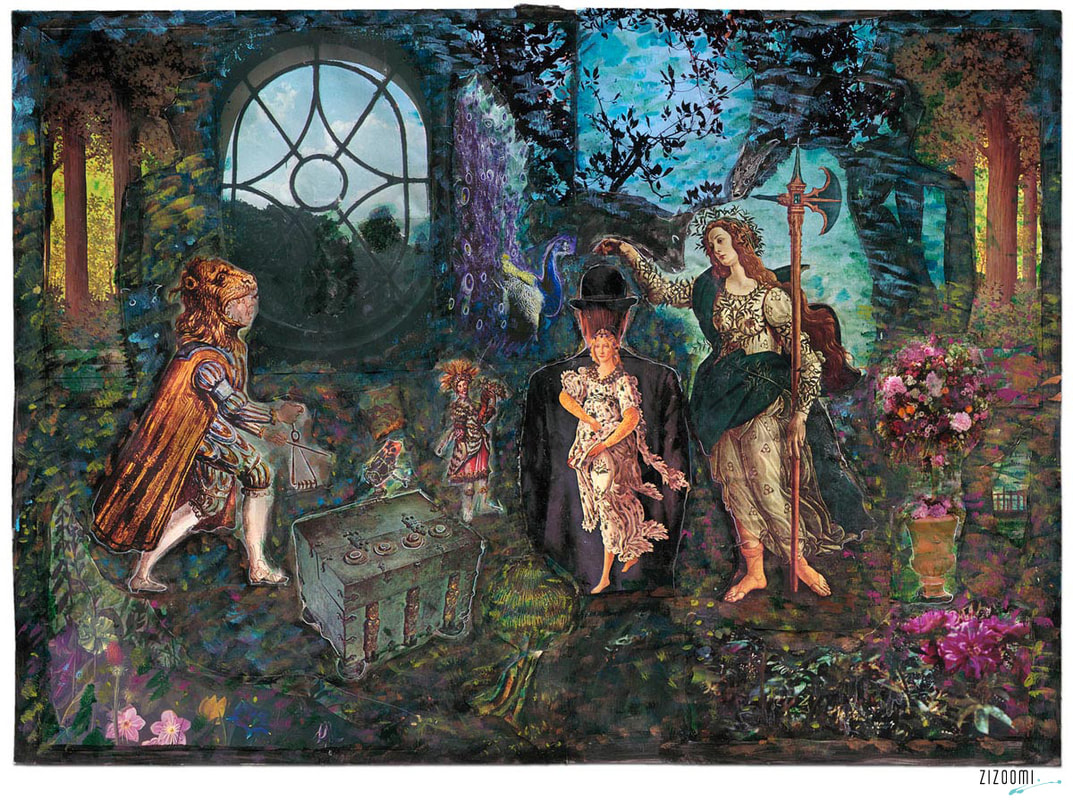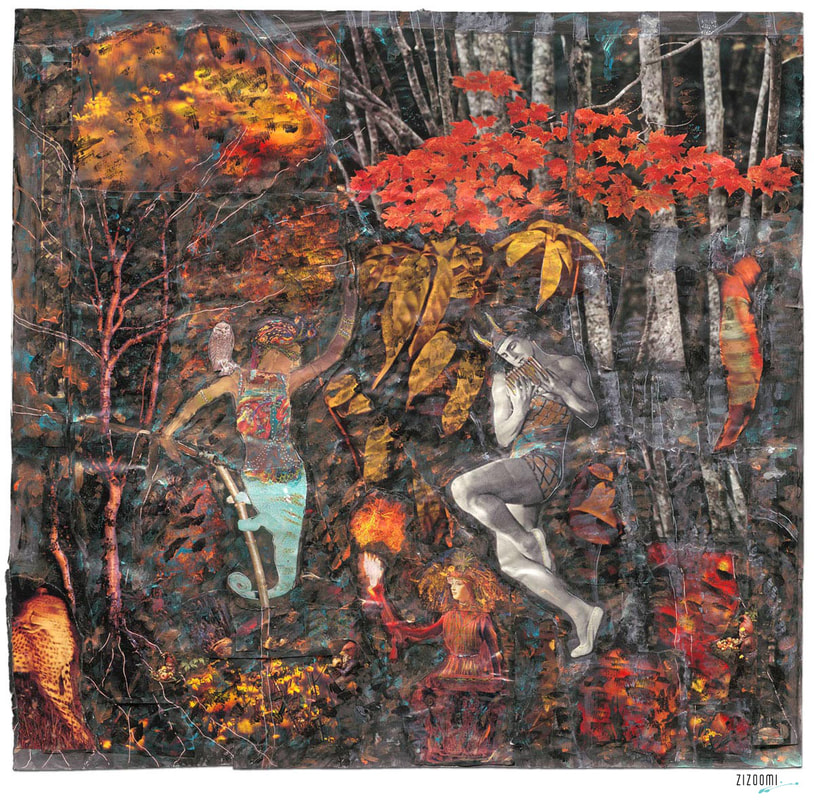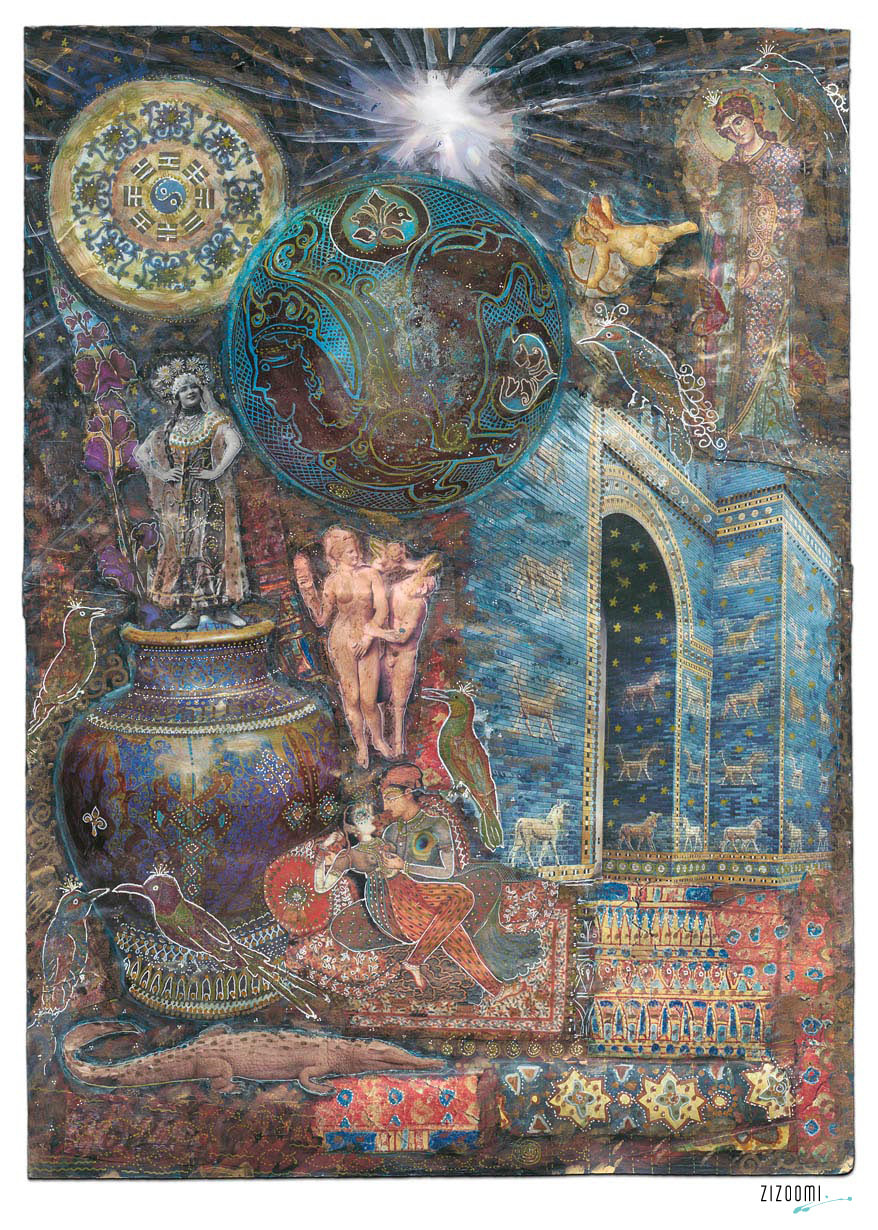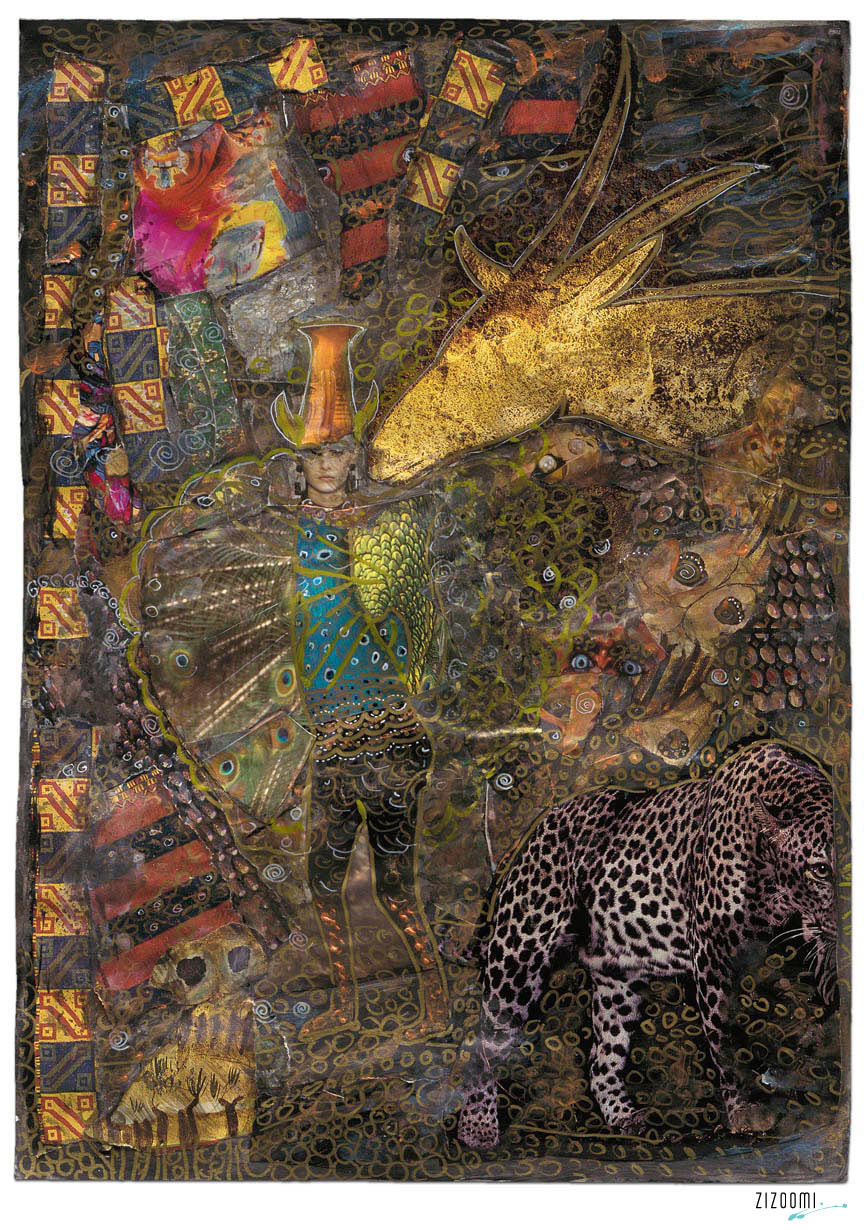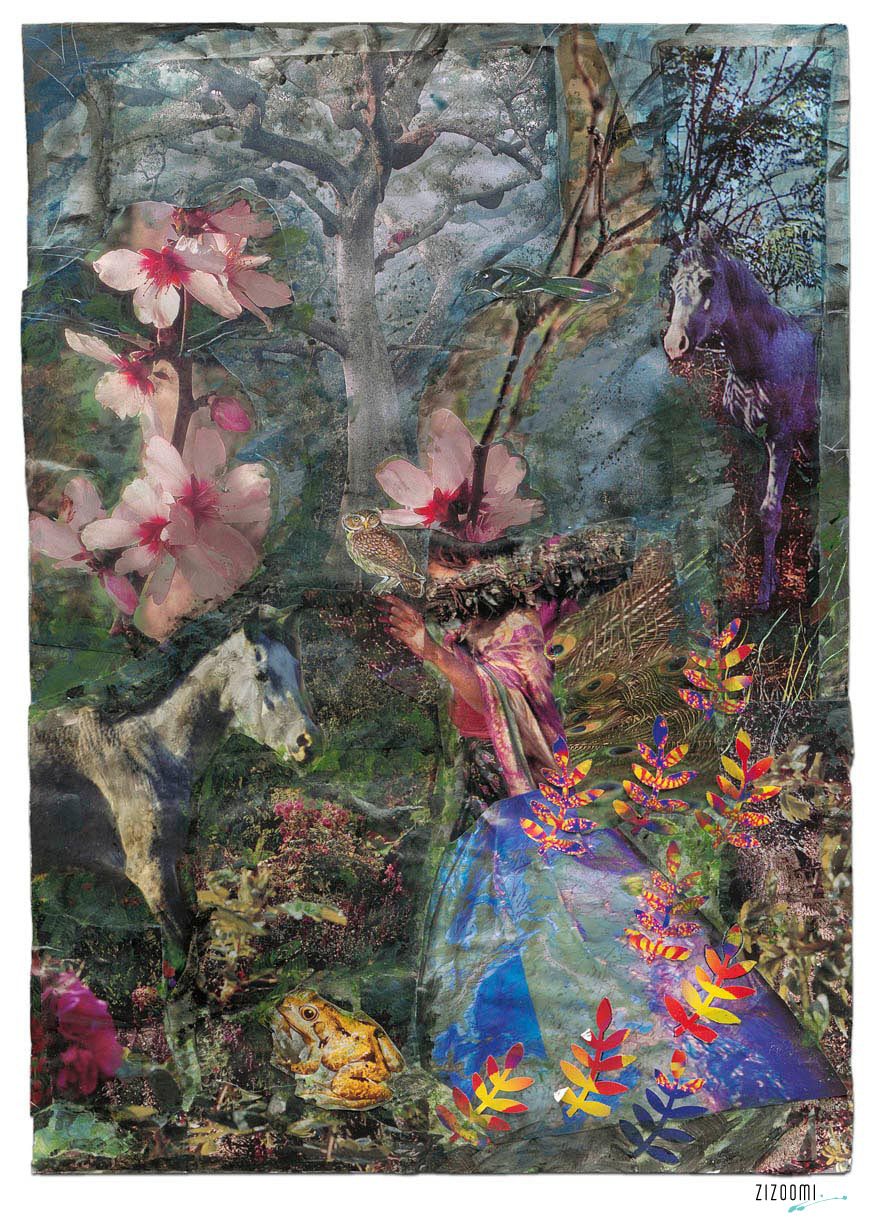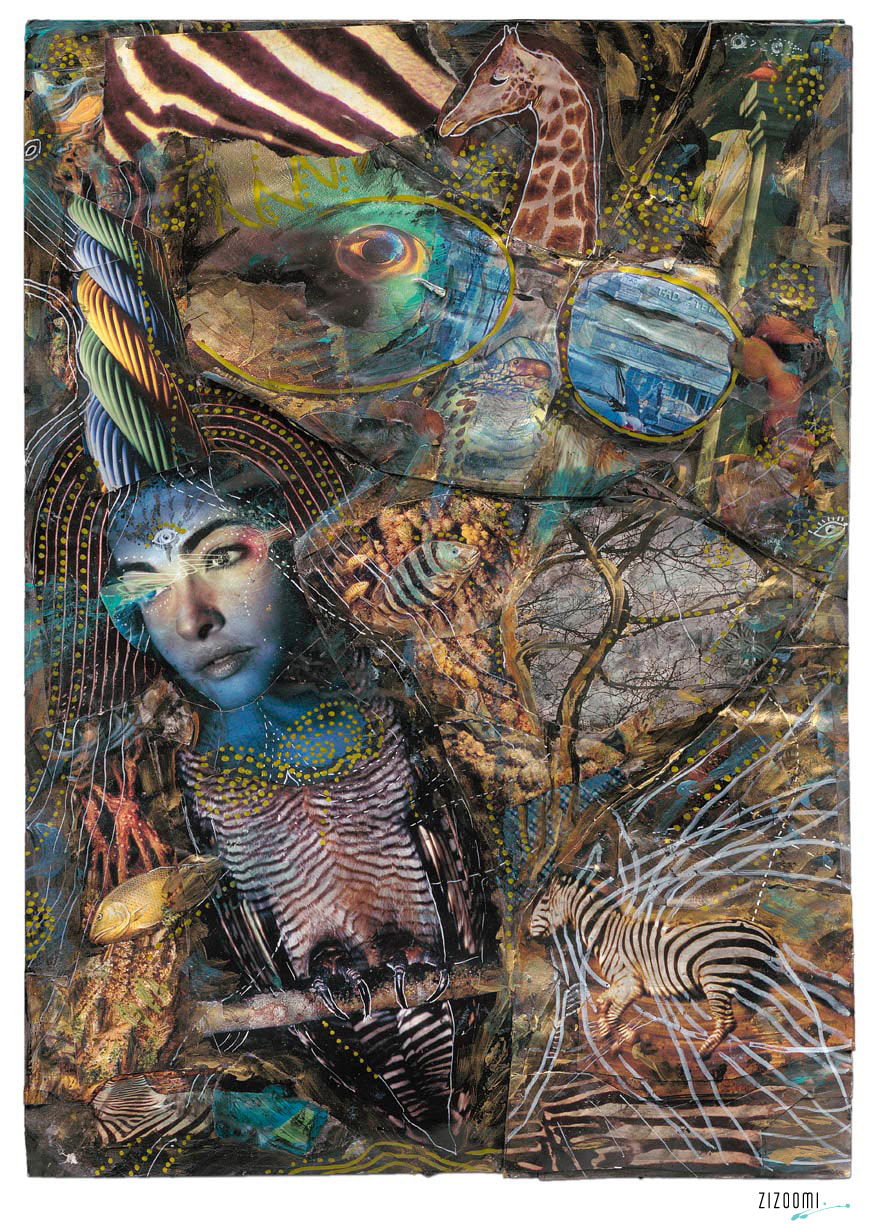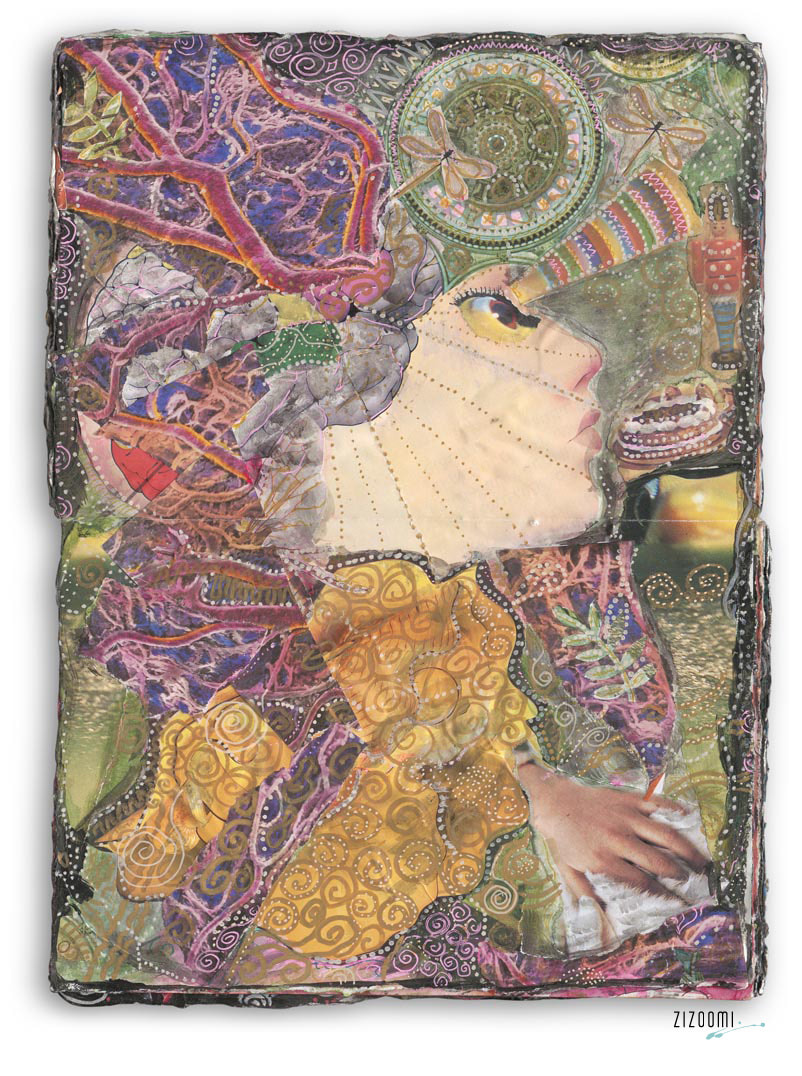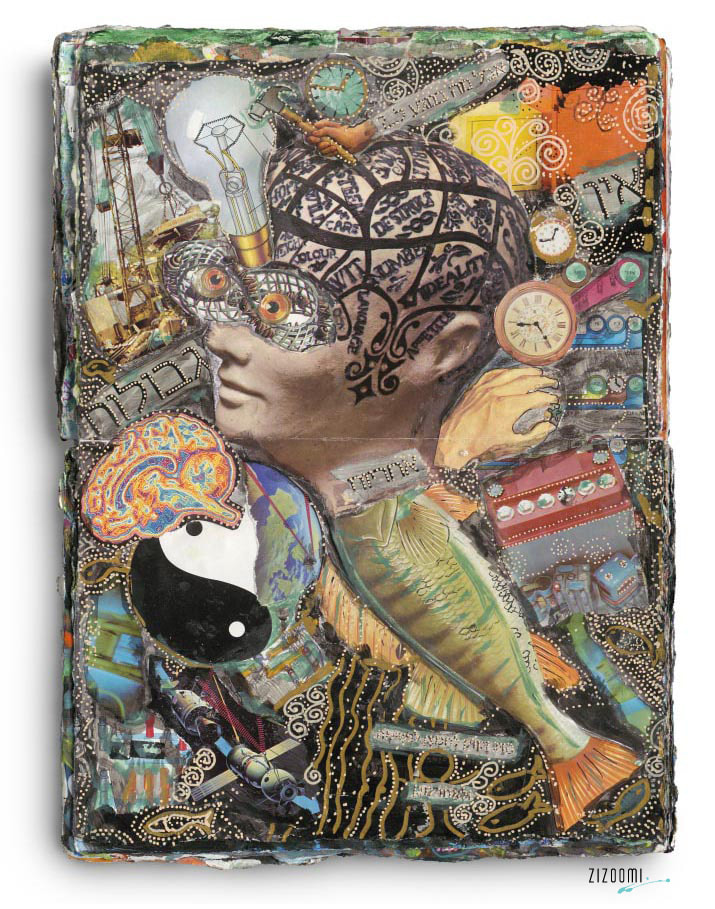Press on the name of each work for symbolism details.
The secret entrance to the labyrinth of time and direction
- Fresco of a woman playing kithara from the Villa of P. Fannius Synistor at Boscoreale, dated 50–40 B.C.
Books – Instead of writing about the symbolism of Books, I choose to Quote John Milton from his ‘Areopagitica’, a speech to the Parliament of England held at 1644 that said:
‘For Books are not absolutely dead things, but do contain a potency of life in them to be as active as that soul was whose progeny they are; nay they do preserve as in a violl the purest efficacy and extraction of that living intellect that bred them’.
The continuing of the above paragraph from the ‘Areopagitica’ is prominently displayed over the entrance to the renovated Main Reading Room of the New York Public Library: "A good Booke is the precious life-blood of a master spirit, imbalm'd and treasur'd up on purpose to a life beyond life".
The Labyrinth holds several different significances. Historically it signified a snare for evil spirits, or the path of worship. In medieval times it represented the central point of the divine and the path of the believer towards it.
In Greek mythology, the labyrinth was built by Daedalus, for Minus, king of the Crete, to ensnare the Minotaur (a half-human, half-bull creature).
Only now, when writhing this, I realized that Theseus the mythical king and founder-hero of Athens, rescued himself out from the labyrinth (Maze) by following the red thread, Ariadne gave him. I knew about the story, but was not aware that it was a red thread. (If it is not enough, I suddenly remembered that while searching for the symbolic meaning of the lilies, I have read somewhere that Images of Lilies dating back to 1580 B.C. were discovered in a villa in Crete). All this is adding more dimensions and connections to this collage.
Unlike Maze, Labyrinth isn’t meant to confuse. There is only one path that travels inwards and outwards again. It is impossible to make a mistake. The walker of the path connects to ancient wisdom and receives the answers and knowledge he needs to proceed upon exiting the labyrinth. Walking the labyrinth therefore becomes a meditative practice. You can also trace the path with your finger or follow it with the eyes to achieve the same effect.
Runes are the letters in a set of related alphabets known as runic alphabets, which were used to write various Germanic languages before the adoption of the Latin alphabet and for specialized purposes thereafter. The Scandinavian variants are also known as futhark (derived from their first six letters of the alphabet: F, U, Þ, A, R, and K). The angular shapes of the runes are shared with most contemporary alphabets of the period that were used for carving in wood or stone.
In Old Irish Gaelic, the word rún means "mystery", "secret", "intention" or "affectionate love." Similarly in Welsh and Old English, the word rhin and rūn respectively means "mystery", "secret", "secret writing", or sometimes in the extreme sense of the word, "miracle". It is possible that the early runes were not used so much as a simple writing system, but rather as magical signs to be used for charms. The name rune itself, taken to mean "secret, something hidden", seems to indicate that knowledge of the runes was originally considered esoteric, or restricted to an elite.
A recent study of runic magic suggests that runes were used to create magical objects such as amulets. In Norse mythology, the runic alphabet is attested to a divine origin.
Masonic Floor - Masonic Mosaic Pavement -
The Mosaic Floor is an important part of Masonic lore. It is a white and black checkered floor. The explanation Freemasons use is that the black and white floor of King Solomon's Temple is reprehensive of the good and evil in every man's life.
The most important to the Freemason is the reminder that good and evil is present in all of our lives should be taken as a reminder and as a warning.
According to Albert Mackey, noted American Masonic historian and scholar the checkered floor - or ‘mosaic pavement’ - is “… an old symbol of the Order. It is met with in the earliest rituals of the last century… Its party-colored stones of black and white have been readily and appropriately interpreted as symbols of the evil and good of human life.”
...from Mackey's Revised Encyclopedia of Freemasonry, 1929: “Mosaic work consists properly of many little stones of different colors united together in patterns to imitate a painting. It was much practiced among the Romans, who called it museum, whence the Italians get their musaico, the French their mosaique, and we our mosaics…"
By a little torsion of historical accuracy, the Freemasons have asserted that the ground floor of the Temple was a mosaic pavement, and hence as the Lodge is a representation of the Temple, that the floor of the Lodge should also be of the same pattern. The mosaic pavement is an old symbol of the Order.
It is met with in the earliest Rituals of the eighteenth century. It is classed among the ornaments of the Lodge in combination with the indented tassel and the blazing star. Its parti-colored stones of black and white have been readily and appropriately interpreted as symbols of the evil and good of human life.
In the first degree of Freemasonry the checkered floor represents the ground floor of King Solomon’s Temple. The checkered flooring represents man’s earthy nature; the good and bad - the yin and yang of man.
The Game Board of Chess resembles to the esoteric life – each step made will determine the adversary to move according to our move and contrary, we will take into account our adversary’s steps. Watching the board game from a Cabalistic point of view, there are 8 squares in one direction and 8 in the other that give the Cabalistic number 8x8=64, 6+4=10, that is the No. 10 in the Arcane in the Tarot, ‘The Wheel of Destiny’. The fight we must take is – white and black combat.
The old Cathedrals, temples, were transmitting this symbol through the model of the floor.
Chess Game
The word ‘CHESS’ derives from the Persian ‘SHAH’ meaning King, the original word is supposed to be ‘ASHA’, The Cosmic Order.
The legend says that King Vishtaspa of Persia became extremely bored by life because he had accomplished everything he had wanted: he was full of triumph in wars, sick of hunting, tired of the intrigues and the pleasures at his court. The King suffered of boredom and finally he offered an unlimited reward to the one who had made him recover his interest for life. It is said that rajah Balhait asked the wise Brahman Sissa to conceive a game in which the power of the mind should be prevailed and not that of fortune. He wanted it to develop the intellect and to have educational valences. Sissa invented a game in which different pieces had to be moved on a square-checkered board formed of 64 squares and it is obvious that this was a forerunner of chess.
The Chess Game transposes cosmic archetypes, truths about the initiatory road and talks about the ingredients necessary to efficiently fight against the Ego. The board game symbolizes the eternal fight against Spirit and matter; good-evil; values-ego; Being-Nonbeing. The black and white squares that alternate on the board and on which we move the pieces show us that step by step we find ourselves in the position to take decisions. We must decide ourselves every moment if we choose the Being or if we deny it. There is the vertical way crossing with the horizontal one. This way the whole life transforms itself in a land of decisions and fights between the White and Black.
The Game Board resembles to the esoteric life – each step made will determine the adversary to move according to our move and contrary, we will take into account our adversary’s steps.
Watching the board game from a Cabalistic point of view, there are 8 squares in one direction and 8 in the other that give the Cabalistic number 8x8=64, 6+4=10 that is the arcane No. 10 ‘The Wheel of Destiny’. The fight we must take is – white and black combat.
Carpet- A carpet indicates royalty and comfort. It pertains to underlying characteristics of an individual's path. In its patterns may be seen real or mythical flowers, trees, beasts and birds. Their patterns evolved from a climate of feelings and beliefs which are often thousands of years old that carry traces of magical powers.
This medium does not allow off too realistic copy... so that the characteristics displayed by the carpets are those of a garden of the mind. Thus, a carpet-weaver actually wrote in a poem about his Garden of Eden, one that is always displayed the blossoms of spring, never to be battered by autumnal gales or winter storms. The carpet sums up the sacred nature and the yearning for the joys of Paradise as the symbolism of the house, his weaver and his owner.
Crocus – Is one of the first flowers to emerge in the spring and as such it is primarily associated with the mirthfulness, glee and youth. There is a claim that the crocus earned its name from the Greek word for thread after the golden fiber of saffron (Saffron comes from the stamens of the crocus flower). From ancient time, because of its color, saffron was associated with magic, love, Sex and Death.
According to Greek legend, Crocus was the name of a Greek noble youth who feel deeply in love with Smilax, a beautiful shepherdess. When the gods forbade his marriage to Smilax, Crocus, in his deep sorrow, killed himself. Upon discovering his death, Smilax could not stop crying. The Goddess Flora took pity on the distraught Smilax and turned them both into plants. Crocus was turned into the crocus flower while Smilax was turned into a vine. It is said that the Greeks used the vines to weave together garlands of crocus flowers as wedding decorations.
The ancient Romans were so fond of the fragrance of the crocus that they devised an apparatus to emit a fine spray of its scent on guests as they entered banquets. The fragrance of the crocus was thought to inspire love was even believed to bloom at midnight on Valentine’s Day.
The Mosaic Floor is an important part of Masonic lore. It is a white and black checkered floor. The explanation Freemasons use is that the black and white floor of King Solomon's Temple is reprehensive of the good and evil in every man's life.
The most important to the Freemason is the reminder that good and evil is present in all of our lives should be taken as a reminder and as a warning.
According to Albert Mackey, noted American Masonic historian and scholar the checkered floor - or ‘mosaic pavement’ - is “… an old symbol of the Order. It is met with in the earliest rituals of the last century… Its party-colored stones of black and white have been readily and appropriately interpreted as symbols of the evil and good of human life.”
...from Mackey's Revised Encyclopedia of Freemasonry, 1929: “Mosaic work consists properly of many little stones of different colors united together in patterns to imitate a painting. It was much practiced among the Romans, who called it museum, whence the Italians get their musaico, the French their mosaique, and we our mosaics…"
By a little torsion of historical accuracy, the Freemasons have asserted that the ground floor of the Temple was a mosaic pavement, and hence as the Lodge is a representation of the Temple, that the floor of the Lodge should also be of the same pattern. The mosaic pavement is an old symbol of the Order.
It is met with in the earliest Rituals of the eighteenth century. It is classed among the ornaments of the Lodge in combination with the indented tassel and the blazing star. Its parti-colored stones of black and white have been readily and appropriately interpreted as symbols of the evil and good of human life.
In the first degree of Freemasonry the checkered floor represents the ground floor of King Solomon’s Temple. The checkered flooring represents man’s earthy nature; the good and bad - the yin and yang of man.
The Game Board of Chess resembles to the esoteric life – each step made will determine the adversary to move according to our move and contrary, we will take into account our adversary’s steps. Watching the board game from a Cabalistic point of view, there are 8 squares in one direction and 8 in the other that give the Cabalistic number 8x8=64, 6+4=10, that is the No. 10 in the Arcane in the Tarot, ‘The Wheel of Destiny’. The fight we must take is – white and black combat.
The old Cathedrals, temples, were transmitting this symbol through the model of the floor.
Chess Game
The word ‘CHESS’ derives from the Persian ‘SHAH’ meaning King, the original word is supposed to be ‘ASHA’, The Cosmic Order.
The legend says that King Vishtaspa of Persia became extremely bored by life because he had accomplished everything he had wanted: he was full of triumph in wars, sick of hunting, tired of the intrigues and the pleasures at his court. The King suffered of boredom and finally he offered an unlimited reward to the one who had made him recover his interest for life. It is said that rajah Balhait asked the wise Brahman Sissa to conceive a game in which the power of the mind should be prevailed and not that of fortune. He wanted it to develop the intellect and to have educational valences. Sissa invented a game in which different pieces had to be moved on a square-checkered board formed of 64 squares and it is obvious that this was a forerunner of chess.
The Chess Game transposes cosmic archetypes, truths about the initiatory road and talks about the ingredients necessary to efficiently fight against the Ego. The board game symbolizes the eternal fight against Spirit and matter; good-evil; values-ego; Being-Nonbeing. The black and white squares that alternate on the board and on which we move the pieces show us that step by step we find ourselves in the position to take decisions. We must decide ourselves every moment if we choose the Being or if we deny it. There is the vertical way crossing with the horizontal one. This way the whole life transforms itself in a land of decisions and fights between the White and Black.
The Game Board resembles to the esoteric life – each step made will determine the adversary to move according to our move and contrary, we will take into account our adversary’s steps.
Watching the board game from a Cabalistic point of view, there are 8 squares in one direction and 8 in the other that give the Cabalistic number 8x8=64, 6+4=10 that is the arcane No. 10 ‘The Wheel of Destiny’. The fight we must take is – white and black combat.
Carpet- A carpet indicates royalty and comfort. It pertains to underlying characteristics of an individual's path. In its patterns may be seen real or mythical flowers, trees, beasts and birds. Their patterns evolved from a climate of feelings and beliefs which are often thousands of years old that carry traces of magical powers.
This medium does not allow off too realistic copy... so that the characteristics displayed by the carpets are those of a garden of the mind. Thus, a carpet-weaver actually wrote in a poem about his Garden of Eden, one that is always displayed the blossoms of spring, never to be battered by autumnal gales or winter storms. The carpet sums up the sacred nature and the yearning for the joys of Paradise as the symbolism of the house, his weaver and his owner.
Crocus – Is one of the first flowers to emerge in the spring and as such it is primarily associated with the mirthfulness, glee and youth. There is a claim that the crocus earned its name from the Greek word for thread after the golden fiber of saffron (Saffron comes from the stamens of the crocus flower). From ancient time, because of its color, saffron was associated with magic, love, Sex and Death.
According to Greek legend, Crocus was the name of a Greek noble youth who feel deeply in love with Smilax, a beautiful shepherdess. When the gods forbade his marriage to Smilax, Crocus, in his deep sorrow, killed himself. Upon discovering his death, Smilax could not stop crying. The Goddess Flora took pity on the distraught Smilax and turned them both into plants. Crocus was turned into the crocus flower while Smilax was turned into a vine. It is said that the Greeks used the vines to weave together garlands of crocus flowers as wedding decorations.
The ancient Romans were so fond of the fragrance of the crocus that they devised an apparatus to emit a fine spray of its scent on guests as they entered banquets. The fragrance of the crocus was thought to inspire love was even believed to bloom at midnight on Valentine’s Day.
Seeds Of Treasures
- Johannes Vermeer, ‘The Art of Painting’ (c. 1666–68) on display in the Kunsthistorisches Museum. Vienna.
The painting depicts an artist painting in his studio and has only two figures, the painter and his subject, a woman. The painter was thought to be a self-portrait of the artist; that sits in front of the painting on the easel, dressed in an elegant black garment with cuts on the sleeves and on the back that offers a glimpse of the shirt underneath. He has short puffy breeches and orange stockings, an expensive and fashionable garment that is also found in other works of the time. Vermeer probably liked this painting that has never been sold during his lifetime.
The artist in Vermeer painting is dressed in black garment showing his white shirt through its cuts, the colors are of Chess Game. The floor is also in black and white, a Masonic Floor.
The Mosaic Floor is an important part of Masonic lore. It is a white and black checkered floor. The explanation Freemasons use is that the black and white floor of King Solomon's Temple is reprehensive of the good and evil in every man's life.
According to Albert Mackey, noted American Masonic historian and scholar the checkered floor - or ‘mosaic pavement’ - is “… an old symbol of the Order. It is met with in the earliest rituals of the last century… Its party-colored stones of black and white have been readily and appropriately interpreted as symbols of the evil and good of human life.” The old Cathedrals, temples, were transmitting this symbol through the model of the floor.
Chess game
The word ‘CHESS’ derives from the Persian ‘SHAH’ meaning King, the original word is supposed to be ‘ASHA’, the Cosmic Order.
The legend says that King Vishtaspa of Persia became extremely bored by life because he had accomplished everything he had wanted: he was full of triumph in wars, sick of hunting, tired of the intrigues and the pleasures at his court. The King suffered of boredom and finally he offered an unlimited reward to the one who had made him recover his interest for life.
It is said that rajah Balhait asked the wise Brahman Sissa to conceive a game in which the power of the mind should be prevailed and not that of fortune. More, he wanted it to develop the intellect and to have educational valences. Sissa invented a game in which different pieces had to be moved on a square-checkered board formed of 64 squares and it is obvious that this was a forerunner of chess.
The Chess Game transposes cosmic archetypes, truths about the initiatory road and talks about the ingredients necessary to efficiently fight against the Ego. The board game symbolizes the eternal fight against Spirit and matter; good-evil; values-ego; Being-Nonbeing. The black and white squares that alternate on the board and on which we move the pieces show us that step by step we find ourselves in the position to take decisions. We must decide ourselves every moment if we choose the Being or if we deny it. There is the vertical way crossing with the horizontal one.
This way the whole life transforms itself in a land of decisions and fights between the White and Black.
The Game Board resembles to the esoteric life – each step made will determine the adversary to move according to our move and contrary, we will take into account our adversary’s steps. Example: if we work on a flaw, it is very possible that he feels threatened and to retire for a period. And if we pass through a period during which an aspect in us moves, our work must orientate towards this Ego.
Watching the board game from a Cabalistic point of view, there are 8 squares in one direction and 8 in the other that give the Cabalistic number 8x8=64, 6+4=10 that is the arcane No. 10 ‘The Wheel of Destiny’. The fight we must take is – white and black combat.
The Bishop in Chess represents the erotic force. It can cross the board diagonally and its moves in a form of the symbolic X. The Cross or the X calls us to crucify the egotistical wishes – as the Apostles of the Gospel wrote. (St. Andrew crucified in X shape).
Sunflower – The English name for the Sunflower is quite literal and taken from its bright sun-like appearance. Its scientific name, Helianthus, is just as literal because it combines the two Greek words for sun and flower.
Because they are facing towards the sun, they are a symbol of optimism and happiness, good fortune, good luck, loyalty and longevity with everlasting faith, adoration, warmth, positivity, power, strength, and happiness.
They are unique in that they have the ability to provide energy in the form of nourishment and vibrancy—attributes which mirror the sun and the energy provided by its heat and light. (During growth, sunflowers tilt during the day to face the sun, but stop once they begin blooming. By the time they are mature, sunflowers generally face east). Because it is slowly moves and travels across the sky each day after the sun, the sunflower appears to worship the sun. That is why many people view this flower as being highly spiritual.
Sunflower heads consist of 500 to 2,000 individual flowers joined together by a receptacle base. Almost all varieties of the Sunflower produce edible seeds (they are in black and white color) with plenty of health benefits.
In Greek mythology, it’s tied to a story of a nymph who becomes the flower after losing her love.
Pumpkin - As the Sunflower that has seeds in it, so does the Pumpkin.
Although the pumpkin has become the modern American symbol of autumn and especially of Halloween, it has a very long history- as once considered a symbol of the whole world, a container of everything ever created. The ancient Inca Empire also used the sunflower as a religious symbol. The giant sunflower was worshipped by the Incas and sunflower seeds were placed at the graves of their dead.
Pumpkins represent abundance and prosperity! The whole pumpkin represents the world we live in now, and is literally filled with blessings waiting to be granted. Each seed represents an opportunity available to you in this life. Pumpkin seeds also represent your dreams.
Apple - the seeds of an apple when it’s cut across (rather than down) form a five-pointed star, or a Pentagram — which was a sacred shape to the pre-Christians (it represented the head, arms, and legs of a human being). In Judaism and Christianity, apples have become associated with the Forbidden Fruit consumed in the Garden of Eden.
Apple/ Red Apple have so many meanings in different cultures throughout history; because I cannot cover it all, I will not write about it.
Grapes - The grapevine is a plant which grows in abundance and the fruit harvested to make wine in which we see the reflection of birth and rebirth. In the mythology of many ancient cultures, the grape, and the grapevine, is regarded as sacred. The symbolic meaning of grapes relate to abundance, transformation and fertility.
Pagans considered grapes as the ‘fruit of the earth”. The Sumerians had several Gods and Goddesses of the vine (Geshtinanna, the goddess of wine). The myths featuring Geshtinanna share a close resemblance to Persephone, the mother of Dionysus, arguably better known by his Roman equivalent, Bacchus. Dionysus’ association with wine represents the intoxicating influence of somebody in a state of illumination, a state of pure bliss, joy and love. Ancient traditions used grapes to reflect the awakening of the soul and the path from disillusion into enlightenment (As Jesus turning water into wine).
Like Persephone from the Greek myths, Geshtinanna spends half the year in the underworld whereby she has authority over the autumn vines and wine. The esoteric meaning of grapevines and wine, therefore, represent the dual nature of man (as represent also in the Black and White colours).
Bowerbird - the master artist of all avian.
The Vogelkop bowerbird (Amblyornis inornata), is a medium-sized, bowerbird of the mountains of the Vogelkop Peninsula at Western New Guinea, Indonesia.
Bowerbird males build beautiful and elaborate nests of sticks or grasses called bowers which are the central feature of their mating ritual. The bower is actually a tunneling structure that creates an illusion of uniformity. These make the males appear much larger than they actually are. The one who creates the best illusions gets the most dates.
Bowerbirds are avid collectors of colorful treasures; some species favor objects colored red and orange while others, exclusively blue. They live up to thirty years and they can spend half a decade building the bower. By this they can serve as a model for us of patience, dedication and the focus of true artistry. Their home decor includes flowers, fungus, deer dung, charcoal, grey stones, bones, feathers, fruit, shells and human materials like plastic, marbles, glass, metals. The birds lay these on top of mossy floors. The bower provides comfort, shelter and safety, along with a place to rendezvous with their lovers.
During spring time, if a female is interested, she will fly from bower to bower, inspecting them from both outside and inside of the avenue. While the female is inside, the male will stand in the court just outside her view and display his prized, brightly colored objects. He will dance a unique and bizarre dance, another display of his artistry and creativity. If she is impressed with him, she will allow him to approach and dance with her.
Bowerbirds can serve as excellent totems for men and woman who are underwhelmed with their own flirtation and courtship skills, or having trouble attracting a mate. They teach us that effort, resilience and innovation is necessary for bringing the beautiful within us out for the entire world to see. We are all attracted to people comfortable enough to dance or move in their bodies, as well as to shiny objects. They show us how to become a shiny being ourselves, in the safety of a nest we have built with our own hands.
Female bowerbird - in interactions tends to teach more about motherhood, and how to be more selective about environment, home, partner, and friendships in order to maximize spiritual nourishment. Female bowerbird can also be integral for teaching one how to learn how to accept.
Male bowerbird -is often more concerned with aesthetics, creation and maintenance of creation, and how to be able to give in more freely way. They also symbolizes accepting and receiving love and gifts, Making something for others, Positive materialism, Care of possessions, Making and decorating a home, Home maintenance, Romance, Luxury, Courtship, Wooing your partner, Celebrating your gifts and the gifts of others.
Gift-giving is an important theme with bowerbird, and consider taking the time to make something for others. Bowerbird teaches us to celebrate our gifts, and the gifts of others, and not just on a material level. The world is filled with gifts; it is up to us to shift our awareness so that we can see it.
The bowerbird has many joyous lessons, but they are still quite a challenge for some people to learn. One of bowerbird's significant lessons is that of accepting and receiving love and gifts. It is not just enough to give, but also important to have the grace and self-acceptance to receive and see yourself as being worthy of the gifts and joy of others. Bowerbird can help you to learn to how to accept joy, positivity and gifts from others while also learning how to accept yourself.
Messages from the Flowers
Bowerbird - the master artist of all avian.
The Vogelkop bowerbird (Amblyornis inornata), also known as the Vogelkop gardener bowerbird, is a medium-sized, bowerbird of the mountains of the Vogelkop Peninsula at Western New Guinea, Indonesia.
Bowerbird males build beautiful and elaborate nests of sticks or grasses called bowers which are the central feature of their mating ritual. The bower is actually a tunneling structure that creates an illusion of uniformity. These make the males appear much larger than they actually are. The one who creates the best illusions gets the most dates.
The Navajo have a concept, “hozho naasha”, which translates as “Walking in Beauty”. They believe that beauty exists within us and around us as the light reflects through a rainbow. They honor the four directions with different colors and objects, just as the Bowerbird lines his home with color and light; the objects could number in the thousands! The rainbow symbolizes communication with the creator and perfection.
Bowerbirds are avid collectors of colorful treasures; some species favor objects colored red and orange while others, exclusively blue. They live up to thirty years and they can spend half a decade building the bower. By this they can serve as a model for us of patience, dedication and the focus of true artistry. Their home decor includes flowers, fungus, deer dung, charcoal, grey stones, bones, feathers, fruit, shells and human materials like plastic, marbles, glass, metals. The birds lay these on top of mossy floors. The bower provides comfort, shelter and safety, along with a place to rendezvous with their lovers.
During spring time, if a female is interested, she will fly from bower to bower, inspecting them from both outside and inside of the avenue. While the female is inside, the male will stand in the court just outside her view and display his prized, brightly colored objects. He will dance a unique and bizarre dance, another display of his artistry and creativity. If she is impressed with him, she will allow him to approach and dance with her.
Bowerbirds can serve as excellent totems for men and woman who are underwhelmed with their own flirtation and courtship skills, or having trouble attracting a mate. They teach us that effort, resilience and innovation is necessary for bringing the beautiful within us out for the entire world to see. We are all attracted to people comfortable enough to dance or move in their bodies, as well as to shiny objects. They shows us how to become a shiny being ourselves, in the safety of a nest we have built with our own hands.
Female bowerbird - in interactions tends to teach more about motherhood, and how to be more selective about environment, home, partner, and friendships in order to maximize spiritual nourishment. Female bowerbird can also be integral for teaching one how to learn how to accept.
Male bowerbird - is often more concerned with aesthetics, creation and maintenance of creation, and how to be able to give more freely. They also symbolizes accepting and receiving love and gifts, Making something for others, Positive materialism, Care of possessions, Making and decorating a home, Home maintenance, Romance, Luxury, Courtship, Wooing your partner, Celebrating your gifts and the gifts of others.
Gift-giving is an important theme with bowerbird, and consider taking the time to make something for others. Bowerbird teaches us to celebrate our gifts, and the gifts of others, and not just on a material level. The world is filled with gifts; it is up to us to shift our awareness so that we can see it.
The bowerbird has many joyous lessons, but they are still quite a challenge for some people to learn. One of bowerbird's significant lessons is that of accepting and receiving love and gifts. It is not just enough to give, but also important to have the grace and self-acceptance to receive and see yourself as being worthy of the gifts and joy of others. Bowerbird can help you to learn to how to accept joy, positivity and gifts from others while also learning how to accept yourself.
Materialism has its downsides, but at the same time, it is also possible to nourish the spirit with positive materialism. Look at the gifts that you have received from others over the years, what is important to you, why is it important, what does it represent? Ask yourself what they reflect about you and your environment. Do they hold memories of the people you love? Or are they just 'objects'?
Bowerbird can come into your life as a shadow aspect to let you know that you're going to lose something or someone important to you if you're not careful. If it's a person, you are not treating them with enough care and romance. It doesn't need to be your partner; it could also be a friend or a work colleague. The shadow energy of bowerbird can, by contrast, demand that you stop being materialistic. Materialism should be cultivated in moderation, often as a way to make us and others feel loved, cared for and happy. Excessive moderation hurts our funds and the people around us, especially if we are spending too much time on material objects and not enough time with real, loving people.
Roller Bird – A single sight of a Roller bird can change your whole life for the better.
In India - The Indian Roller Bird (Neelkanth) is considered to be a pure and sacred bird, as the Indian Roller Bird is representative of God who delivers our prayers and offerings to god. Because of that it is believed that if you see an Indian roller bird it is a sign that your luck is going to change for the better. All gates of your destiny will be open soon and you will have wealth, respect and prosperity etc.
- It increases our wealth.
- Spreads positivity around us.
- Removes all our mental problem and tensions.
- Protects from enemies and evil eyes.
- It represent win of truth over sins.
In Africa - Lilac-Breasted Roller (langazana) - In Western culture, the dove is considered the bird of peace. But in African lore, it is the lilac-breasted roller, the beautiful ‘bird of the sun’, is the bird of peace and reconciliation.
Another belief regarding birds in Africa is that they are the souls of human beings who have reached a high state of perfection. When you have been reincarnated seven times on
Earth, as either a human being or an animal, you are raised by the Gods to the state of a bird, the freest creature in the world; a creature that is a friend to the air ,a friend of the land and friend of the water.
Flowers
Lupine - known also as bluebonnets – they means Imagination in the language of flowers. Albert Einstein had said: “Logic will get you from A to Z. Imagination will get you everywhere”. I hope you will use this collage to connect with the Lupine energy and your imagination.
The lupines are associated with a Native American legend. This is how the Comanche people explain how the Lupine flower was gifted to them.
There was a little girl, She-Who-Is-Alone, whose heart is as big as Texas and whose spirit is as beautiful as the bluebonnet.
She-Who-Is-Alone lived with the Comanche. Their land was suffering from a drought a no matter what the dancers did, there were still no rains. The shaman told the people that the Great Spirits believed that the people had become too selfish and for the rains to return, the Comanche had to offer a burnt sacrifice to the Great Spirits, of their most valued possession. The people wanted to give the offering but each one was sure that his bow or her blanket was not what the Great Spirits wanted. She-Who-Is-Alone knew exactly that the Great Spirits expected the doll she loved so dearly. That night after everyone went to sleep; she went to the fire and offered her doll as a sacrifice. When the ashes cooled, she scattered them to the four corners of the earth. When the tribe arose the next morning, the hillside was covered with blue flowers, a sign of forgiveness from the Great Spirits. As they offered their thanks, the rains came and healed the earth.
Indigenous stories always contain deep wisdom. The lupine is indeed, a plant that brings much healing to earth. Lupine challenges the human soul to greater acts of generosity and selflessness.
Narcissus flower/Daffodils – Daffodils ensure happiness and because it’s one of the earliest bulbs to sprout they are symbol of rebirth and renewal. In Victorian Language of Flowers they implied respect, decorum and devotion. Between lovers they conveyed the message that “you are the only one”.
They are usually considered as a symbol of:
Rebirth and renewal
Good luck and happiness
Prosperity and wealth, especially in the future
Clarity and inspiration
The arrival of spring
Not all of the Narcissus meanings are strictly positive. Due to the association with narcissism the Narcissus does come with negative symbols such as Future misfortune or Narcissism and egotism but they are ideal for reminding that there is always a chance for things to improve in the future. Narcissus flower is a reminder to keep your head high at all times and to never lose faith in the humanity.
Lotus flowers have strong symbolic ties to many Asian religions especially in India. Within Hinduism and Buddhism the lotus flower has become a symbol for awakening to the spiritual reality of life. A lotus represents life in general. As the lotus flower grows up from the mud into an object of great beauty.
Water lily symbol represents the struggle of life at its most basic form. Lotus flower are symbol for people who have gone through a hard time and are now coming out of it. Like these flower they have been at the bottom in a muddy pond, but have risen above this to become an object of beauty or a representation of life of beauty as they might be. Thus a Lotus flower can also represent a hard time in life that has been overcome. The lotus' symbolism changes depending on the number of petals. With eight petals, it represents cosmic harmony; with 1,000 petals it means spiritual revelation.
Donkey - The donkey is an outstanding power animal to have and a skilful master teacher. It is symbolic of versatility, intelligence, eager worker, determination, stubbornness, spiritual dedication, undying faith in the creative force, willingness to take onboard the responsibilities and burdens of others. If anything seems dangerous to them – they absolutely won’t do it. However, this isn’t because they are stubborn, but because they trust, respect and listen to their own intuitive senses. They know their boundaries, what they can and can’t do. They show and remind us how to trust, respect and listen to our own personal intuition also.
The Donkey have big, funnel like ears that can pick up sound a long way off (like, for example, the song of the Nightingale (-:). They know the messages held within each sound, showing us how to listen and awaken our clairvoyant abilities. The donkey is a sign for you to awaken, develop or utilize your own abilities, latent or inherent, in one or more aspects of your life. The donkey ears recall Midas and his “golden touch” – the ability to succeed in any venture. Unlike Midas, the man here, riding on a donkey is not ashamed of his ears, but proud of his ability to listen and his uniqueness.
The Vogelkop bowerbird (Amblyornis inornata), also known as the Vogelkop gardener bowerbird, is a medium-sized, bowerbird of the mountains of the Vogelkop Peninsula at Western New Guinea, Indonesia.
Bowerbird males build beautiful and elaborate nests of sticks or grasses called bowers which are the central feature of their mating ritual. The bower is actually a tunneling structure that creates an illusion of uniformity. These make the males appear much larger than they actually are. The one who creates the best illusions gets the most dates.
The Navajo have a concept, “hozho naasha”, which translates as “Walking in Beauty”. They believe that beauty exists within us and around us as the light reflects through a rainbow. They honor the four directions with different colors and objects, just as the Bowerbird lines his home with color and light; the objects could number in the thousands! The rainbow symbolizes communication with the creator and perfection.
Bowerbirds are avid collectors of colorful treasures; some species favor objects colored red and orange while others, exclusively blue. They live up to thirty years and they can spend half a decade building the bower. By this they can serve as a model for us of patience, dedication and the focus of true artistry. Their home decor includes flowers, fungus, deer dung, charcoal, grey stones, bones, feathers, fruit, shells and human materials like plastic, marbles, glass, metals. The birds lay these on top of mossy floors. The bower provides comfort, shelter and safety, along with a place to rendezvous with their lovers.
During spring time, if a female is interested, she will fly from bower to bower, inspecting them from both outside and inside of the avenue. While the female is inside, the male will stand in the court just outside her view and display his prized, brightly colored objects. He will dance a unique and bizarre dance, another display of his artistry and creativity. If she is impressed with him, she will allow him to approach and dance with her.
Bowerbirds can serve as excellent totems for men and woman who are underwhelmed with their own flirtation and courtship skills, or having trouble attracting a mate. They teach us that effort, resilience and innovation is necessary for bringing the beautiful within us out for the entire world to see. We are all attracted to people comfortable enough to dance or move in their bodies, as well as to shiny objects. They shows us how to become a shiny being ourselves, in the safety of a nest we have built with our own hands.
Female bowerbird - in interactions tends to teach more about motherhood, and how to be more selective about environment, home, partner, and friendships in order to maximize spiritual nourishment. Female bowerbird can also be integral for teaching one how to learn how to accept.
Male bowerbird - is often more concerned with aesthetics, creation and maintenance of creation, and how to be able to give more freely. They also symbolizes accepting and receiving love and gifts, Making something for others, Positive materialism, Care of possessions, Making and decorating a home, Home maintenance, Romance, Luxury, Courtship, Wooing your partner, Celebrating your gifts and the gifts of others.
Gift-giving is an important theme with bowerbird, and consider taking the time to make something for others. Bowerbird teaches us to celebrate our gifts, and the gifts of others, and not just on a material level. The world is filled with gifts; it is up to us to shift our awareness so that we can see it.
The bowerbird has many joyous lessons, but they are still quite a challenge for some people to learn. One of bowerbird's significant lessons is that of accepting and receiving love and gifts. It is not just enough to give, but also important to have the grace and self-acceptance to receive and see yourself as being worthy of the gifts and joy of others. Bowerbird can help you to learn to how to accept joy, positivity and gifts from others while also learning how to accept yourself.
Materialism has its downsides, but at the same time, it is also possible to nourish the spirit with positive materialism. Look at the gifts that you have received from others over the years, what is important to you, why is it important, what does it represent? Ask yourself what they reflect about you and your environment. Do they hold memories of the people you love? Or are they just 'objects'?
Bowerbird can come into your life as a shadow aspect to let you know that you're going to lose something or someone important to you if you're not careful. If it's a person, you are not treating them with enough care and romance. It doesn't need to be your partner; it could also be a friend or a work colleague. The shadow energy of bowerbird can, by contrast, demand that you stop being materialistic. Materialism should be cultivated in moderation, often as a way to make us and others feel loved, cared for and happy. Excessive moderation hurts our funds and the people around us, especially if we are spending too much time on material objects and not enough time with real, loving people.
Roller Bird – A single sight of a Roller bird can change your whole life for the better.
In India - The Indian Roller Bird (Neelkanth) is considered to be a pure and sacred bird, as the Indian Roller Bird is representative of God who delivers our prayers and offerings to god. Because of that it is believed that if you see an Indian roller bird it is a sign that your luck is going to change for the better. All gates of your destiny will be open soon and you will have wealth, respect and prosperity etc.
- It increases our wealth.
- Spreads positivity around us.
- Removes all our mental problem and tensions.
- Protects from enemies and evil eyes.
- It represent win of truth over sins.
In Africa - Lilac-Breasted Roller (langazana) - In Western culture, the dove is considered the bird of peace. But in African lore, it is the lilac-breasted roller, the beautiful ‘bird of the sun’, is the bird of peace and reconciliation.
Another belief regarding birds in Africa is that they are the souls of human beings who have reached a high state of perfection. When you have been reincarnated seven times on
Earth, as either a human being or an animal, you are raised by the Gods to the state of a bird, the freest creature in the world; a creature that is a friend to the air ,a friend of the land and friend of the water.
Flowers
Lupine - known also as bluebonnets – they means Imagination in the language of flowers. Albert Einstein had said: “Logic will get you from A to Z. Imagination will get you everywhere”. I hope you will use this collage to connect with the Lupine energy and your imagination.
The lupines are associated with a Native American legend. This is how the Comanche people explain how the Lupine flower was gifted to them.
There was a little girl, She-Who-Is-Alone, whose heart is as big as Texas and whose spirit is as beautiful as the bluebonnet.
She-Who-Is-Alone lived with the Comanche. Their land was suffering from a drought a no matter what the dancers did, there were still no rains. The shaman told the people that the Great Spirits believed that the people had become too selfish and for the rains to return, the Comanche had to offer a burnt sacrifice to the Great Spirits, of their most valued possession. The people wanted to give the offering but each one was sure that his bow or her blanket was not what the Great Spirits wanted. She-Who-Is-Alone knew exactly that the Great Spirits expected the doll she loved so dearly. That night after everyone went to sleep; she went to the fire and offered her doll as a sacrifice. When the ashes cooled, she scattered them to the four corners of the earth. When the tribe arose the next morning, the hillside was covered with blue flowers, a sign of forgiveness from the Great Spirits. As they offered their thanks, the rains came and healed the earth.
Indigenous stories always contain deep wisdom. The lupine is indeed, a plant that brings much healing to earth. Lupine challenges the human soul to greater acts of generosity and selflessness.
Narcissus flower/Daffodils – Daffodils ensure happiness and because it’s one of the earliest bulbs to sprout they are symbol of rebirth and renewal. In Victorian Language of Flowers they implied respect, decorum and devotion. Between lovers they conveyed the message that “you are the only one”.
They are usually considered as a symbol of:
Rebirth and renewal
Good luck and happiness
Prosperity and wealth, especially in the future
Clarity and inspiration
The arrival of spring
Not all of the Narcissus meanings are strictly positive. Due to the association with narcissism the Narcissus does come with negative symbols such as Future misfortune or Narcissism and egotism but they are ideal for reminding that there is always a chance for things to improve in the future. Narcissus flower is a reminder to keep your head high at all times and to never lose faith in the humanity.
- It is recommended to present them in a bunch – because when given as a single bloom, it can foretell misfortune.
Lotus flowers have strong symbolic ties to many Asian religions especially in India. Within Hinduism and Buddhism the lotus flower has become a symbol for awakening to the spiritual reality of life. A lotus represents life in general. As the lotus flower grows up from the mud into an object of great beauty.
Water lily symbol represents the struggle of life at its most basic form. Lotus flower are symbol for people who have gone through a hard time and are now coming out of it. Like these flower they have been at the bottom in a muddy pond, but have risen above this to become an object of beauty or a representation of life of beauty as they might be. Thus a Lotus flower can also represent a hard time in life that has been overcome. The lotus' symbolism changes depending on the number of petals. With eight petals, it represents cosmic harmony; with 1,000 petals it means spiritual revelation.
Donkey - The donkey is an outstanding power animal to have and a skilful master teacher. It is symbolic of versatility, intelligence, eager worker, determination, stubbornness, spiritual dedication, undying faith in the creative force, willingness to take onboard the responsibilities and burdens of others. If anything seems dangerous to them – they absolutely won’t do it. However, this isn’t because they are stubborn, but because they trust, respect and listen to their own intuitive senses. They know their boundaries, what they can and can’t do. They show and remind us how to trust, respect and listen to our own personal intuition also.
The Donkey have big, funnel like ears that can pick up sound a long way off (like, for example, the song of the Nightingale (-:). They know the messages held within each sound, showing us how to listen and awaken our clairvoyant abilities. The donkey is a sign for you to awaken, develop or utilize your own abilities, latent or inherent, in one or more aspects of your life. The donkey ears recall Midas and his “golden touch” – the ability to succeed in any venture. Unlike Midas, the man here, riding on a donkey is not ashamed of his ears, but proud of his ability to listen and his uniqueness.
- Bronze Carriage Disc with Legendary Creature from Pagliata, Chieti,
- century BC. The National Archaeological Museum, Abruzzo, Italy
- The Daffodils are from a photograph taken by Shay Ginot.
- The Donkey photograph was taken by Isaac Movshovitz
Heavenly Music Between Two Points
Longings, thoughts and prays, shaking strings in our soul, are playing Heavenly Music that awakes us while filling the gapes and cracks of the soul and the infinite space between every two points.
Lace - Lace is a very delicate fabric made of yarn tor thread with a lot of holes in it. It is a symbol of woman work. Lace takes its symbolism from weaving, the thread and cord, the loom and the web. It is a representation of the person being part of the Great. Historically, it was made by hand, using a laborious process that required time and skill. This made such an extravagance that for many centuries it was a privilege of the aristocracy. Lace is an ‘openwork’ fabric that features open spaces. Through these spaces are revealed whatever is underneath. But the purpose of a lace veil is to conceal parts of the body that are normally on show. Different colored lace can symbolize either sophistication or naïveté.
Ducks - Wild Ducks – Ducks symbolize many things and are connected with the spiritual world. They are comfortable in water, on the ground and in the air. They walk, fly or swim. Not only they represent the balance between those, but symbolically they also connect Earth and heavens. Because of their various capabilities, ducks are believed to be able to travel between the realms of spiritual forces and the world of our reality, between the astral and the material world. It is believed they can communicate between the physical universe and the mystical spiritual spheres.
Ducks are generally benevolent and relaxed. They live in flocks and groups and do not like to be alone. They are friendly towards one another and they do not attack other creatures.
A flying duck symbolizes freedom. A flying wild duck symbolizes relief of bad feelings and troubles. It is a sign that your problems and worries are soon to be gone or resolved.
Wagtail has a joyful spirit that reminds us to be playful, spirited and child-like. When life feels heavy, we can look to a wagtail to see that life doesn’t have to be so serious all the time.
The wagtail offers us the gift of reconnecting with our own essence, our purpose, our soul and our connection to all that is divine. It reminded us of the importance of staying grounded, and of the childhood memories of having fun, playing, dancing and singing.
Remembering and returning to these ancient practices of pure happiness, we will be able to see the innocence, the essence and the beauty in life that we wish to preserve.
Dot or Point - the beginning of any visual symbol is the dot or point. Before anything else can be created, a dot must be made. The dot is a symbol of the self and beginning. It is also an illustration of the act of creation, because the creation of the dot itself is the act of creating something in a space which previously contained nothing.
Line is a symbol of boundary and division. A straight line represents infinity because it can continue in either direction indefinitely. A vertical line symbolizes the spiritual world, and a horizontal line the temporal.
Spiral - the spiral occurs often in nature. Maybe because of that its shape has been used in sacred art and it can be traced back to the most primitive societies,. Spiral has been one of the most used shapes in religious and magical symbolism. The spiral represents anything that expands and contracts: the rising and setting Sun, waxing and waning of the Moon, the seasons, and life and death. It symbolizes the movement of consciousness towards the inner understanding of the Oneness of the All. An inward spiral, clockwise, represents the focusing and projection of an intention, like a prayer. The outward spiral, counter-clockwise, represents fulfillment of the intention, God's answer.
Square - The square is a symbol of stability, honesty, justice, shelter and safety; limitation, security, and permanence. The four sides of the square represent quaternary concepts: the elements: air, fire, water, and earth; the seasons: spring, summer, winter, and fall; the motions: linear, vibratory, rotary, and mixed; four-letter names of God, the archangels: Michael, Gabriel, Raphael, and Ariel; the directions: -north, south, east, and west, and many other quaternary concepts.
Purple as a color means royalty, power and confidence. It relates to the imagination and spirituality. It stimulates the imagination and inspires high ideals. It is an introspective color, allowing us to get in touch with our deeper thoughts. Purple and violet color represents the future, the imagination and dreams, while spiritually calming the emotions. They inspire and enhance psychic ability and spiritual enlightenment, while, at the same time, keeping us grounded.
Purple and violet promote harmony of the mind and the emotions, contributing to mental balance and stability, peace of mind, a link between the spiritual and the physical worlds, between thought and activity.
Golden Frame
Angel
Wagtail (bird)
Orchid
Peony
Violet
Gladiolus
Donkey
Music
Notes
Dance, Spiral, dots and lines, clock, Time, Light, Window, Stairs, Look, Gaze, Glance…
Black and white
Pink
Purple
Original size: 63/46cm
- The woman with downcast eye holding a trumpet and a book, is either Pheme from the Greek mythology that was described as "she who initiates and furthers communication" or Clio, the Muse of History painted by Johannes Vermeer in, The Art of Painting (c. 1666–68)
- The Angels are from Rafael paintings. The tow Putti, known as ‘The Sistine Cherubs’ are from the ‘The Sistine Madonna’. The other Angel is from ‘The Triumph of Galatea’ also by Raphael.
Lace - Lace is a very delicate fabric made of yarn tor thread with a lot of holes in it. It is a symbol of woman work. Lace takes its symbolism from weaving, the thread and cord, the loom and the web. It is a representation of the person being part of the Great. Historically, it was made by hand, using a laborious process that required time and skill. This made such an extravagance that for many centuries it was a privilege of the aristocracy. Lace is an ‘openwork’ fabric that features open spaces. Through these spaces are revealed whatever is underneath. But the purpose of a lace veil is to conceal parts of the body that are normally on show. Different colored lace can symbolize either sophistication or naïveté.
Ducks - Wild Ducks – Ducks symbolize many things and are connected with the spiritual world. They are comfortable in water, on the ground and in the air. They walk, fly or swim. Not only they represent the balance between those, but symbolically they also connect Earth and heavens. Because of their various capabilities, ducks are believed to be able to travel between the realms of spiritual forces and the world of our reality, between the astral and the material world. It is believed they can communicate between the physical universe and the mystical spiritual spheres.
Ducks are generally benevolent and relaxed. They live in flocks and groups and do not like to be alone. They are friendly towards one another and they do not attack other creatures.
A flying duck symbolizes freedom. A flying wild duck symbolizes relief of bad feelings and troubles. It is a sign that your problems and worries are soon to be gone or resolved.
Wagtail has a joyful spirit that reminds us to be playful, spirited and child-like. When life feels heavy, we can look to a wagtail to see that life doesn’t have to be so serious all the time.
The wagtail offers us the gift of reconnecting with our own essence, our purpose, our soul and our connection to all that is divine. It reminded us of the importance of staying grounded, and of the childhood memories of having fun, playing, dancing and singing.
Remembering and returning to these ancient practices of pure happiness, we will be able to see the innocence, the essence and the beauty in life that we wish to preserve.
Dot or Point - the beginning of any visual symbol is the dot or point. Before anything else can be created, a dot must be made. The dot is a symbol of the self and beginning. It is also an illustration of the act of creation, because the creation of the dot itself is the act of creating something in a space which previously contained nothing.
Line is a symbol of boundary and division. A straight line represents infinity because it can continue in either direction indefinitely. A vertical line symbolizes the spiritual world, and a horizontal line the temporal.
Spiral - the spiral occurs often in nature. Maybe because of that its shape has been used in sacred art and it can be traced back to the most primitive societies,. Spiral has been one of the most used shapes in religious and magical symbolism. The spiral represents anything that expands and contracts: the rising and setting Sun, waxing and waning of the Moon, the seasons, and life and death. It symbolizes the movement of consciousness towards the inner understanding of the Oneness of the All. An inward spiral, clockwise, represents the focusing and projection of an intention, like a prayer. The outward spiral, counter-clockwise, represents fulfillment of the intention, God's answer.
Square - The square is a symbol of stability, honesty, justice, shelter and safety; limitation, security, and permanence. The four sides of the square represent quaternary concepts: the elements: air, fire, water, and earth; the seasons: spring, summer, winter, and fall; the motions: linear, vibratory, rotary, and mixed; four-letter names of God, the archangels: Michael, Gabriel, Raphael, and Ariel; the directions: -north, south, east, and west, and many other quaternary concepts.
Purple as a color means royalty, power and confidence. It relates to the imagination and spirituality. It stimulates the imagination and inspires high ideals. It is an introspective color, allowing us to get in touch with our deeper thoughts. Purple and violet color represents the future, the imagination and dreams, while spiritually calming the emotions. They inspire and enhance psychic ability and spiritual enlightenment, while, at the same time, keeping us grounded.
Purple and violet promote harmony of the mind and the emotions, contributing to mental balance and stability, peace of mind, a link between the spiritual and the physical worlds, between thought and activity.
Golden Frame
Angel
Wagtail (bird)
Orchid
Peony
Violet
Gladiolus
Donkey
Music
Notes
Dance, Spiral, dots and lines, clock, Time, Light, Window, Stairs, Look, Gaze, Glance…
Black and white
Pink
Purple
Original size: 63/46cm
The Great Mother
- Venus of Willendorf
- Ornaments from Nablus (Schem) Mosaic Floor from a roman villa, photograph by Zev Radovan
- The “Mona Lisa of the Galilee” (possibly Venus), from Sepphoris, also known as Diocaesarea, Near Nazareth, Israel. Detail from the mosaic in the House of Dionysus depicting scenes from the life of Dionysus and his cult.
- Musician playing an angular harp, bronze cauldron decoration, 12th-11th century BC from Cyprus, London, British Museum.
- The Tholos of Delphi 380-370 BC.
- Mosaic of the Zodiac Wheel, the Beth Alpha synagogue, the sixth-century AD
- Mortar and pestle from (the mound) of the Biblical city of Gezer, (a Canaanite City and Royal Solomonic City), Israel.
- An impression of a seal from 4th BC depicting Dumuzid bringing presents from nature to Inanna.( Dumuzid the ancient Mesopotamian god associated with shepherds and the primary consort of the goddess Inanna the "Queen of Heaven” the ancient Mesopotamian Goddess associated with love, beauty, sex, desire, fertility, war, justice, and political power (later known as Ishtar).
- Ivory carving of Astarte the goddess of love, fertility and motherhood in Mesopotamia and Canaan. (Astarte is the Greek form of the name Ashtart, who, along with Asherah and Anath, was one of the three great goddesses of the Canaanite pantheon).
- The Angel is from ‘The Triumph of Galatea’ by Raphael.
- Detail from a lintel in an ancient synagogue in the Golan, Israel, with a Menorah the Ancient Seven-armed Candelabrum.
- I do not know where the picture of the bear is taken from. If someone knows, I will appreciate if you will let me know so I add it here.
- A Sufi Dervish whirling dancer. I have no details on this picture either and will appreciate any details so I could add it here too.
Venus of Willendorf is a small Paleolithic stone sculpture that might be an image of a prehistoric Mother Goddess found in Austria; and now is in the Naturhistorisches Museum in Vienna. This figure is believed to have been carved during the "Old Stone Age", a period of prehistory starting around 30,000 BCE. Similar sculptures that had been discovered are traditionally referred as "Venus figurines" due to the widely-held belief that depictions of nude women with exaggerated sexual features represented an early fertility fetish or a mother goddess. The reference to Venus is metaphorical, since the figurines predate the mythological figure of Venus by many thousands of years.
Mother goddess – Professor Marija Gimbutas (a Lithuanian-American archeologist and anthropologist) had proven to the world what Plato said, that all we have to do is Remember… based on archeological findings, she helped us “remember” that the primordial deity for our ancestors was female, a self generating goddess That the early societies were matrilineal society, Mothers Societies and the world most ancient religion was of The Goddess Religion.
The Mother Goddess is a specific source of vitality. Variety of feminine deities and maternal symbols in hundreds of figurines showing of creativity, birth, fertility, sexual union, nurturing, and the cycle of growth that were found in archeological sights. The term also has been applied to figures as diverse as the so-called Stone Age Venuses and the Virgin Mary. A major form of the mother goddess emphasizes her maternity. She is the protector who nourished of a divine child and all humanity.
In my Work of Art I refer to the Mother Goddesses and the Earth Mother (a cosmogonic figure, the eternally fruitful source of everything) as one, even if they are not the same. At those ancient times, Mankind (and women) was not separated from nature. They had an animistic and holistic way of thinking that was reflected in the connection between Mother Goddess and Nature. The Mother Goddess could therefore appear as a woman or in other form of nature such as animal, like cow, fish, pig, snake, water bird, bear or a tree that was the protector of the universe.
The Bear has been an important connection to the Force of Life. In many cultures the bear is consider as half animal, half human. In the northern countries, like the Sami people, as in Finland, Russia, Ainu tribe and some deities in the Celtic Gaul and Britain, the Mother Goddess was a Bear Goddess; and in some of them, the Ursa Major Was, and might still be, its representation. The Finno-Ugric culture saw themselves as the “people under the big bear” referring to the Ursa Major stars.
Mother Bear was The ‘Mother of All Mothers’ and the Northern Star, her navel. )Bear mother continue the cycle of life by giving birth to its cubs in the cold winter, taking care of them under the Northern Star). All women are actually like the bear mother, keeping the ancient and sacred Cycle of Life.
The Triple Goddess - neo-paganism suggests a guiding toward deep understanding of the three phases of woman: the Maiden, the Mother and the Crone, also Known as The Triple Goddess. That symbolizes both a separate stage in the female life cycle and a phase of the moon, and often rules one of the realms of earth, underworld, and the heavens. It is the subject of much of the writing of Robert Graves, and has been adopted by many neo-pagans as one of their primary deities. The term Triple Goddess is also used as refer to historical goddess triads and single goddesses of three forms or aspects.
Embroidery - The signification of the embroiderer of embroidery (one of woman’s handicrafts) is a memory-knowledge that is connected to the Thread of Life and destiny. This symbolism contains a hidden meaning with a purpose in it. The ornamentation was, and might steel be, a coded pattern that serves as a charm. Some of the ornaments protect from trouble, others, representing the Great Mother, were for good luck and prosperity. As traditional embroidery they hold pagan roots and are a symbol of fertility. Embroidery was considered to be a ritual, conducted on certain days, channeling positive energy and protection to the woman itself and her family into the work.
- More information about the connection between woman’s handwork and the Mother Goddess and moreover between Woman and Bear, can be found in a wonderful essay ‘Dreaming, Bear Spirit, and Finno-Ugric Women’s Handicrafts’ written by Irma Heiskanen in the amazingly smart book: “Wo(men) and Bears The Gift of Nature, Culture and Gender Revisited” edited by Kaarina Kalio, Published in Canada, by Inanna Publication and Education inc.
Stork symbolism: Motherhood, Good luck, Purity, Fidelity, Renewal, Creativity and more.
Original size: 63/46cm
The Ancient Way of the Labyrinth
- Venus of Willendorf
The figure is believed to have been carved during the "Old Stone Age", a period of prehistory starting around 30,000 BCE. Similar sculptures that had been discovered are traditionally referred as "Venus figurines" due to the widely-held belief that depictions of nude women with exaggerated sexual features represented an early fertility fetish or perhaps a mother goddess. The reference to Venus is metaphorical, since the figurines predate the mythological figure of Venus by many thousands of years.
Mother goddess - is a specific source of vitality. a variety of feminine deities and maternal symbols of creativity, birth, fertility, sexual union, nurturing, and the cycle of growth. The term also has been applied to figures as diverse as the so-called Stone Age Venuses and the Virgin Mary. A major form of the mother goddess emphasizes her maternity. She is the protector who nourished of a divine child and all humanity.
In my Work of Art I refer to the Mother Goddesses and the Earth Mother (a cosmogonic figure, the eternally fruitful source of everything) as one, even if they are not the same.
Elephant –signifies the connection to Mother Earth, fertility, ancient wisdom, memory, gentleness and endless patience.
According to shamans the elephant is a guiding toward deep understanding of the three phases of woman: the Maiden, the Mother and the Crone that symbolizes both a separate stage in the female life cycle and a phase of the moon, and often rules one of the realms of earth, underworld, and the heavens.
The Maiden, Mother and Crone are also Known as the Triple Goddess. It is the subject of much of the writing of Robert Graves, and has been adopted by many neo-pagans as one of their primary deities. The term triple goddess is infrequently used outside of Neo-paganism to instead refer to historical goddess triads and single goddesses of three forms or aspects.
The elephant society is a matriarch society in which the oldest female in that family is the leader of the herd. Elephant families revolve around females. Males leave at puberty and become socially independent, but females remain within their families for their whole lives. They rear their calves alongside their mothers, grandmothers, sisters and aunts. Family members take their cues from the matriarch – as the leader, her decisions influence their life and behavior. If family members want to do something different from the matriarch, they will have to leave the family for a while and catch up later. Since old females have a lot of experience in getting the most from the environment, it usually profits the rest of the members to follow her lead.
Matriarchs lead their families away from dangers such as predators, and older matriarchs are better at responding appropriately to threats. Matriarch Elephants Mother shape the daily lives of family members, and by doing so affect their general health and body condition, and therefore influence their survival and their reproductive success.
Recent study suggests experience of old matriarchs and perhaps their memories of distant, life-sustaining sources of food and water, may be the key to survival during the worst of times and help herds survive in age of climate change.
Elephants with their gentle spirit symbolize the qualities of wisdom, strength, courage, longevity, patience, honor, stature and connectedness. When an elephant is arriving to your life it is a sign to seek for harmony in your herd. It is helpful to have an elephant with you when you are in a need for strength. When an elephant is making an appearance to your life it represents a new relationship with the sacred feminine in all of its aspects.
They were believed to be the creators of clouds, most probably because of their form and color. As by being linked to the clouds they can help in finding messages from the divine as well as secrets and esoteric knowledge.
The elephant is an important figure in Indian religion and mythology. In the Hindu theology Elephants are associated with rain and water in the mythology of Indra (the God of Rain and Thunderstorms). The Hindus worship Ganesha, a deity having a human form and the head of an elephant. Lord Ganesha's role in Hindu theology states him to be the remover of all obstacles.
The Labyrinth holds several different significances. Historically it signified a snare for evil spirits, or the path of worship. In medieval times it represented the central point of the divine and the path of the believer towards it.
In Greek mythology, the labyrinth was built by Daedalus, for Minus, king of the Crete, to ensnare the Minotaur (a half-human, half-bull creature).
Only now, when writhing this, I realized that Theseus the mythical king and founder-hero of Athens, rescued himself out from the labyrinth (Maze) by following the red thread, Ariadne gave him. I knew about the story, but was not aware that it was a red thread. (If it is not enough, I suddenly remembered that while searching for the symbolic meaning of the lilies, I have read somewhere that Images of Lilies dating back to 1580 B.C. were discovered in a villa in Crete). All this is adding more dimensions and connections to this collage.
Unlike Maze, Labyrinth isn’t meant to confuse. There is only one path that travels inwards and outwards again. It is impossible to make a mistake. The walker of the path connects to ancient wisdom and receives the answers and knowledge he needs to proceed upon exiting the labyrinth. Walking the labyrinth therefore becomes a meditative practice. You can also trace the path with your finger or follow it with the eyes to achieve the same effect.
Runes are the letters in a set of related alphabets known as runic alphabets, which were used to write various Germanic languages before the adoption of the Latin alphabet and for specialized purposes thereafter. The Scandinavian variants are also known as futhark (derived from their first six letters of the alphabet: F, U, Þ, A, R, and K).
Original size: 63/46cm
Left, Right, Black & White, Dancing to the Mystery Music in the Jungle of Life
Zebra - Things are never as simple as black or white. Everything has to find balance in the world. The Zebra symbolizes your unique understanding of the world around you – knowing that not everything is simply black or white, right or wrong, good or bad. Its symbol reminds that there is more than one way of looking at things. It is a calling for us to open our eyes to new ideas and new ways of resolving problems. Zebra is a symbol of finding balance and fairness in all resolutions.
The Zebra and the Flamingo are also a symbol of working in a group. It is a reminder to us of being part of a team with balance in life as in work.
Flamingo - standing on one foot, always part of a group. It symbolizes balance, Joy and happiness. It shows you the importance of your emotions and the way of the free expression of them, good and stable relationship, community and cooperation, intuition. Showing you the way and teaches you how to be optimistic, believing you can achieve your goals, no matter how unreachable they might seem. It symbolizes of some new experiences that are coming ahead and much more.
This supper food comes from trees. All are used as food, medicine and more. Moringa and Baobab growing in Africa and they are not part of a jungle, but they are in my “Jungle of Life”.
Moringa (Moringa Oleifera) is called "the tree that never dies” or the "Tree of Life" with its nickname as a ‘Miracle Tree’. Moringa trees have a list of medicinal, nutritive, and practical uses that are second to none. The symbolism attached to the tree signifies life, growth, and change. Every part of the tree is said to have beneficial properties that can serve humanity.
The Baobab Tree:
Adansonia Digitata (Upside-Down Tree) is the largest succulent plant in the world that absorbs and stores water in its huge trunk. It is Africa's Iconic "Tree of Life" that has a central part of traditional legend and lore. It was believed that kings and elders would hold their meetings under a Baobab tree, with a belief that the tree's spirits would guide them in decision-making. Traditional African animist spiritual belief incorporates the Earth’s natural provenance, and infuses it with ritual. Like so, for the Otammari people of northern Benin, Baobabs represent ancient settlements, and the spirits of their ancestral owners become part of the trees.
Baobabs have numerous health and anti-oxidant benefits and can be seen as a complete food source. Almost every part of the tree is useful, which makes it a product of nature utilised extensively for the best benefit of man and animal.
The cocoa tree
The cacao plant, the source of chocolate, is actually a medicine that has mythological importance to indigenous tribes of Mexico. Cacao beans were associated with wisdom and magical power. In Maya times, drinking chocolate was one of the privilege of high status individuals as it was considered Food of the Gods. The Aztecs chocolate drink, xocolatl, was primarily consumed during tribal ceremonies or prayer. Their god Quetzalcoatl, "Quetzal-feathered Serpent", was related to gods of the wind, planet Venus, dawn, merchants, arts, crafts and knowledge. He wanted his people to be healthy and well fed, dedicate to improve themselves to be the best they could, studious, knowledgeable, generous and artistically talented. So he stole the cocoa tree form heavens, brought it to earth and planted it in Tula, Mexico for his people.
* (Thank you “Aduna”- an Africa-inspired health food brand and social enterprise, for the Coco, Moringa and Baobab powder).
Original size: 45/60cm (each piece)
The Zebra and the Flamingo are also a symbol of working in a group. It is a reminder to us of being part of a team with balance in life as in work.
Flamingo - standing on one foot, always part of a group. It symbolizes balance, Joy and happiness. It shows you the importance of your emotions and the way of the free expression of them, good and stable relationship, community and cooperation, intuition. Showing you the way and teaches you how to be optimistic, believing you can achieve your goals, no matter how unreachable they might seem. It symbolizes of some new experiences that are coming ahead and much more.
This supper food comes from trees. All are used as food, medicine and more. Moringa and Baobab growing in Africa and they are not part of a jungle, but they are in my “Jungle of Life”.
Moringa (Moringa Oleifera) is called "the tree that never dies” or the "Tree of Life" with its nickname as a ‘Miracle Tree’. Moringa trees have a list of medicinal, nutritive, and practical uses that are second to none. The symbolism attached to the tree signifies life, growth, and change. Every part of the tree is said to have beneficial properties that can serve humanity.
The Baobab Tree:
Adansonia Digitata (Upside-Down Tree) is the largest succulent plant in the world that absorbs and stores water in its huge trunk. It is Africa's Iconic "Tree of Life" that has a central part of traditional legend and lore. It was believed that kings and elders would hold their meetings under a Baobab tree, with a belief that the tree's spirits would guide them in decision-making. Traditional African animist spiritual belief incorporates the Earth’s natural provenance, and infuses it with ritual. Like so, for the Otammari people of northern Benin, Baobabs represent ancient settlements, and the spirits of their ancestral owners become part of the trees.
Baobabs have numerous health and anti-oxidant benefits and can be seen as a complete food source. Almost every part of the tree is useful, which makes it a product of nature utilised extensively for the best benefit of man and animal.
The cocoa tree
The cacao plant, the source of chocolate, is actually a medicine that has mythological importance to indigenous tribes of Mexico. Cacao beans were associated with wisdom and magical power. In Maya times, drinking chocolate was one of the privilege of high status individuals as it was considered Food of the Gods. The Aztecs chocolate drink, xocolatl, was primarily consumed during tribal ceremonies or prayer. Their god Quetzalcoatl, "Quetzal-feathered Serpent", was related to gods of the wind, planet Venus, dawn, merchants, arts, crafts and knowledge. He wanted his people to be healthy and well fed, dedicate to improve themselves to be the best they could, studious, knowledgeable, generous and artistically talented. So he stole the cocoa tree form heavens, brought it to earth and planted it in Tula, Mexico for his people.
* (Thank you “Aduna”- an Africa-inspired health food brand and social enterprise, for the Coco, Moringa and Baobab powder).
Original size: 45/60cm (each piece)
|
Alchemy - A Glow From Inside of The Cosmic Egg
I cannot plane a collage ahead. Starting to work on it I had no idea where it is going to and what or if it will be a collage in the end. Only after the collage was finished, I was surprised to discover the egg shape that comes out. In my opinion this surprise raises the symbolic meaning of it all (I’ll be glad to hear your opinion). For me it is a symbol of the Cosmic Egg. Only now, when I am writing about the symbolic meaning, everything connects, like a chain. Things that I knew nothing about the connection between them or their meaning suddenly became clear why they found their way to this work and why are here. As I always say, I am learning the meaning of each collage and the hidden messages in it only when I am writing about its symbolism. Because this work had so many symbols in it, I will write only about part of them. Alchemists aimed also to create an elixir of immortality; creation of panaceas able to cure any disease; and the development of an alkahest, a universal solvent. Since gold, either physical or spiritual, is the goal of alchemy it is synonymous with the philosopher's stone. In alchemy, as in nature, nothing is gained except through the lost or death of something else; death and resurrection are central themes of alchemical thought. Bread – Bread has significance beyond mere nutrition in many cultures because of its history and contemporary importance. It is also significant in Christianity as one of the elements (alongside wine) of the Eucharist. The word companion comes from Latin com- "with" + panis "bread". Because it has exceptional nutritional value, Bread occupies an important place in every civilization. It is deeply associated with the symbolism of wheat. Mythology and ritual representation identified with plant life because the mystery of human birth and death was in many respects similar to the life cycle of plants. During its life cycle the grain of wheat dies and then reborn months later in the form of a spike capable of providing sustenance to human beings. Wheat was believed to contain the mystery of life and death and became a sacred plant. As Women's fertility was associated with the fertility of the earth. Because of their knowledge of the mystery of creation, women were responsible for the abundance of the harvest. The production of bread was associated with procreation. The process of loading, baking, and unloading the oven parallels copulation, pregnancy, and childbirth.This sacred and divine dimension of the wheat spike helped associate it with the symbolism of resurrection since ancient times in Egyptian goddess Isis and Osiris, the god of the underworld. Cereal plants were associated with divinities in nearly all cultures, such as the Greek goddess Demeter and the Roman goddess Ceres. In the Old Testament wheat and bread are symbols of the fecundity of the earth. In imperial Rome woman (and bakers) were celebrated the Vestalia , in the Temple of Vesta, from 7 - 15 June. It was a Roman religious festival in honor of Vesta, the goddess of the hearth and the burning continuation of the sacred fire of Rome. Domestic and family lives were represented by the festival of the goddess of the house and of the spirits of the store chamber - Vesta and the Penates - on Vestalia. On the first day of festivities the penus Vestae (sanctum sanctorum of the temple of Vesta which was usually curtained off) was opened, for the only time during the year, at which women offered sacrifices. As long as the curtain remained open, mothers could come, barefoot and disheveled, to leave offerings to the goddess in exchange for a blessing to them and their family Vesta represents the sacred flame and high Priestess energy. In pre-Hellenic times she was associated with unmarried temple priestesses who acted as channels for descent of the Moon goddess during sacred sexual rites. These priestesses healed through sexual energy as well as more traditional herbs and were thought to be the first surgeons and doctors in ancient times. She represents our capacity to integrate and focus our energy and the capability to bring wholeness to ourselves. Her energy is the sacred feminine creative energy which allows us to regenerate and dedicate ourselves to our aspirations, plans and goals. As the Guardian of the sacred flame Vesta is connected to the joy and passion within our own soul, representing the Fire of spirit. She holds the ability of teaching us how to “renew ourselves”, how to arise from the ashes and reborn in another form. She teaches us how to cleanse, repair and revitalize our bodies and our minds. Chameleon - represents our connection to the hidden world, shape shifting and intuition. She possesses endless patience, and knows exactly the right moment to move. When life seems frightening, we are wise to listen to the lizard – to connect to our intuition, to weigh each step and to wait patiently for the right moment. The change will come. The chameleon changes her colors, adapting herself to changing surroundings. She teaches us to be more flexible in our thoughts and not to fear change. Rather, we should accept changing circumstances and adapt to them. We must adapt ourselves to the rhythm of life by being attentive to our inner rhythm. Transformation is symbolized here in the chameleon, the color grey and the season of autumn. The Cosmic Egg - is a mythological motif found in the creation myths of many cultures and civilizations. Typically, it is a beginning of some sort, and the universe or some primordial being comes into existence by "hatching" from the egg. Crocodile - has existed since the dawn of time. He represents time, magic, quickness, respect, healthy survival instincts, bravery, creation, creativity and more. We see only his eyes; his body is hidden. He waits patiently for the right opportunity. Crown – The Iron Crown of Lombardy - It was made in the 4th or 5th century. It was used for the coronation of the kinks of Italy between the 11th -14th century. Analysis made to this crown show that 85% of it is gold, 5-7% is silver and the rest are copper. The crown contains no iron. Feather: When a feather crosses your path, it represents a greeting from the Great Spirit, as well as freedom, inspiration, and the journey of the soul and spirit. In various cultures there is a place of honor for feathers that blow in on the wind and the mystic significance they bring with them. The feathers themselves are used as decoration, adornment and symbolize connection to the divine. Reminiscent of wings, they connect us to ideas of protection, love and rebirth. The connection to birds reminds us of spiritual journeys and freedom. To find a feather is a message of love from the universe sent across time and space. Fox – symbolizes of cleverness, cunning, intelligence, observation, stealth, camouflage, invisibility, diplomacy, deception, persistence, patience, swiftness, adaption, wisdom, unpredictability and creation. With its flamlike red coat it has transformative qualities of fire itself. The fox as a luminal animal can live in wild forests and in cultivated farms. Beliefs around the world are dealing with its transformational abilities, as he can change itself into human. As so, he can guide us between animal, human and the spirit world, between conscious and the unconscious. Gold - Gold is the most precious of all metals. In alchemy gold was the goal of the process, the transmutation of base metals as lead and copper into silver or gold. In many cultures the Sun is associated with or represents gold. In orthodox Christianity gold symbolizes the perfection and the light of heaven. Scales - Scales are usually symbolic in terms of the Scales of Justice; they are balance, equality, justice, and harmony. Symbolizes that “as above, so below”. Golden Chain (In Latin calena aurea), in ancient times was considered as a link between Heaven and Earth. Pears - Fruit-bearing trees are symbols of physical and spiritual nourishment and fertility. They have been central to religion and culture dating back to the biblical reference of Adam and Eve and the "tree of life." While the symbolism associated with pear trees varies slightly from culture to culture, in some form, it invariably stands for life and longevity. Fertility The shape of the pear is suggestive of the feminine form. As such, it has wide influence as a symbol of feminine sexuality and fertility. As a result, it also represents motherhood. Because it can produce fruits for decades, the pear tree also represents longevity and comfort. In Christianity, the pear tree frequently appears in connection with Jesus Christ and alludes to His love for mankind. It epitomizes the Christian promise of salvation and eternal life. Pomegranate – The pomegranate fruit has been used throughout history and in virtually every religion as a symbol of humanity’s central beliefs and ideals, namely, life and death, rebirth and eternal life, fertility and marriage, and abundance. In Ancient Greek mythology, the pomegranate features prominently in the story of Persephone and her marriage to Hades, the god of the Underworld. Hades kidnapped Persephone and took her to the Underworld to be his wife. Persephone’s mother, Demeter, goddess of fertility, considering her daughter lost, went into mourning and thus all things on earth ceased to grow. Zeus, Persephone’s father, commanded his brother Hades to release her, however Hades had tricked her into eating six pomegranate seeds, and it was the rule of the Fates that anyone who consumed food or drink in the Underworld was doomed to spend eternity there. Since Persephone had eaten the six pomegranate seeds, she had to remain in the Underworld for six months of the year. Hades agreed to release her to the world above for the other six months of the year, to be reunited with her mother. This is how the ancient Greeks explained the cycle of the seasons: when Persephone was with her mother, the earth flourished and the crops grew (Spring and Summer); when she returned to Hades, Demeter mourned and the earth was infertile (Autumn and Winter). As a consequence, pomegranates were often offered to the goddess Demeter in prayer for fertile land. (Alexandra Hamburger for It’s All Greek). Snake – The serpent, or snake, is one of the oldest and most widespread mythological symbols. Snakes have been associated with some of the oldest rituals known to humankind and represent dual expression of good and evil. Historically, serpents and snakes represent fertility or a creative life force. As snakes shed their skin through sloughing, they are symbols of rebirth, transformation, immortality, and healing. When forming a ring with its tail in its mouth, the snake is like the Ouroboros a symbol of the "All-in-All", the totality of existence, infinity and the cyclic nature of the cosmos acts as a symbol of eternity and continual renewal of life. Serpents are connected with poison and medicine and are represented as potent guardians of temples and sacred spaces. They are also connected with vengefulness and vindictiveness. The language of flowers - sometimes called floriography, is a means of crypto logical communication through the use or arrangement of flowers. Meaning has been attributed to flowers for thousands of years, and some form of floriography has been practiced in traditional cultures throughout Europe, Asia, and the Middle East. The renewed Victorian era interest in the language of flowers finds its roots in Ottoman Turkey, specifically the court in Constantinople and an obsession it held with tulips during the first half of the 18th century. Interest in floriography soared in Victorian England and in the United States during the 19th century. The floriography craze was introduced to Europe by two people: Englishwoman Mary Wortley Montagu (1689–1762), who brought it to England in 1717, and Aubry de La Mottraye (1674–1743), who introduced it to the Swedish court in 1727. Gifts of blooms, plants, and specific floral arrangements were used to send a coded message to the recipient, allowing the sender to express feelings which could not be spoken aloud in Victorian society. Armed with floral dictionaries, Victorians often exchanged small "talking bouquets", called nosegays or tussie-mussies, which could be worn or carried as a fashion accessory. The significance assigned to specific flowers in Western culture varied — nearly every flower had multiple associations, listed in the hundreds of floral dictionaries — but a consensus of meaning for common blooms has emerged. Often, definitions derive from the appearance or behavior of the plant itself. Flowers are also often used as a symbol of femininity Rose - was an icon of veneration in the pre-Christian era, and was used in ancient Rome to symbolize devotion to the goddess Venus. The deep red rose and its thorns have been used to symbolize both the blood of Christ and the intensity of romantic love while Pink rose imply a lesser affection. For alchemists, the entire process of psychic transformation takes place under the rose (Sub Rosa) as Red and white rose elude the “love affair” and “marriage” of opposite natures as understanding and realization of psychic process to the silence of the womb, or the “rose” within. Tulip - Tulips were considered as symbols of love and romance, but they can have many other symbolic meanings. The meaning of tulips is generally is a perfect love. But Tulips has several other meanings. Some of them are: Perfection and love, Passionate love, Royalty, Neglected love, Prosperity, abundance and indulgence or Supporting the less fortunate. Different colors of tulips often carry their own significance. Purple Color was always a symbol of royalty, wealth and nobility. It is also a symbol of extravagance, independence and devotion and can also be used to express admiration for a loved one’s accomplishments. Artichoke- The artichoke symbolizes hope for a prosperous future. Because it has a heart at his core it also represents Love. So it becomes a symbol of love and hope for successful future relationships. Mallow – A traditional symbol of gentleness or mildness. |
The Lunar Eclipse
The Moon with its three stages is called triple moons. They are linked to the meaning of the three aspects of a woman’s life and symbolize the Maiden, Mother, and Crone, connecting to renewal and cycles that are in every man and woman’s life as in the world. As such, triple moons also symbolize change. The “maiden, mother and crone” is called the “Triple Goddess” and as the never-ending circles is popular in the Celtic symbolism. Waxing Crescent Moon = Maiden Full Moon = Mother Waning Crescent Moon = Crone The Moon symbolizes: Femininity, Women, Fertility, Growth, Creativity, Transformation, Illumination, Change, Shadows, Balance, Emotions, Intuition and Inner Knowledge. Isis - The daughter of the earth god Geb and the sky goddess Nut, was one of the most important deities of ancient Egypt. She was the goddess of marriage, fertility, motherhood, magic medicine and nature that hold the powers of transformation (remind us what the moon symbolizes). Most often she was represented as a beautiful woman wearing a sheath dress and either the hieroglyphic sign of the throne or a solar disk and cow’s horns on her head. In my opinion the solar disk with the cow’s horns can also be recognized as the sign of the “Triple Goddess”; so by wearing it, Isis, the woman goddess can be looked as if she represent, not only the sun, but its opposite, the Moon in his three stages and the stages in woman’s life. So not only Hecate and Artemis are connected to the Moon, but Isis too. Isis was known for her cunning and her magical power, which enabled her to revive Osiris and to protect and heal her son Horus. That is why she is connected to the life cycle and revival. As mourner, she was a principal deity in rites connected with the dead; as magical healer, she cured the sick and brought the deceased to life; and as mother, she was a role model for all women. By virtue of her magical knowledge, she was said to be "cleverer than a million gods". The Frog generally represents transformation, change, and stages of development. In Chinese culture, the frog represents good luck and the feminine "yin" energy. In the Celtic tradition, the frog is responsible for bringing the purifying and healing rains. Hence, the frog comes to represent purification and healing as well. Orchids are associated with fertility and sexuality they also represents love, luxury, beauty, strength and refinement. In ancient Greece, they were associated with virility. White orchids symbolize innocence and purity, as well as elegance and reverence. |
Good Morning Ms. Button. Have You Seen an Angel Passing By?
This collage is a Labyrinth of knots, connections, relationships, communication, magic and belief. It was made with hundreds of buttons I have made out of cardboard, thanks to Martha Stewart’s button punch (thank you Ms. Stewart!!!). It can tell different stories as much as the numbers of its viewers. I wish you will let yourself being creative and kind enough to share your story, (the one that come up to you while watching it) with me and other readers. I thank you for it in advance.
This is an expanded collage. Its name indicates that the morning is the time of this occurrence, a Time of Beginnings; while bringing in it the unseen and raising some other questions.
Someone that apparently knows Ms Button is asking this question. Is it asked with a kind of humor or because of knowing Ms. Butten and her abilities to notice an angel in this earthly surrounding? Ms. Button’s cat, (what’s his name?) surprisingly looking outside the garden. Is it the angel he is looking at? The cat’s gaze can be interpreted as if he is looking at the angel standing where you, the viewer, are.
This person asking the question is looking at Ms. Button, who is looking at her cat, looking at you watching this and maybe the angel too. As the buttons are connected by the red thread, so are all of those glances connected with one another as we, all human beings and everything else does.
So many buttons are in it. They grow in Ms. Button garden; they are in her name, as an ornament on her dress, her apron and so on. I did so many of them till my hand hurt. Even so, after the collage was done, I looked at it from a distance, and realized that no matter what, I have to make more buttons and hang them down. Only now, after doing this research about the symbolic meaning in it, I understand why I did so.
In the beginning of this writing, I thought only that the Red Thread is connecting Ms. Button garden to the Labyrinth. This writing allows me to think deeper and understand much better what’s in it. Now I realize that everything else in this collage is also connected. The Labyrinth, the spinning wheel, the Red Thread, Ms. Buttons, her Lilies, her cat, the Angel, they all are symbols of connection between worlds. Birth, fate and death, associated with lunar and feminine qualities are connected in it too.
Ms. Button is connected to Holda (Frau Holle) and Perchta (Frau Perchta) both known as goddesses who oversaw spinning and weaving. She is the Great Mother; she is Freyja, the goddess of fertility; the Moon Goddess, and the Great Magician who connects it all, including us people to the divine and to one another.
So, who is the angel? The answer is left unknown, as the angel. Yet, you can complete the story; as you are part of this story. Are you the angel?
As they are so many, I chose to write only about part of the symbols in this collage. There are more to look for if you are interested in going further and deeper.
Cat - Cats represent cleverness, wisdom, selectivity, mysteriousness, intuition, independence and the supernatural have. From the times of ancient Egypt they were beheld as holy creatures they have been significant in various cultures. The moon goddess of Egypt, who wore a cat ornament on her head, was widely revered. In her honor, cats were mummified with mice for them to eat in the next world. In ancient Greece, cats represented Diana, the goddess of the moon and were believed to protect the home. In Nordic mythology a cat pulled the chariot of Freyja.
The Labyrinth holds several different significance. Historically it signified a snare for evil spirits, or the path of worship. In medieval times it represented the central point of the divine and the path of the believer towards it.
In Greek mythology, the labyrinth was built by Daedalus, for Minus, king of the Crete, to ensnare the Minotaur (a half-human, half-bull creature).
Only now, when writhing this, I realized that Theseus the mythical king and founder-hero of Athens, rescued himself out from the labyrinth (Maze) by following the red thread, Ariadne gave him. I knew about the story, but was not aware that it was a red thread. (If it is not enough, I suddenly remembered that while searching for the symbolic meaning of the lilies, I have read somewhere that Images of Lilies dating back to 1580 B.C. were discovered in a villa in Crete). All this is adding more dimensions and connections to this collage.
Unlike Maze, Labyrinth isn’t meant to confuse. There is only one path that travels inwards and outwards again. It is impossible to make a mistake. The walker of the path connects to ancient wisdom and receives the answers and knowledge he needs to proceed upon exiting the labyrinth. Walking the labyrinth therefore becomes a meditative practice. You can also trace the path with your finger or follow it with the eyes to achieve the same effect.
Our goal in the Labyrinth of Life, the Labyrinth of the Red Thread, is to figure out how we navigate our way in order to find the right path for us, our path. Who we connect to, which buttons we use (or press?), so we could follow it through times and changes. This Labyrinth helps us to gain confident, assure and to trust our way by connecting us to our will, our dreams and to one another.
Original size: 100/60cm
This is an expanded collage. Its name indicates that the morning is the time of this occurrence, a Time of Beginnings; while bringing in it the unseen and raising some other questions.
Someone that apparently knows Ms Button is asking this question. Is it asked with a kind of humor or because of knowing Ms. Butten and her abilities to notice an angel in this earthly surrounding? Ms. Button’s cat, (what’s his name?) surprisingly looking outside the garden. Is it the angel he is looking at? The cat’s gaze can be interpreted as if he is looking at the angel standing where you, the viewer, are.
This person asking the question is looking at Ms. Button, who is looking at her cat, looking at you watching this and maybe the angel too. As the buttons are connected by the red thread, so are all of those glances connected with one another as we, all human beings and everything else does.
So many buttons are in it. They grow in Ms. Button garden; they are in her name, as an ornament on her dress, her apron and so on. I did so many of them till my hand hurt. Even so, after the collage was done, I looked at it from a distance, and realized that no matter what, I have to make more buttons and hang them down. Only now, after doing this research about the symbolic meaning in it, I understand why I did so.
In the beginning of this writing, I thought only that the Red Thread is connecting Ms. Button garden to the Labyrinth. This writing allows me to think deeper and understand much better what’s in it. Now I realize that everything else in this collage is also connected. The Labyrinth, the spinning wheel, the Red Thread, Ms. Buttons, her Lilies, her cat, the Angel, they all are symbols of connection between worlds. Birth, fate and death, associated with lunar and feminine qualities are connected in it too.
Ms. Button is connected to Holda (Frau Holle) and Perchta (Frau Perchta) both known as goddesses who oversaw spinning and weaving. She is the Great Mother; she is Freyja, the goddess of fertility; the Moon Goddess, and the Great Magician who connects it all, including us people to the divine and to one another.
So, who is the angel? The answer is left unknown, as the angel. Yet, you can complete the story; as you are part of this story. Are you the angel?
As they are so many, I chose to write only about part of the symbols in this collage. There are more to look for if you are interested in going further and deeper.
Cat - Cats represent cleverness, wisdom, selectivity, mysteriousness, intuition, independence and the supernatural have. From the times of ancient Egypt they were beheld as holy creatures they have been significant in various cultures. The moon goddess of Egypt, who wore a cat ornament on her head, was widely revered. In her honor, cats were mummified with mice for them to eat in the next world. In ancient Greece, cats represented Diana, the goddess of the moon and were believed to protect the home. In Nordic mythology a cat pulled the chariot of Freyja.
The Labyrinth holds several different significance. Historically it signified a snare for evil spirits, or the path of worship. In medieval times it represented the central point of the divine and the path of the believer towards it.
In Greek mythology, the labyrinth was built by Daedalus, for Minus, king of the Crete, to ensnare the Minotaur (a half-human, half-bull creature).
Only now, when writhing this, I realized that Theseus the mythical king and founder-hero of Athens, rescued himself out from the labyrinth (Maze) by following the red thread, Ariadne gave him. I knew about the story, but was not aware that it was a red thread. (If it is not enough, I suddenly remembered that while searching for the symbolic meaning of the lilies, I have read somewhere that Images of Lilies dating back to 1580 B.C. were discovered in a villa in Crete). All this is adding more dimensions and connections to this collage.
Unlike Maze, Labyrinth isn’t meant to confuse. There is only one path that travels inwards and outwards again. It is impossible to make a mistake. The walker of the path connects to ancient wisdom and receives the answers and knowledge he needs to proceed upon exiting the labyrinth. Walking the labyrinth therefore becomes a meditative practice. You can also trace the path with your finger or follow it with the eyes to achieve the same effect.
Our goal in the Labyrinth of Life, the Labyrinth of the Red Thread, is to figure out how we navigate our way in order to find the right path for us, our path. Who we connect to, which buttons we use (or press?), so we could follow it through times and changes. This Labyrinth helps us to gain confident, assure and to trust our way by connecting us to our will, our dreams and to one another.
Original size: 100/60cm
Listening to the Nightingale
- The woman figure is from Rubens painting ‘Cephalus and Procris’.
- The two Infant satyrs are taken from Botticelli’s painting ’Venus and Mars’.
- The two Angels and the angel on the donkey are Rafael paintings. The tow Putti or ‘The Sistine Cherubs’ in ‘The Sistine Madonna’. The other Angel is from ‘The Triumph of Galatea’ by Raphael.
- The mail figure is from a fresco by Michelangelo, ‘Ignudi’ (The Naked), the Sistine Chapel Ceiling, c.1510.
- The garden near the female figure is photograph by Yael Pinkus.
- The Daffodils are from a photograph taken by Shay Ginot.
- The Donkey photograph was taken by Isaac Movshovitz
Nightingale is an important symbol for the poets from a variety of ages. It is probably the most lyrical of all birds and may have 300 different love songs. The male will sing for its 'mate' all through the night a beautiful and varied song. As such it is symbolic to those who are able to sing spells and who have a command of the song lines of the universe. That’s why it is a symbol for a spiritually gifted person.
Nightingale’s wisdom also includes using vibration energy to see in a shadow. It has a connection to using song in healing to our souls and hearts and also, with a strong connection to the moon, using of song in moving through fear. Music heals the wounds in our lives and soothes our spirit. Music tends to change our emotions depending on the kind of music we listen to. When you listen to love music, you get emotions related to love; you actually start feeling the love.
Nightingale sings at night when it is dark. A time that is associated with danger because of the darkness. That is why Nightingale also teaches us that we can use songs to move through fear in life. Because of their sight that is meant to work effectively at night, they also portray a connection to the moon.
Nightingale shows up when...
- You feel hurt.
- You need to be emotionally stable.
- You have some fear.
- You need to overcome your fears.
- When you need to see some invisible things.
- You need music to provide healing.
- You have to be very active.
- You need to remain active even at night.
- You feel discouraged.
Donkey - The donkey is an outstanding power animal to have and a skilful master teacher. It is symbolic of versatility, intelligence, eager worker, determination, stubbornness, spiritual dedication, undying faith in the creative force, willingness to take onboard the responsibilities and burdens of others. If anything seems dangerous to them – they absolutely won’t do it. However, this isn’t because they are stubborn, but because they trust, respect and listen to their own intuitive senses. They know their boundaries, what they can and can’t do. They show and remind us how to trust, respect and listen to our own personal intuition also.
The Donkey have big, funnel like ears that can pick up sound a long way off (like, for example, the song of the Nightingale (-:). They know the messages held within each sound, showing us how to listen and awaken our clairvoyant abilities. The donkey is a sign for you to awaken, develop or utilize your own abilities, latent or inherent, in one or more aspects of your life.
Narcissus flower/Daffodils are usually considered as a symbol of:
Rebirth and renewal
Good luck and happiness
Prosperity and wealth, especially in the future
The arrival of spring
Clarity and inspiration
Daffodils ensure happiness and because it’s one of the earliest bulbs to sprout they are symbol of rebirth and renewal. In Victorian Language of Flowers they implied respect, decorum and devotion. Between lovers they conveyed the message that “you are the only one”. Not all of the Narcissus meanings are strictly positive. Due to the association with narcissism the Narcissus does come with negative symbols such as Future misfortune or Narcissism and egotism but they are ideal for reminding that there is always a chance for things to improve in the future. Narcissus flower is a reminder to keep your head high at all times and to never lose faith in the humanity.
It is recommended to present them in a bunch – because when given as a single bloom, it can foretell misfortune.
White lily - Is mainly a symbol of Virgin Mary’s purity but also a symbol of majesty too. The white lily with its huge pistil is the epitome of beauty. Based on a Roman legend, it was Venus who made this pistil grow from the lily’s center. Jealous of the beauty the lily has, she decided to mar its “perfection” with a huge pistil.
According to the Roman myth white lilies came from the queen of the gods. While she was nursing her baby (Hercules), some of the milk from her breast fell to earth. Along its path, it formed the Milky Way and the drops that fell on the ground turned to white lilies. Another version of this story tells about how Hercules got his god like strength.
White Lilies is known as the best way to convey the message of having the feeling of being in heaven with someone, like being "on cloud 9”.
Ficus tree - it is believed that Buddha was sitting under Udaumbara tree (Ficus Glomerata) when he became enlightened. That is why this tree and or fruit may carry the connotation of Vedic mysticism in Buddhist literature.
The Magic of the Unicorn and the Thread of Life
Putti,/Putto - in the ancient classical world of art, were winged infants that were believed to influence human lives as traditional symbols of love. They originally were limited to profane passions in symbolism of art. In Renaissance art, the form of the putto was derived in various ways including the Greek Eros or Roman Amor/Cupid, the god of love and companion of Aphrodite or Venus; the Roman, genius, a type of guardian spirit; or sometimes the Greek, daemon, a type of messenger spirit, being halfway between the realms of the human and the divine.
The iconography of putti is deliberately unfixed, so that it is difficult to tell the difference between putti, cupids, and various forms of angels. They have no unique, immediately identifiable attributes, so that putti may have many meanings and roles in the context of art. Some of the more common associations are with Aphrodite, and so with romantic - or erotic—love; with Heaven; peace, prosperity, mirth, and leisure.
The Unicorn - is a legendary creature that has been described since antiquity as a beast with a single large, pointed, spiraling horn projecting from its forehead. It was believed that its horn holds magical and medicinal properties.
They are strongly associated with the feminine and as such have traditionally appeared as a symbol of chastity, the divine power that nurtures all living things, and an emblem of the word of divine presence. They often considered the most wondrous of all mythical creatures. It is a symbol of innocence, feminine energy, magic, miracles, and enchantment. The magical and enchanting unicorn appears to only a rare few and has the ability to bestow magic, miracles and wisdom to those who are pure of heart and virtuous in their deeds. Nowadays, the unicorn is strongly associated with vibrant imagination and a sense of wonder.
Venus - The goddess of gardens and vineyards in Roman mythology. She is parallel to Aphrodite, the goddess of love and beauty in Greek mythology. In the Renaissance and Romantic periods, the idea of love was connected to beauty. Venus appears often in artworks, acting out the myths about Aphrodite.
The Three Graces – The Charites (another name for the graces) were ladies-in-waiting to Venus, the goddess of love and beauty. Their names were Aglaea, meaning “splendor”, Euphrosyne, meaning “mirth” and Thalia, meaning “cheerfulness”. The name “The Charites” has its roots in the Greek word “charisma”, meaning magic. In Roman mythology, they were referred to as “the three graces”. Their job, as the goddesses of beauty, grace, fertility, art and music, is to bestow their talents, grace and inspiration upon artists and craftsmen. Another member of Aphrodite’s entourage was her son, God of Love, Cupid/Eros/Amor. He was born out of chaos. His job was to shoot either golden or lead arrows into the hearts of men and women. A golden arrow stirred love in the heart of the stricken man; a leaden arrow awoke jealousy or hatred in a man's heart.
Cheetah - The exquisite nature of elegance, grace and deep inner knowledge. The reflection of the warrior goddess who knows her strengths and devotes a lifetime to the art of developing and mastering her natural abilities while knowing her weaknesses. Cheetahs get tired easily, they are fast but not good for long distance, and their body can’t keep up with their speed. This represents that we must learn to relax after experiencing stress and fatigue. We must never over-do things or over-use our energies. Cheetah also possesses the commendable ability to feel and react swiftly to the harm of others. They also represent the struggle and the pain we have to take before achieving success.
Cheetah's has agility and Flexibility, concentration, friendship, ambiguity, ability to be attentive on something for a short time, speed, confidence, and sharp eye. They need to stay vigilant to all chance and harm.
Candle - Candles are often used during religious and ritualistic ceremonies. They symbolizes light in the darkness of life especially individual life, it is the symbol of holy illumination of the spirit of truth. Light is everywhere the symbol of joy and of life-giving power, as darkness is of death and destruction. The flame represents the source of our creation, your inner light. Candles and sacred flames are part of the myth and mystery of humanity's experience in the physical, always a reminder of our connection to source.
Distaff and Spindle – the symbols of life and the temporal and so is related to the Moon, a symbol expressing the transitoriness of life. The mythological meaning of the distaff is first of all dependent on its function – spinning, which was a woman’s activity. Female symbolism is always marked in the rites of the cycle of life and the word “distaff” has been used since the 14th century as a symbol of women’s work. When saying the “distaff side” it represents the female side of the family.
In the maternity rite a girl’s navel was cut on the spin, for the girl to be a good spinner. Spinning as a means of creating a new structure had a mythological meaning. Threads made in a special way were used in traditional medicine. Thread by itself could be read as “threads of fate” – for example in the interpretation of dreams to tear or to cut a thread meant imminent death. The symbolism of spinning gave magic qualities to the distaff. Thus on the First day of Lent women usually rode the base like sledged to “grow good flax”; they put the small distaff next to a baby’s cradle to ward off the evil eye.
- Venus figure and the Putti are from ‘The Toilet of Venus’, François Boucher, 1751, the Metropolitan Museum of Art, New York.
- Venus figure and the Three Graces are from ‘Primavera’, by Sandro Botticelli
- Angels – one Angel is of the tow Putti or ‘The Sistine Cherubs’ in ‘The Sistine Madonna’ by Raphael. The other Angel is from ‘The Triumph of Galatea’ also by Raphael.
Putti,/Putto - in the ancient classical world of art, were winged infants that were believed to influence human lives as traditional symbols of love. They originally were limited to profane passions in symbolism of art. In Renaissance art, the form of the putto was derived in various ways including the Greek Eros or Roman Amor/Cupid, the god of love and companion of Aphrodite or Venus; the Roman, genius, a type of guardian spirit; or sometimes the Greek, daemon, a type of messenger spirit, being halfway between the realms of the human and the divine.
The iconography of putti is deliberately unfixed, so that it is difficult to tell the difference between putti, cupids, and various forms of angels. They have no unique, immediately identifiable attributes, so that putti may have many meanings and roles in the context of art. Some of the more common associations are with Aphrodite, and so with romantic - or erotic—love; with Heaven; peace, prosperity, mirth, and leisure.
The Unicorn - is a legendary creature that has been described since antiquity as a beast with a single large, pointed, spiraling horn projecting from its forehead. It was believed that its horn holds magical and medicinal properties.
They are strongly associated with the feminine and as such have traditionally appeared as a symbol of chastity, the divine power that nurtures all living things, and an emblem of the word of divine presence. They often considered the most wondrous of all mythical creatures. It is a symbol of innocence, feminine energy, magic, miracles, and enchantment. The magical and enchanting unicorn appears to only a rare few and has the ability to bestow magic, miracles and wisdom to those who are pure of heart and virtuous in their deeds. Nowadays, the unicorn is strongly associated with vibrant imagination and a sense of wonder.
Venus - The goddess of gardens and vineyards in Roman mythology. She is parallel to Aphrodite, the goddess of love and beauty in Greek mythology. In the Renaissance and Romantic periods, the idea of love was connected to beauty. Venus appears often in artworks, acting out the myths about Aphrodite.
The Three Graces – The Charites (another name for the graces) were ladies-in-waiting to Venus, the goddess of love and beauty. Their names were Aglaea, meaning “splendor”, Euphrosyne, meaning “mirth” and Thalia, meaning “cheerfulness”. The name “The Charites” has its roots in the Greek word “charisma”, meaning magic. In Roman mythology, they were referred to as “the three graces”. Their job, as the goddesses of beauty, grace, fertility, art and music, is to bestow their talents, grace and inspiration upon artists and craftsmen. Another member of Aphrodite’s entourage was her son, God of Love, Cupid/Eros/Amor. He was born out of chaos. His job was to shoot either golden or lead arrows into the hearts of men and women. A golden arrow stirred love in the heart of the stricken man; a leaden arrow awoke jealousy or hatred in a man's heart.
Cheetah - The exquisite nature of elegance, grace and deep inner knowledge. The reflection of the warrior goddess who knows her strengths and devotes a lifetime to the art of developing and mastering her natural abilities while knowing her weaknesses. Cheetahs get tired easily, they are fast but not good for long distance, and their body can’t keep up with their speed. This represents that we must learn to relax after experiencing stress and fatigue. We must never over-do things or over-use our energies. Cheetah also possesses the commendable ability to feel and react swiftly to the harm of others. They also represent the struggle and the pain we have to take before achieving success.
Cheetah's has agility and Flexibility, concentration, friendship, ambiguity, ability to be attentive on something for a short time, speed, confidence, and sharp eye. They need to stay vigilant to all chance and harm.
Candle - Candles are often used during religious and ritualistic ceremonies. They symbolizes light in the darkness of life especially individual life, it is the symbol of holy illumination of the spirit of truth. Light is everywhere the symbol of joy and of life-giving power, as darkness is of death and destruction. The flame represents the source of our creation, your inner light. Candles and sacred flames are part of the myth and mystery of humanity's experience in the physical, always a reminder of our connection to source.
Distaff and Spindle – the symbols of life and the temporal and so is related to the Moon, a symbol expressing the transitoriness of life. The mythological meaning of the distaff is first of all dependent on its function – spinning, which was a woman’s activity. Female symbolism is always marked in the rites of the cycle of life and the word “distaff” has been used since the 14th century as a symbol of women’s work. When saying the “distaff side” it represents the female side of the family.
In the maternity rite a girl’s navel was cut on the spin, for the girl to be a good spinner. Spinning as a means of creating a new structure had a mythological meaning. Threads made in a special way were used in traditional medicine. Thread by itself could be read as “threads of fate” – for example in the interpretation of dreams to tear or to cut a thread meant imminent death. The symbolism of spinning gave magic qualities to the distaff. Thus on the First day of Lent women usually rode the base like sledged to “grow good flax”; they put the small distaff next to a baby’s cradle to ward off the evil eye.
|
Simonneta - Leggenda D’amore
Zipporah is holding a distaff, a tool used in spinning and serves as a symbol of time. Spinning was a woman’s activity and as a Female symbolism is marked in the rites of the cycle of life. For a girl to be a good spinner, her navel was cut at birth on the spin. The term distaff is also used as an adjective to describe the matrilineal branch of a family (e.g., the "distaff side" of a person's family refers to the person's mother and her blood relatives in contrary to the “spear side”, which is the man’s side. The word “distaff” has been used since the 14th century as a symbol of women’s work. The symbolism of spinning gave magic qualities to the distaff. Reuel's daughters came to water their father's flocks. Other shepherds arrived and drove them away so they could water their own flocks. Moses defended the girls and watered their flock. They returned home early than ever and told their father about Moses, the Egyptian, that help and rescued them. Their father ordered them to invite the Egyptian for supper. Reuel then gave Moses Zipporah as his wife (Exodus 2:21). Zipporah was giving as a wife to Moses by her father, just like Simonetta was giving by her father as wife to Marco Vespucci, because his family was well connected to the Medici family. In this collage, Zipporah, holding the distaff, as a symbol for the chain of knowledge of all women before her, whispering Simonetta, encourage her listen to and follow her heart. As the symbol of time, the Passion fruit flowers bellow, represent the hope that time is the cure for this unimplemented love, while Zipporah, and the distaff are “calling” her for action. Passion fruit flowers also referred to as “Passiflora Caerulea” refers to the passion of Jesus in Christian theology. The flower has been given names related to this symbolism throughout Europe since that time. Outside the Roman Catholic heartland, these flowers have reminded people of the face of a clock. In Israel they are known as "clock-flower" (שעונית) in Greece "clock plant" in Japan, they are known as "clock plant" an in Hawaiian, they are called lilikoʻi; that is a string used for tying fabric together, such as a shoelace, and liko means "to spring forth leaves". The horse is a metaphor and an example of life's mystery and unpredictability and a symbol of Generosity, Beauty, Power, Grace, Nobility, Strength and Freedom. Most of them, but the last two, can depict Simonetta Vespucci. Being a young woman she might have had strength, but I am sure she didn’t have freedom, but the freedom of dreaming. She is looking down at her image of woman that is not afraid. Maybe she was listening to Zipporah and decided tell Guiliano what are her truth feelings that she is in love, but not with him.
|
Forever Venus
The Capitoline Venus. The Capitoline Museum, Rome. Next to her one of the three Horaea (the goddesses of seasons) by Botticelli’s Birth of Venus. Merlin Monroe as Botticelli’s Birth of Venus (1486), emerging from the sea Angels, detail from Botticelli’s Birth of Venus "Mezzetin" by Jean-Antoine Watteau (1684 –1721), (Mezzettino is a character from the commedia dell'arte). Original size: 45/97cm |
Zodiac
The woman figure in the left is based on Cosimo Tura (c. 1430 – 1495), painting of an allegorical fugure ‘Spring’ or the muse "Calliope" (1460) – exhibited in the National Gallery, London.
Calliope considered of being the 9th Muse, presides over eloquence and epic poetry.
The man figure is based on a detail from’ The Departure of the Ambassadors’, from Vittore Carpaccio painting The Legend of St. Ursula (1490–1496) a cycle of nine canvasses - Gallerie dell'Accademia, Venice.
Detail of Botticelli la primavera .
Detail of the antique mosaic floor at Hamat Tiberias synagogue .
The mosaic floor at Bet Alpha Synagogue, Zodiac Wheel (detail) Israel, 1st half of 6th century.
17th Century Dutch Hand-Colored Copper Engraving wedding ring 17th-18th century, Italy.
Original size: 87/36cm
Calliope considered of being the 9th Muse, presides over eloquence and epic poetry.
The man figure is based on a detail from’ The Departure of the Ambassadors’, from Vittore Carpaccio painting The Legend of St. Ursula (1490–1496) a cycle of nine canvasses - Gallerie dell'Accademia, Venice.
Detail of Botticelli la primavera .
Detail of the antique mosaic floor at Hamat Tiberias synagogue .
The mosaic floor at Bet Alpha Synagogue, Zodiac Wheel (detail) Israel, 1st half of 6th century.
17th Century Dutch Hand-Colored Copper Engraving wedding ring 17th-18th century, Italy.
Original size: 87/36cm
|
Lace Fantasy
The cuppel is based on a mexican engraving by Jose Guadalupe Posada “La Soldadera Maderista”, 1943. Nevertheless, In this work of mine, they are just a couple. The man is not a soldier, nor the woman maderista. Original size: 48/64cm |
Fashionesta In Disguise and The Hidden Dragon
Acanthus - Sensitivity is the watchword for acanthus. In Christian art the acanthus symbolizes heaven. The leaves of the Mediterranean acanthus were the source of a stylized motif used in Greek and Roman art and the Corinthian order. Apple - Apples appear in many religious traditions, often as a mystical or forbidden fruit. It has so many meanings in Mythology, legends, folklore, and traditions from all over the world, beginning in Adam and Eve story, throughout thousands of years in so many cultures and countries. Therefore I choose not to write about it. I only like to mention only that the place of the Apple in this collage makes it to look and have a symbolic meaning as kind of a Navel too. Bottle – bottles reveal what is secret, or what is sacred. It can hold elixirs, as the elixir for long life. Bottles can be a prison for the spirit. They can be the symbol of salvation because of their analogy with the ark. Common Redstart – it’s a small bird with a chat-like behavior. Unfortunately, Redstarts are a declining species. The genus and species name phoenicurus is from Ancient Greek phoinix, "red", and - ouros -"tailed". The males are very “smart” in appearance, with an orange rump and chest, and a grey upper part covering on top. The Redstart doesn’t have a memorable song. It is similar to that of the Robin, but never more than a prelude, since it has unfinished, feeble ending. Casa Batlló – by Antonio Gaudi, Barcelona.was built in 1877. The local name for the building is Casa dels ossos (House of Bones), as it has a visceral, skeletal organic quality.The colorful scaled structure in the roof evokes a skin of reptile. It is said to represent a dragon’s back while the claws of the dragon function as chimneys of the building. Diana - was the goddess of the hunt, the moon, and nature in Roman mythology, associated with wild animals and woodland, and having the power to talk to and control animals. Oak groves and deer were especially sacred to her, so she is often portrayed holding a bow, accompanied by a deer or hunting dogs. Known as the virgin goddess of childbirth and women she was one of the three maiden goddesses, along with Minerva and Vesta, who swore never to marry. In Italy the old religion of Stregheria (an archaic Italian word for "witchcraft") embraced the goddess Diana as Queen of the Witches; witches being the wise women healers of the time. Diana was said to have created the world of her own being having in her the seeds of all creation yet to come. It was said that out of herself she divided the darkness and the light, keeping for herself the darkness of creation and creating her brother Apollo, the light. Diana was believed to have loved and ruled with her brother Apollo, the god of the Sun. Dragonfly - Buoyant, floating in the air, she symbolizes lightness of thought and feeling. She begins her life in water and only afterwards flies in the air. She can quickly change direction, midflight. She lives surrounded by water, which symbolizes emotion and the subconscious. Symbolically, she carries with her the wisdom of change and adaptation. She reminds us of our ability to actualize our potential and what is inherent in us, when changes arise and invite us to let our inner feelings sound out. She invites us to recognize our real feelings and differentiate them from illusion. She is also connected to the world of fairies, reminding us that there is always space for joy and lightness in our lives. Eagle owl - The mythical, wise, and dangerous owl it is the largest, and most feared of all owls. In Greek mythology, a little owl traditionally represents or accompanies Athena, the virgin goddess of wisdom, or Minerva, her incarnation in Roman mythology. Because of such association, it often referred to as the "Owl of Minerva" and since then has been used as a symbol of knowledge, wisdom, perspicacity and erudition. Gardenia - is given to convey “you’re lovely”. It’s a way of telling people how lovely they are. And because the color of the gardenia is white, it also signifies purity. Other Commonly associated meanings are: Trust, Hope, Purity, Clarity, Dream, Intuition, Renewal, Alignment, Friendship, Innocence, Protection and Self-Reflection. Gladiolus Flower - sometimes referred to a sword flowers or sword lilies due to the sword-like shape. The flower spire is said to pierce the heart of the recipient with love. Purple Gladiolus Flower – symbolizes Charm, grace and mysteriousness. Orchids - are associated with fertility, virility, and sexuality. These associations, coupled with their exotic appearance, have given them a long history of being associated with love, fertility and elegance throughout various cultures and time periods. Orange orchids symbolize enthusiasm, boldness and pride. Snapdragon flower symbolizes Grace, femininity, Strength and Deviousness. The name “Snapdragon” came from the shape of the flower which resembled a dragon’s face. When you squeeze the flower the petals form a shape that is very similar to a dragon’s face. Because of this, people started calling this unusual flower Snapdragon flower. In ancient times, Snapdragon flowers were sent between lovers as a symbol of love and lust. Those who were married as well would send these flowers to their mistresses and lovers, in order to tell them they are still important for them. This flower was also used as a tool to say that you are sorry, especially in Victorian times. Since it had a truth-telling capability, it was often used as the flower that begged for forgiveness. The most unusual symbolism of this flower is linked to its grace and femininity. People considered it to be a symbol of female strength and grace, because of the way it grew out of rocky places and stood against difficult living conditions. The Snapdragon flower was also used by women to express their desire not to be disturbed by other men and to send a message to other men that she was taken. It was believed that the Snapdragon flower had the ability to scare away evil. It was believed that this flower had the ability to protect people from a curse, bad luck or any other evil. In Germany, the Snapdragon flower was hanged above a baby’s crib to protect the baby from bad luck and negativity. This only show how important the symbolism of this flower is and how people looked at it. To many it was a symbol of energy and powerful strength. The Snapdragon flower was also a symbol of presumption. Since women used to wear it in their hair to send a message to other men that they are not interested, many linked this symbolic meaning to the Snapdragon flower. Purple - The purple Snapdragon flower is a symbol of spirituality and royalty. Violet - have made their appearance in the myths, paintings and literature of the past and in literature and painting as symbolic of human emotions. The color purple relates to Nobility and to the imagination and spirituality. It stimulates the imagination and inspires high ideals. It is an introspective color, allowing us to get in touch with our deeper thoughts. Violets were often used as symbols of fasting or mourning. Color purple is a symbol of royalty, class, nobility, spirituality and higher positions. Original size: 22/90cm |
Reflection on Thoughts and Yearnings Through Rose-Colored Glasses
Original size: 48/64cm
Leaving the Past Behind
Detail from The Abduction of Europa, unknown painter Girolamo Savoldo 1540 Tuvia and the angel Etruscan jars from the Bronze Age found in Jerusalem.
Original size: 105/35cm
Original size: 105/35cm
Paradise
Titian’s Venus of Urbino (about 1538), holding Scilla autumnalis L. in her hand John Gould from the book; The birds of Asia By Chinese blue crow painting.
Lattimo glass bottle 18yh century.
Sandro Botticelli, Return of Judith to Bethulia.
Detail from 18th century illustrated Hebrew Esther scroll (Megillah} from Elzas.
Dante Alighieri’s 14th Century Illustrated sonnet.
Original size: 105/25cm
Lattimo glass bottle 18yh century.
Sandro Botticelli, Return of Judith to Bethulia.
Detail from 18th century illustrated Hebrew Esther scroll (Megillah} from Elzas.
Dante Alighieri’s 14th Century Illustrated sonnet.
Original size: 105/25cm
The Wondrous Reign of Her Majesty the Cat
The woman in the guise of a cat is connected to her powers of sorcery and shape shifting. After a night spent dancing at a ball, she takes off her shoes. All the powers of magic and witchcraft are at her disposal. She can transform into anything she wants.
The collage makes use of the following images: "Katzen" (1934) by Dr. P. von Schumacher. The hands are taken from Rembrandt's "Portrait of a Woman with Ostrich Feather Fan" (~1665), part of the Widner Collection, held at the National Gallery of Art in Washington.
Cat represents cleverness, wisdom, selectivity, mysteriousness, intuition, independence and the supernatural. Cats have been significant in various cultures from the times of ancient Egypt and ancient Greece. In ancient Greece, cats represented Diana, the goddess of the moon and were believed to protect the home. In ancient Egypt, cats were beheld as holy creatures. The moon goddess, who wore a cat ornament on her head, was widely revered. In her honor, cats were mummified with mice for them to eat in the next world.
In Nordic mythology a cat pulled the chariot of Freyja, the goddess of fertility.
Original size: 91/61cm
Her Majesty the Dog
This collage surprised me. I planned to make a figure of a woman, and her majesty the dog emerged. I was also surprised by the pastel color palette – in contrast to the bold colors of my other collages. Because of the dainty colors, the collage recalls ancient tapestries.
The collage makes use of the following images: A fragment of Albrecht Durer's "Madonna and Child with a Multitude of Animals" (1503). A drawing by Piero Di Cosimo "The Finding of Vulcan" (1495-1505)
In contrast to the common derogatory use of the term "bitch" to describe a woman who is dominant, controlling and irrational, the central figure here is a majestic and royal female dog. She is loyal and delicate. The dog is known as man's best friend. Her Majesty the Dog is her own best friend and still gets along excellently with the cat at her feet.
Original size: 95/64cm
The collage makes use of the following images: A fragment of Albrecht Durer's "Madonna and Child with a Multitude of Animals" (1503). A drawing by Piero Di Cosimo "The Finding of Vulcan" (1495-1505)
In contrast to the common derogatory use of the term "bitch" to describe a woman who is dominant, controlling and irrational, the central figure here is a majestic and royal female dog. She is loyal and delicate. The dog is known as man's best friend. Her Majesty the Dog is her own best friend and still gets along excellently with the cat at her feet.
Original size: 95/64cm
The Promise
“Venus with a Mirror” Titian (1554), “The Three Graces”, Rubens (1639)
A message of strengthening, support, creativity and attraction. The name of the collage came to me as I read about the three graces and the gift of inspiration and grace that they bestow on artists. I was not aware of their connection to the goddess Venus until I researched them. I felt their presence was a promise – as if they were holding my hand, as they hold each other's hands, and reassuring me in my artistic process. The three graces bless every artwork throughout history. They never appear individually. The three of them are always together–hands, connected in a circle, supporting one another. They resemble the connection between the artist, the inspiration and the artwork, or the artist, the artwork and the viewer. The mirror, which should reflect the viewer, reflects the image of Cupid, the god of love. We are reminded to love ourselves and our image as they are.
When I thought the collage was finished, I took a step back and looked at it from a distance. I felt something was missing, but couldn't place what it was. I returned to my work table and cut the work lengthwise down the middle. I separated the two halves and searched for the missing piece that would complete it. I felt as if the Three Graces were simply shoved into the center. They called upon me to cut the collage and open a space for them. On one hand, they separated Venus and Cupid. On the other hand, the mirror united the collage. The insertion of the graces distanced Venus from the mirror. Venus isn’t looking in the mirror, (also in the original artwork, Cupid is the one reflected in the mirror). Love reflects itself, not reality. Venus’s position, her hand on her chest, can now be interpreted differently – wonder, amazement, surprise, and perhaps even fear?
Rubens chose to depict the three graces as mature women, happy and glowing with self-confidence (Rubens painted erotic and sensual images. He was very loyal to both, his first and second wife. Two out of the three graces are modeled on his beloved wives.) The painting remained in his private collection until his death.
In my opinion, this work functions as a mirror and the viewer can find aspects of him or herself reflected in the elements of the collage.
Venus - the goddess of gardens and vineyards in Roman mythology. She is parallel to Aphrodite, the goddess of love and beauty in Greek mythology. In the Renaissance and Romantic periods, the idea of love was connected to beauty. Venus appears often in artworks, acting out the myths about Aphrodite.
The mirror and the reflection are expressed in many poems from the same period and many artists depicted Venus, or their lovers, looking in the mirror.
The Three Graces – The Charites (another name for the graces) were ladies-in-waiting to Venus, the goddess of love and beauty. Their names were Aglaea, meaning “splendor”, Euphrosyne, meaning “mirth” and Thalia, meaning “cheerfulness”. The name “The Charites” has its roots in the Greek word “charisma”, meaning magic. In Roman mythology, they were referred to as “the three graces”. Their job, as the goddesses of beauty, grace, fertility, art and music, is to bestow their talents, grace and inspiration upon artists and craftsmen. Another member of Aphrodite’s entourage was her son, God of Love, Cupid/Eros/Amor. He was born out of chaos. His job was to shoot either golden or lead arrows into the hearts of men and women. A golden arrow stirred love in the heart of the stricken man; a leaden arrow awoke jealousy or hatred in a man's heart.
The Mirror is a symbol of reflection. We look in the mirror to see ourselves and the mirror looks back at us with our own eyes. Michael Ende, author of the Never-Ending Story and The Mirror in the Mirror, mentions a magical mirror that shows the viewer his true, hidden self – a self so deep that even the viewer is unaware of it.
In Homer’s “Odyssey”, it is said that Cupid was lonely, so his mother gave birth to Anterus, the god of “requited love”, to keep him company. Everything is reflected in the mirror – the looker and their surroundings. The mirror, like love, doesn't reflect us exactly as we are. Lovers attempt to conform to one another. They change and lose their identities. So, who or what is really reflected in this mirror? Does the mirror reflect reality, or that which can’t be expressed and can only exist in the world of mirrors? Mirrors allow for an indirect gaze. Only with the help of a mirror was Persius able to kill Medusa without looking her in the eyes.
Above the figure of Venus, angels hold ribbons in their hands, and above them the first words spoken by the angel Gabriel to Mary, mother of Jesus: "Ave Maria" or "Welcome Mary". The angels are taken from a photograph of the ceiling of the Deir Rafat Monastery, as painted by the Jerusalemite artist Mubarak Said (photograph by Doron Horowitz). The walls and of the church are adorned with Gabriel's blessing to Mary in over 280 different languages. These greetings were set to music many times, also by Renaissance composers (from the same period in which Titian painted the three graces).
Original size: 95/50cm
A message of strengthening, support, creativity and attraction. The name of the collage came to me as I read about the three graces and the gift of inspiration and grace that they bestow on artists. I was not aware of their connection to the goddess Venus until I researched them. I felt their presence was a promise – as if they were holding my hand, as they hold each other's hands, and reassuring me in my artistic process. The three graces bless every artwork throughout history. They never appear individually. The three of them are always together–hands, connected in a circle, supporting one another. They resemble the connection between the artist, the inspiration and the artwork, or the artist, the artwork and the viewer. The mirror, which should reflect the viewer, reflects the image of Cupid, the god of love. We are reminded to love ourselves and our image as they are.
When I thought the collage was finished, I took a step back and looked at it from a distance. I felt something was missing, but couldn't place what it was. I returned to my work table and cut the work lengthwise down the middle. I separated the two halves and searched for the missing piece that would complete it. I felt as if the Three Graces were simply shoved into the center. They called upon me to cut the collage and open a space for them. On one hand, they separated Venus and Cupid. On the other hand, the mirror united the collage. The insertion of the graces distanced Venus from the mirror. Venus isn’t looking in the mirror, (also in the original artwork, Cupid is the one reflected in the mirror). Love reflects itself, not reality. Venus’s position, her hand on her chest, can now be interpreted differently – wonder, amazement, surprise, and perhaps even fear?
Rubens chose to depict the three graces as mature women, happy and glowing with self-confidence (Rubens painted erotic and sensual images. He was very loyal to both, his first and second wife. Two out of the three graces are modeled on his beloved wives.) The painting remained in his private collection until his death.
In my opinion, this work functions as a mirror and the viewer can find aspects of him or herself reflected in the elements of the collage.
Venus - the goddess of gardens and vineyards in Roman mythology. She is parallel to Aphrodite, the goddess of love and beauty in Greek mythology. In the Renaissance and Romantic periods, the idea of love was connected to beauty. Venus appears often in artworks, acting out the myths about Aphrodite.
The mirror and the reflection are expressed in many poems from the same period and many artists depicted Venus, or their lovers, looking in the mirror.
The Three Graces – The Charites (another name for the graces) were ladies-in-waiting to Venus, the goddess of love and beauty. Their names were Aglaea, meaning “splendor”, Euphrosyne, meaning “mirth” and Thalia, meaning “cheerfulness”. The name “The Charites” has its roots in the Greek word “charisma”, meaning magic. In Roman mythology, they were referred to as “the three graces”. Their job, as the goddesses of beauty, grace, fertility, art and music, is to bestow their talents, grace and inspiration upon artists and craftsmen. Another member of Aphrodite’s entourage was her son, God of Love, Cupid/Eros/Amor. He was born out of chaos. His job was to shoot either golden or lead arrows into the hearts of men and women. A golden arrow stirred love in the heart of the stricken man; a leaden arrow awoke jealousy or hatred in a man's heart.
The Mirror is a symbol of reflection. We look in the mirror to see ourselves and the mirror looks back at us with our own eyes. Michael Ende, author of the Never-Ending Story and The Mirror in the Mirror, mentions a magical mirror that shows the viewer his true, hidden self – a self so deep that even the viewer is unaware of it.
In Homer’s “Odyssey”, it is said that Cupid was lonely, so his mother gave birth to Anterus, the god of “requited love”, to keep him company. Everything is reflected in the mirror – the looker and their surroundings. The mirror, like love, doesn't reflect us exactly as we are. Lovers attempt to conform to one another. They change and lose their identities. So, who or what is really reflected in this mirror? Does the mirror reflect reality, or that which can’t be expressed and can only exist in the world of mirrors? Mirrors allow for an indirect gaze. Only with the help of a mirror was Persius able to kill Medusa without looking her in the eyes.
Above the figure of Venus, angels hold ribbons in their hands, and above them the first words spoken by the angel Gabriel to Mary, mother of Jesus: "Ave Maria" or "Welcome Mary". The angels are taken from a photograph of the ceiling of the Deir Rafat Monastery, as painted by the Jerusalemite artist Mubarak Said (photograph by Doron Horowitz). The walls and of the church are adorned with Gabriel's blessing to Mary in over 280 different languages. These greetings were set to music many times, also by Renaissance composers (from the same period in which Titian painted the three graces).
Original size: 95/50cm
Freedom
This collage presents the female figure undergoing change. She brings joy and ease into her life while remaining strong. She listens to her surroundings, trusts her intuition, and actualizes her dreams and desires through her absolute faith that the universe is supporting her.
The female figures are appropriated from "Infanta Maria Theresa" (~1653) and "Dona Mariana of Austria" (1652-53), by Diego Velasquez
Maria Theresa was Archduke of Austria and Queen of Bohemia and Hungary from 1740 until her death. Her husband, Franz Stephan I, was elected emperor of the Holy Roman Empire. Maria therefore became the Empress of the Holy Roman Empire and her influence exceeded her husband's.
Crocodile: The crocodile has existed since the dawn of time. It represents time, magic, quickness, respect, healthy instincts, bravery, health, creativity and more. Only his eyes are visible as the rest of his body hides beneath the water. He sees and remains unseen, waiting patiently for an opportunity.
Butterfly – In ancient Greece, butterflies represented the soul and immortality. They represent shape shifting, rebirth, ease, happiness, and emotional or spiritual advancement. Butterflies are a symbol of significant personal and emotional growth that comes without struggle. Butterflies are drawn to the light, embodying the power of attraction and our ability to draw to us anything we should desire.
Squirrels present us with the opportunity to take life a little less seriously and enjoy ourselves more. Even though the squirrel is always busy, he still has time to play. He symbolizes energy, determination, perseverance, balance, planning, social engagement, intention and resourcefulness. The squirrel is a fitting symbol for those times when we feel we are at a dead end in life. He stimulates new ways of thinking that help us succeed. The squirrel calls upon us to take a moment to listen to our inner voice. The squirrel has trust in the universe and in people; he is ready to eat from an outstretched hand without fear. Therefore, he teaches us to put our faith in people.
Red Breasted Robin is a herald of the coming spring. He represents new beginnings, happiness, hope, clarity, renewal, simplicity and joy…
The Frog generally represents transformation, change, and stages of development. In Chinese culture, the frog represents good luck and the feminine "yin" energy. In the Celtic tradition, the frog is responsible for bringing the purifying and healing rains. Hence, the frog comes to represent purification and healing as well.
Doe represents feminine qualities. The doe was sacred to the Greek goddess Artemis. Does symbolize the unrelenting forces of nature, energy, independence, renewal, alertness, caution, intuition, humility, grace and natural beauty. She is tender yet intense. The doe can alight upon the feminine side of a person or the inner child. The figure of the doe, adventurous and cautious at the same time, calls us to listen to our inner voice and trust our instincts.
Original size: 73/62cm
The female figures are appropriated from "Infanta Maria Theresa" (~1653) and "Dona Mariana of Austria" (1652-53), by Diego Velasquez
Maria Theresa was Archduke of Austria and Queen of Bohemia and Hungary from 1740 until her death. Her husband, Franz Stephan I, was elected emperor of the Holy Roman Empire. Maria therefore became the Empress of the Holy Roman Empire and her influence exceeded her husband's.
Crocodile: The crocodile has existed since the dawn of time. It represents time, magic, quickness, respect, healthy instincts, bravery, health, creativity and more. Only his eyes are visible as the rest of his body hides beneath the water. He sees and remains unseen, waiting patiently for an opportunity.
Butterfly – In ancient Greece, butterflies represented the soul and immortality. They represent shape shifting, rebirth, ease, happiness, and emotional or spiritual advancement. Butterflies are a symbol of significant personal and emotional growth that comes without struggle. Butterflies are drawn to the light, embodying the power of attraction and our ability to draw to us anything we should desire.
Squirrels present us with the opportunity to take life a little less seriously and enjoy ourselves more. Even though the squirrel is always busy, he still has time to play. He symbolizes energy, determination, perseverance, balance, planning, social engagement, intention and resourcefulness. The squirrel is a fitting symbol for those times when we feel we are at a dead end in life. He stimulates new ways of thinking that help us succeed. The squirrel calls upon us to take a moment to listen to our inner voice. The squirrel has trust in the universe and in people; he is ready to eat from an outstretched hand without fear. Therefore, he teaches us to put our faith in people.
Red Breasted Robin is a herald of the coming spring. He represents new beginnings, happiness, hope, clarity, renewal, simplicity and joy…
The Frog generally represents transformation, change, and stages of development. In Chinese culture, the frog represents good luck and the feminine "yin" energy. In the Celtic tradition, the frog is responsible for bringing the purifying and healing rains. Hence, the frog comes to represent purification and healing as well.
Doe represents feminine qualities. The doe was sacred to the Greek goddess Artemis. Does symbolize the unrelenting forces of nature, energy, independence, renewal, alertness, caution, intuition, humility, grace and natural beauty. She is tender yet intense. The doe can alight upon the feminine side of a person or the inner child. The figure of the doe, adventurous and cautious at the same time, calls us to listen to our inner voice and trust our instincts.
Original size: 73/62cm
|
Dream of a Pink Cat
This work also arises from Chaos and was made in my art journal. Amongst the mingled colors and shapes, the figure of a cat arises, representing cleverness, wisdom, mystery, intuition and the supernatural. Cat lovers love cats for their independence. They listen to their instincts and their inner nature. Cat: Cats have been significant in various cultures from the times of ancient Egypt and ancient Greece. In ancient Greece, cats represented Diana, the goddess of the moon and were believed to protect the home. In ancient Egypt, cats were beheld as holy creatures. The moon goddess, who wore a cat ornament on her head, was widely revered. In her honor, cats were mummified with mice for them to eat in the next world. In Nordic mythology a cat pulled the chariot of Freyja, the goddess of fertility. Original size: 33/24cm |
Search for Harmony
This work, which is not a collage but a print with mixed media, was created in my art journal. From the mixture of colors, shapes, dots and line, I pulled out imaginative creatures that create harmony between contradictory elements. Harmony arises from Chaos. Chaos Theory attests that patterns arise from seemingly unorganized chaos (the Butterfly Effect). Chaos appears to be ungoverned. Things seem to happen randomly. Everything is mixed together and undifferentiated. In Greek mythology, chaos represents the origin of creation. It consists of shapeless matter composed of the four elements: earth, air, water and fire. The first Gods were created from Chaos and with them the world itself. Harmony is the daughter of Aphrodite (the goddess of wholeness and purity who was thought to be the most modest of the gods) and Aries (God of war and evil, who also symbolizes dissatisfaction, and untamed ambition. He was often thought to be hubristic and overly self confident). Their daughter, called “Harmony”, coming from the Greek word for “combination”, represents the unity of two opposites (as in music, the combination of different sounds is called harmony). Whereas Aphrodite is the goddess of order, control, and compromise. Aries is her exact opposite, representing fighting, primal chaos and disagreement. Together they form harmony. Original size: 33/24cm |
Magic Spells
This collage expresses the cosmic unity of the masculine and feminine, learning to love one’s self, adapting to change and the ability for renewal. It is related to eternal repetition and immortality.
This work began with the image of Ruth St. Denis, as a cobra, performing a dance by the same name, which she created and performed after studying Hindu art and Indian philosophy. St. Denis was a dancer, artist, creator, poetess, spiritualist and teacher of modern dance, who contributed to the development of modern dance in the US. After becoming acquainted with Isis, the epitome of the great goddess of motherhood, nature, medicine and magic, she began to explore Asian culture and dance, later integrating it into her own choreography.
The cobra connects to ancient Egyptian culture and the belief in immortality through the worship of Isis and Osiris (Isis brought Osiris back from the dead). The concept of resurrection is tied to the Ouroboros - the dragon/serpent depicted swallowing his tail in ancient Egyptian symbolism. The Ouroboros was one of the significant archetypes of Karl Jung, and until today represents the unity of all things and eternal repetition.
The Indians believe that the Cobra, who sheds his skin, achieves immortality. The God Shiva wears cobra snakes that decorate the Shiva Lingam, which is composed of a phallic shape representing Shiva atop a vaginal shape representing Parvati. The connection between them represents the cosmic union of masculine and feminine power.
Peacock: the peacock carries symbolic meaning in a variety of cultures, often as the epitome of nobility and beauty. In Hinduism, it is connected to the Goddess Lakshmi, who represents good luck, generosity, patience, compassion and courtesy. The many eyes on the tail of the peacock connect him to spirituality and royalty. Peacock feathers are also connected to the God Krishna, whose head and flute are covered in them. According to Hindu belief, peacocks gifted Krishna with their feathers. The symbol of the peacock gives us the protection and faith we need to follow our spiritual path towards a new life. The symbol of the Peacock allows man to learn self-love and to feel brave and safe. When the symbol of the peacock enters your life, it is a time of rebirth.
In Greek mythology, the peacock is connected to Hera, who ordered its creation from Argos, a creature with 100 eyes. In other interpretations, the tail feathers of the peacock represent paradise and the heavens, and the “eyes” represent the stars.
In the practice of Feng Shui, peacock feathers are a cure for heartache.
Lizard: The lizard represents survival and coping with difficulties through changing circumstances, reminding us that we have internal powers of renewal. We can reach new worlds by dealing with our fears. She reminds us that we are able to follow our dreams and it is possible to imagine and create a new reality for ourselves. The lizard, which moves quickly and appears suddenly, like our thoughts, also may represent the need to check our thoughts and decide which of them serve us and which of them can be let go. Or, alternatively, it may show us what we are afraid of and what causes us to flee specific places or situations.
Original size: 86/52cm
This work began with the image of Ruth St. Denis, as a cobra, performing a dance by the same name, which she created and performed after studying Hindu art and Indian philosophy. St. Denis was a dancer, artist, creator, poetess, spiritualist and teacher of modern dance, who contributed to the development of modern dance in the US. After becoming acquainted with Isis, the epitome of the great goddess of motherhood, nature, medicine and magic, she began to explore Asian culture and dance, later integrating it into her own choreography.
The cobra connects to ancient Egyptian culture and the belief in immortality through the worship of Isis and Osiris (Isis brought Osiris back from the dead). The concept of resurrection is tied to the Ouroboros - the dragon/serpent depicted swallowing his tail in ancient Egyptian symbolism. The Ouroboros was one of the significant archetypes of Karl Jung, and until today represents the unity of all things and eternal repetition.
The Indians believe that the Cobra, who sheds his skin, achieves immortality. The God Shiva wears cobra snakes that decorate the Shiva Lingam, which is composed of a phallic shape representing Shiva atop a vaginal shape representing Parvati. The connection between them represents the cosmic union of masculine and feminine power.
Peacock: the peacock carries symbolic meaning in a variety of cultures, often as the epitome of nobility and beauty. In Hinduism, it is connected to the Goddess Lakshmi, who represents good luck, generosity, patience, compassion and courtesy. The many eyes on the tail of the peacock connect him to spirituality and royalty. Peacock feathers are also connected to the God Krishna, whose head and flute are covered in them. According to Hindu belief, peacocks gifted Krishna with their feathers. The symbol of the peacock gives us the protection and faith we need to follow our spiritual path towards a new life. The symbol of the Peacock allows man to learn self-love and to feel brave and safe. When the symbol of the peacock enters your life, it is a time of rebirth.
In Greek mythology, the peacock is connected to Hera, who ordered its creation from Argos, a creature with 100 eyes. In other interpretations, the tail feathers of the peacock represent paradise and the heavens, and the “eyes” represent the stars.
In the practice of Feng Shui, peacock feathers are a cure for heartache.
Lizard: The lizard represents survival and coping with difficulties through changing circumstances, reminding us that we have internal powers of renewal. We can reach new worlds by dealing with our fears. She reminds us that we are able to follow our dreams and it is possible to imagine and create a new reality for ourselves. The lizard, which moves quickly and appears suddenly, like our thoughts, also may represent the need to check our thoughts and decide which of them serve us and which of them can be let go. Or, alternatively, it may show us what we are afraid of and what causes us to flee specific places or situations.
Original size: 86/52cm
|
Shaman’s Blessing I
A path opens and allows for creativity and creation. During my art journaling work, I added a page to enlarge the format of my Art Journal and this female shaman began to form. The struggle I felt in folding the final work to fit it inside forced me to break out of the frame of my journal. The female shaman opened a path for me, and prompted me to begin treating my collages as complete creations unto themselves. Original size: 24.5/58.5cm |
Shaman’s Blessing II
The female shaman and the toucan bring good luck into our lives. Strengthening our self-confidence and social charms, they help us understand that it is alright to be ourselves exactly as we are. They remind us to be thankful for our Being and strengthen connections between family and friends. Original size: 30/60cm |
Secrets of the Depths
This is a collage that created itself. The seahorse invites contemplation of the masculine and the feminine and the ability to experience both sides of ourselves. He represents intuition and emotion and helps us navigate our emotion in the turbulent waters of life.
The man on the right side of the collage is from Vittore Carpaccio’s painting, The Legend of st. Ursula, The Departure of the Ambassadors.
Due to the abundance of images in this work, I will only refer to a few of them. The secret of Aphrodite, the Goddess of love and beauty in Greek mythology, who was born out of sea foam, helps lovers find true love and punishes those who would oppose it.
The seahorse is an animal dedicated to Poseidon and Neptune, the Gods of the sea. The Greeks nicknamed him “Hippocampus”, the same name given to the part of the human brain related to memory. Seahorses are fascinating animals. Each eye points in a different direction (relating them to the concept of looking and understanding). The males are the ones who become pregnant, carrying the female’s eggs until they hatch. Because they live in water, they represent intuition, feeling and help us deal with our emotions in the turbulent waters of life.
Another animal that appears in the collage is the Goose - a symbol of fidelity, protection, bravery, and communication. He is known for his determination. Like the seahorse, which helps us navigate life’s twists and turns, the goose does his part to help teach us how to be loyal, brave and communicative.
Original size: 84/58cm
The man on the right side of the collage is from Vittore Carpaccio’s painting, The Legend of st. Ursula, The Departure of the Ambassadors.
Due to the abundance of images in this work, I will only refer to a few of them. The secret of Aphrodite, the Goddess of love and beauty in Greek mythology, who was born out of sea foam, helps lovers find true love and punishes those who would oppose it.
The seahorse is an animal dedicated to Poseidon and Neptune, the Gods of the sea. The Greeks nicknamed him “Hippocampus”, the same name given to the part of the human brain related to memory. Seahorses are fascinating animals. Each eye points in a different direction (relating them to the concept of looking and understanding). The males are the ones who become pregnant, carrying the female’s eggs until they hatch. Because they live in water, they represent intuition, feeling and help us deal with our emotions in the turbulent waters of life.
Another animal that appears in the collage is the Goose - a symbol of fidelity, protection, bravery, and communication. He is known for his determination. Like the seahorse, which helps us navigate life’s twists and turns, the goose does his part to help teach us how to be loyal, brave and communicative.
Original size: 84/58cm
The Soul Bird of Mona
Ready-Made. It is a tribute to Marcelle Duchamp, Apollo and the Mona Lisa – the combination of the masculine and the feminine, introspection, strength, containment, adaptability and flexibility.
This image of the Mona Lisa is taken from Marcel Duchamp’s work L.H.O.O.Q. (1919), in which he drew a beard and mustache in pencil onto Leonardo Da Vinci’s famed image. Opposing her, stand Apollo and a telescope. Apollo’s eyes are closed, he can only look inwards, towards himself.
Snail sits at the bottom of the collage, representing time, protection, change, and flexibility. His shell is spiral shaped. The snail doesn’t change shells as he grows; rather the shell grows on his back. We all build protective shells around ourselves. The combinations of the feminine and masculine aspects of ourselves, along with deep introspection, allow us to shed protective shells that have outgrown their usefulness and keep them from becoming internal blockages.
Original size: 66/42cm
This image of the Mona Lisa is taken from Marcel Duchamp’s work L.H.O.O.Q. (1919), in which he drew a beard and mustache in pencil onto Leonardo Da Vinci’s famed image. Opposing her, stand Apollo and a telescope. Apollo’s eyes are closed, he can only look inwards, towards himself.
Snail sits at the bottom of the collage, representing time, protection, change, and flexibility. His shell is spiral shaped. The snail doesn’t change shells as he grows; rather the shell grows on his back. We all build protective shells around ourselves. The combinations of the feminine and masculine aspects of ourselves, along with deep introspection, allow us to shed protective shells that have outgrown their usefulness and keep them from becoming internal blockages.
Original size: 66/42cm
|
A Tribute to the Fall into the Depths
Only after falling to the depths, into the unknown, is wonderland revealed. Falling to the deepest depths allows us to see the familiar in a different way and novelty as an opportunity for learning and growth. Original size: 30/42cm |
Metamorphoses
A fish woman swims in the depths, grows wings and carries herself upwards, displayed as a Bolshoi dancer (Unfortunately I do not have any information about the dancer, the source of the image or the photographer). Through her process, she discovers her ability to adapt herself and her path in this world, and learns that no matter where she goes she will feel like a fish in water (or a dragonfly on the wind). Original size: 43/59cm |
The Green Path of Wonders - Labyrinth
The balancing color of the heart - green - softens, understands and calms the stress of modern life while rejuvenating energies. The Labyrinth that has only one path, leading inwards and outwards again, allowing us to walk it meditatively by tracing it with a finger or following it with the gaze. The walker of the path connects to ancient wisdom and receives the answers and knowledge he needs to proceed upon exiting the labyrinth. He connects to the wisdom of the elephant, the healthy instincts of the crocodile, the joy of the honeybee and the powers of communication symbolized by the parrot. Calm and certain, he may continue his path.
In the tangle of green sits the labyrinth, an opening in the shape of a keyhole at the center. Those who walk the labyrinth and arrive at its center can enter through the keyhole. Inside, they will find what they need the most, though it may not be what they asked for.
Each of the animals in the collage – the elephant, crocodile, honeybee and parrot – carries a particular meaning and message.
Elephant signifies the connection to Mother Earth, fertility, ancient wisdom, memory, gentleness and endless patience. He is devoted to his family and looks after the members of his community.
Crocodile has existed since the dawn of time. He represents time, magic, quickness, respect, healthy survival instincts, bravery, creation, creativity and more. We see only his eye; his body is hidden. He waits patiently for the right opportunity.
Honeybee represents independence, bubbly happiness, enjoyment, ease, love and durability, because of his ability to traverse long distances without tiring.
Parrot, the communication teacher, represents the power of words, both said and unsaid. He calls upon us to choose our words and thoughts carefully. Symbolizes the power of truth that is found in words that come straight from the heart, Parrot connects us to our need to identify the truth within our thoughts and to clearly define our desires.
Original size: 103/50cm
In the tangle of green sits the labyrinth, an opening in the shape of a keyhole at the center. Those who walk the labyrinth and arrive at its center can enter through the keyhole. Inside, they will find what they need the most, though it may not be what they asked for.
Each of the animals in the collage – the elephant, crocodile, honeybee and parrot – carries a particular meaning and message.
Elephant signifies the connection to Mother Earth, fertility, ancient wisdom, memory, gentleness and endless patience. He is devoted to his family and looks after the members of his community.
Crocodile has existed since the dawn of time. He represents time, magic, quickness, respect, healthy survival instincts, bravery, creation, creativity and more. We see only his eye; his body is hidden. He waits patiently for the right opportunity.
Honeybee represents independence, bubbly happiness, enjoyment, ease, love and durability, because of his ability to traverse long distances without tiring.
Parrot, the communication teacher, represents the power of words, both said and unsaid. He calls upon us to choose our words and thoughts carefully. Symbolizes the power of truth that is found in words that come straight from the heart, Parrot connects us to our need to identify the truth within our thoughts and to clearly define our desires.
Original size: 103/50cm
|
Wisdom of Thoth
The desire for eternal life. Thoth, the Egyptian god of Wisdom, is described as a man with a bird’s head. He represents the connection between thoughts expressed in speech and feeling. Thoth gave Isis (The Egyptian Goddess of medicine, magic and nature) the magical spell that allowed her to resurrect Osiris (Egyptian God of the Dead). The colors gold and silver and the figures in the collage connect Thoth to the alchemical search for a panacea and immortality. Original size: 30/42cm |
Centauress
Found in the forest, she is connected to the Great Mother and nature. She is nourished and nourishes, pouring the elixir of life for herself and others. Centaurs are mythological beings that combine the upper body of a man with the lower body of a horse. They appear in many stories and myths, which treat them as liminal creatures, caught between two worlds. Female centaurs are nearly non-existent in ancient writings, though they can be found in a few ancient paintings and mosaics. One such work appears in the Louvre museum in Paris, showing a female centaur in Dionysus’s entourage. Absinthe: A strong alcoholic spirit flavored with plant extracts. Known and used as far back as Ancient Egyptian society, absinthe was served as medicine in Ancient Greek society. In honor of its green color, it has been dubbed “the Green Fairy”. In the past it was treated as an elixir, a mysterious lifeblood, and carries some of these esoteric connotations into the present. Original size: 30/42cm |
Labyrinth of the Four Elements
There are two focal points in the collage, The Labyrinth and the Woman. The woman represents spirit, the creation of life and the creative force. The labyrinth represents the path or journey of life. Every corner of the collage represents one of the elements: Fire, Earth, Air and Water.
In ancient times the four elements were thought to be the four basic energies from which the earth was composed. They believed that the four elements were the foundation of the world. As such, they also believed man was created from and ruled by the four elements. To live a good and balanced life, one had to balance the four elements within the self. The mixture of the four elements, together with “ether”, the spirit, created life on the face of the planet.
The woman (the woman is based on the figure of Sappho, 1867, as painted by Charles August Mengin) stands on the back of a turtle. A cobra is draped around her neck as jewelry, and her left arm hugs a female panther (taken from National Geographic’s December 2011 edition). Behind her stands a large conch shell.
Sappho, was a musician, artist, and poet from the island of Lesbos. Born at the end of the 7th century BCE, Sappho wrote love poems (mainly to women) and accompanied herself on a harp made from a turtle’s shell. The woman is standing on the back of a turtle, that carries the entire world on his back.
Turtle, who carries his home around on his back, teaches us to keep walking the twisting paths of our lives, calmly and resolutely, and to be at peace with our surroundings.
Conch shell represents the concepts of home and the spiral.
A spiral displays the connection between the conscious and the subconscious, between the intuitive and the material world. It also represents original creation: from a single point everything expands outwards. It represents focus, balance, development, the journey, the path and more. The spiral path of the conch shell corresponds to the path through the labyrinth. The Labyrinth holds several different significances. Historically it signified a snare for evil spirits, or the path of worship. In medieval times it represented the central point of the divine and the path of the believer towards it. In Greek mythology the labyrinth was built by Daedalus, for Minus, king of the Crete, to ensnare the Minotaur (a half-human, half-bull creature).
Daedalus created a maze to confuse the Minotaur. This Labyrinth isn’t meant to confuse. There is only one path that travels inwards and outwards again. It is impossible to make a mistake. Walking the labyrinth therefore becomes a meditative practice. (You can also trace the path with your finger or follow it with the eyes to achieve the same effect). At the center of the labyrinth is an Owl – the symbol of Minerva (the goddess of wisdom, art and medicine who invented numbers, spinning, weaving and musical instruments). In addition to wisdom, she represents creativity and strength.
Original size: 103/50cm
In ancient times the four elements were thought to be the four basic energies from which the earth was composed. They believed that the four elements were the foundation of the world. As such, they also believed man was created from and ruled by the four elements. To live a good and balanced life, one had to balance the four elements within the self. The mixture of the four elements, together with “ether”, the spirit, created life on the face of the planet.
The woman (the woman is based on the figure of Sappho, 1867, as painted by Charles August Mengin) stands on the back of a turtle. A cobra is draped around her neck as jewelry, and her left arm hugs a female panther (taken from National Geographic’s December 2011 edition). Behind her stands a large conch shell.
Sappho, was a musician, artist, and poet from the island of Lesbos. Born at the end of the 7th century BCE, Sappho wrote love poems (mainly to women) and accompanied herself on a harp made from a turtle’s shell. The woman is standing on the back of a turtle, that carries the entire world on his back.
Turtle, who carries his home around on his back, teaches us to keep walking the twisting paths of our lives, calmly and resolutely, and to be at peace with our surroundings.
Conch shell represents the concepts of home and the spiral.
A spiral displays the connection between the conscious and the subconscious, between the intuitive and the material world. It also represents original creation: from a single point everything expands outwards. It represents focus, balance, development, the journey, the path and more. The spiral path of the conch shell corresponds to the path through the labyrinth. The Labyrinth holds several different significances. Historically it signified a snare for evil spirits, or the path of worship. In medieval times it represented the central point of the divine and the path of the believer towards it. In Greek mythology the labyrinth was built by Daedalus, for Minus, king of the Crete, to ensnare the Minotaur (a half-human, half-bull creature).
Daedalus created a maze to confuse the Minotaur. This Labyrinth isn’t meant to confuse. There is only one path that travels inwards and outwards again. It is impossible to make a mistake. Walking the labyrinth therefore becomes a meditative practice. (You can also trace the path with your finger or follow it with the eyes to achieve the same effect). At the center of the labyrinth is an Owl – the symbol of Minerva (the goddess of wisdom, art and medicine who invented numbers, spinning, weaving and musical instruments). In addition to wisdom, she represents creativity and strength.
Original size: 103/50cm
|
Ancient Magic
A Greek goddess anoints a young woman with oil, connecting the past and the present. She offers us an apple (knowledge) and the curiosity of the goat and encourages us to set out on our personal path with bravery and certainty. Apple: The apple represents knowledge, eternal life, temptation and lust. It is the forbidden fruit – the fruit that god forbade Adam and Eve to eat in the Garden of Eden. It is the symbol of Pomona, the Roman goddess of trees and fruit. The Modern Greek word for “apple” once meant “sheep” or “goat” in Ancient Greek, that spoken at the time of Homer (Wikipedia). Eagle: Freedom, mastery, liberation, opportunity, skill and determination. Goat: The goat is an animal with many symbolic meanings. He reminds us to think about our strengths and goals in life, calls upon us to ask ourselves if we should stick to the herd or go our own way, encourages us to be adventurous, tells us to forge our own path and fosters curiosity, research and spiritual inquiry. He represents balance, respect, courage, curiosity, sturdiness and independence. Phoenix: The holy bird of fire in Greek mythology. The Phoenix dies in a burst of flames and is reborn from the ashes in an endless cycle. It is a symbol of immortality, resurrection and rejuvenation. The Phoenix represents rising from the darkness into light, allowing change to happen and taking a new form. In Roman mythology the Phoenix represents continuity and Eternal Return. Original size: 30/39cm |
Nymph’s Water Dance
This was the first image I created outside of my art journal. The central figure is half-woman and half-fish and accompanies herself with the gentle drumming of her own heart. She listens intently to her own heart and the depths of her emotions. Original size: 30/42cm |
Longing Sealed with a Feather
A woman is reading a letter written with a feather pen. Butterflies float about her, and with them, words, longing, thoughts and questions. This is one of the collages that I took apart again and again. I spent many hours with it on the worktable like a puzzle awaiting assembly. Surprise and a feeling of magic came over me when I finally realized the symbolism of all the figures.
The woman in blue is based on a painting of Johannes Vermeer. Most of Vermeer’s paintings depict a figure in a house (always the same house) by a window. He reveals the figure in a private moment. “Woman in Blue Reading a Letter” (1663), also shows a private moment.
In the painting the woman in blue stands alone in a room by a window. I chose to place her in a liminal place, neither inside nor the outside, in a place between her room or chamber and the patio.
This extravagant room is based on the chamber of the Marquis Isabella d’Este (1474-1539), ruler of Mantua, most famous woman of her generation, also known as “The First Lady of the World”. She was known to be a prolific and expressive letter writer, a patron of music, architecture and the arts, and a fashionista – envied and copied by woman all over Italy. On the ceiling of her chamber, her name and motto, “Not Hope Nor Fear”, are engraved. Her chamber contained so many rare books and valued artworks that it was nicknamed “Il Paradiso”. The letter is based on a photograph of Isabella d’Este’s chamber contained in one of her letters.
The collage bridges a woman's domicile in her home and her ability to leave the home and take part in the world at large. The notion of relationships and partnership is also present. The woman and the man send words/letters back and forth between them. Words written with a feather.
At some point, while the collage was in process, as it was taken apart, cut and glued, again and again, the swans were added. I knew nothing about Isabella d’Este at the time. As I was researching her so that I could write a few words about the collage, I discovered that she once sent a pair of swans to her brother-in-law, Ludovico Sforza, the Duke of Milan. Karen Essex wrote a historical novel called “Leonardo’s Swans” about the event.
To Isabella’s dismay, Ludovico Sforza married her younger sister Beatrice, passing over Isabella, the elder sister, who shared his same interests. (Leonardo Da Vinci, who was the court painter, architect and designer in service of the Duke of Milan at the time, organized the wedding ceremony). When she was in Milan to celebrate the wedding, Isabella was exposed to a painting of Leonardo’s that depicted Cecilia Gallerani, Ludovico Sforza’s lover – “the Lady with an Ermine”. Isabella, who was an art lover, and had been painted by many famous artists, wanted Leonardo to paint a portrait of her that would celebrate her beauty as well. She turned to Ludovico Sforza, and when he agreed to ask Leonardo on her behalf, she sent him a pair of swans in thanks, and as a nod to Leonardo’s painting “Leda and the Swan”, which describes a mythological story, in which Jupiter disguises himself as a swan and seduces/rapes Leda.
Isabella fell in love with Ludovico Sforza and the power that he accumulated as Duke of Milan. The mutual attraction was replaced by a deep respect and friendship. Through their long chain of letters, they shared, amongst other things, their mutual love of art.
Today, it is believed that Leonardo’s painting, “La Joconde”, better known by the name “Mona Lisa”, is a portrait of Isabella D’Este against the backdrop of the landscapes of Mantua, which Leonardo, fascinated by aviation, painted as if from above.
The politics of the Italian nobles were rife with intrigue and infidelity. Marriages were a tool to consolidate power and prevent wars amongst families. Extramarital lovers were commonplace. Lucretia Borghese, Isabella D’Este’s sister in law, became the lover of Francesco II Gonzaga, the Duke of Mantua (Isabella’s husband), until his death from syphilis.
(You can read about the various characters of the period in Karen Essex’s historical novel “Leonardo’s Swans”, in which she mixes historical fact and imagination to tell the story of the Northern Italian courts in the period that Leonardo Da Vinci was painting)
Feather: When a feather crosses your path, it represents a greeting from the Great Spirit, as well as freedom, inspiration, and the journey of the soul and spirit. In various cultures there is a place of honor for feathers that blow in on the wind and the mystic significance they bring with them. The feathers themselves are used as decoration, adornment and symbolize connection to the divine. Reminiscent of wings, they connect us to ideas of protection, love and rebirth. The connection to birds reminds us of spiritual journeys and freedom. To find a feather is a message of love from the universe sent across time and space.
Swan: Waterfowl symbolize emotion. The swan is connected to the symbolism of the feather, but specifically it refers to romance, love and partnership. Swans mate for life. When they face one another, their necks form the shape of a heart. They seem to effortlessly glide on water. Swans symbolize ease, romance and protection of the family in romantic relationships.
Butterfly: In ancient Greece, the butterfly represented the soul and immortality. Butterflies are connected to the ideas of shape shifting, rebirth, ease, happiness, emotional and spiritual growth. As butterflies are drawn towards light, they also symbolize the law of attraction and our ability to manifest things that we desire in our lives. The butterfly and the clock represent time and its passing.
Original size: 98/49cm
The woman in blue is based on a painting of Johannes Vermeer. Most of Vermeer’s paintings depict a figure in a house (always the same house) by a window. He reveals the figure in a private moment. “Woman in Blue Reading a Letter” (1663), also shows a private moment.
In the painting the woman in blue stands alone in a room by a window. I chose to place her in a liminal place, neither inside nor the outside, in a place between her room or chamber and the patio.
This extravagant room is based on the chamber of the Marquis Isabella d’Este (1474-1539), ruler of Mantua, most famous woman of her generation, also known as “The First Lady of the World”. She was known to be a prolific and expressive letter writer, a patron of music, architecture and the arts, and a fashionista – envied and copied by woman all over Italy. On the ceiling of her chamber, her name and motto, “Not Hope Nor Fear”, are engraved. Her chamber contained so many rare books and valued artworks that it was nicknamed “Il Paradiso”. The letter is based on a photograph of Isabella d’Este’s chamber contained in one of her letters.
The collage bridges a woman's domicile in her home and her ability to leave the home and take part in the world at large. The notion of relationships and partnership is also present. The woman and the man send words/letters back and forth between them. Words written with a feather.
At some point, while the collage was in process, as it was taken apart, cut and glued, again and again, the swans were added. I knew nothing about Isabella d’Este at the time. As I was researching her so that I could write a few words about the collage, I discovered that she once sent a pair of swans to her brother-in-law, Ludovico Sforza, the Duke of Milan. Karen Essex wrote a historical novel called “Leonardo’s Swans” about the event.
To Isabella’s dismay, Ludovico Sforza married her younger sister Beatrice, passing over Isabella, the elder sister, who shared his same interests. (Leonardo Da Vinci, who was the court painter, architect and designer in service of the Duke of Milan at the time, organized the wedding ceremony). When she was in Milan to celebrate the wedding, Isabella was exposed to a painting of Leonardo’s that depicted Cecilia Gallerani, Ludovico Sforza’s lover – “the Lady with an Ermine”. Isabella, who was an art lover, and had been painted by many famous artists, wanted Leonardo to paint a portrait of her that would celebrate her beauty as well. She turned to Ludovico Sforza, and when he agreed to ask Leonardo on her behalf, she sent him a pair of swans in thanks, and as a nod to Leonardo’s painting “Leda and the Swan”, which describes a mythological story, in which Jupiter disguises himself as a swan and seduces/rapes Leda.
Isabella fell in love with Ludovico Sforza and the power that he accumulated as Duke of Milan. The mutual attraction was replaced by a deep respect and friendship. Through their long chain of letters, they shared, amongst other things, their mutual love of art.
Today, it is believed that Leonardo’s painting, “La Joconde”, better known by the name “Mona Lisa”, is a portrait of Isabella D’Este against the backdrop of the landscapes of Mantua, which Leonardo, fascinated by aviation, painted as if from above.
The politics of the Italian nobles were rife with intrigue and infidelity. Marriages were a tool to consolidate power and prevent wars amongst families. Extramarital lovers were commonplace. Lucretia Borghese, Isabella D’Este’s sister in law, became the lover of Francesco II Gonzaga, the Duke of Mantua (Isabella’s husband), until his death from syphilis.
(You can read about the various characters of the period in Karen Essex’s historical novel “Leonardo’s Swans”, in which she mixes historical fact and imagination to tell the story of the Northern Italian courts in the period that Leonardo Da Vinci was painting)
Feather: When a feather crosses your path, it represents a greeting from the Great Spirit, as well as freedom, inspiration, and the journey of the soul and spirit. In various cultures there is a place of honor for feathers that blow in on the wind and the mystic significance they bring with them. The feathers themselves are used as decoration, adornment and symbolize connection to the divine. Reminiscent of wings, they connect us to ideas of protection, love and rebirth. The connection to birds reminds us of spiritual journeys and freedom. To find a feather is a message of love from the universe sent across time and space.
Swan: Waterfowl symbolize emotion. The swan is connected to the symbolism of the feather, but specifically it refers to romance, love and partnership. Swans mate for life. When they face one another, their necks form the shape of a heart. They seem to effortlessly glide on water. Swans symbolize ease, romance and protection of the family in romantic relationships.
Butterfly: In ancient Greece, the butterfly represented the soul and immortality. Butterflies are connected to the ideas of shape shifting, rebirth, ease, happiness, emotional and spiritual growth. As butterflies are drawn towards light, they also symbolize the law of attraction and our ability to manifest things that we desire in our lives. The butterfly and the clock represent time and its passing.
Original size: 98/49cm
|
Allegory in the Garden of Spring
Magritte depicts Flora, from Botticelli's "Primavera", on the back of a man in a bowler hat – the two figures are invisible to one another. With the introduction of an additional female figure, I put a new twist on the relationship between masculine and feminine that Magritte presents. Magritte aimed to inspire mystery. Many of his paintings deal with revelation and obfuscation. Oftentimes he depicts objects that are partially revealed or partially hidden, leaving the viewer to fill in the blanks. A man wearing a bowler hat stands with his back to the viewer. The figure of Flora (the goddess of spring, as depicted in Botticelli’s “Primavera”) is superimposed on his back. Though she is in the foreground of the painting, the name of the painting, “Ready-Made Bouquet”, belies her central placement and reduces her to an object. Like a bouquet of flowers, she is treated as mere decoration, denying her a being of her own. I wanted to make space for her, to place the emphasis on her and her role. Near the man I placed another female figure, also from one of Botticelli’s paintings, “Pallas and the Centaur” (circa 1482). Her hand shields the man’s head, covering his hat - a cover upon a cover. She is a strong figure, the protector. You cannot ignore her. (Pallas is always connected to Etna the Goddess of wisdom, art and justice in Roman mythology.) Botticelli gives Pallas a spear topped with a war axe, referring to the favored weapon of Etna. Pallas is decorated in olive leaves, representing the sacred tree of Etna. In my work she is fighting for justice and her place in the world. Original size: 58/42cm |
Dance of Autumn Colors
Sounds heard among the trees of the forest. The rustling of the wind through the leaves, the tones of Pan’s flute, the call of the owl, the crackling of fire and the rustle that draws our attention to the tiger approaching. It is a story of movement, sound, connection and transformation. The forest is dark, shades of black, white and grey mixed up in it. The grey connects between black and white, between yin and yang – much like the autumn is a season of transition, bridging summer and winter. The dancer plays a flute made of reeds and dances between the forest’s trees. Chameleon woman, she sways with the trees. Is she dancing to the sounds of Pan, to the sounds of nature, or to the melody she hums for herself? Each one of the figures is engrossed in their own world, despite the sounds and movement that connect them all. It is a wordless connection. Another female figure stands between them holding a torch. Fire, that illuminates and warms yet also burns and destroys, represents a source of energy that must be controlled. It represents passion, ardor, warmth, creativity, enthusiasm, transformation and love. The colors of fire are also expressed in the red orange of autumn leaves. The concept of control subtly underlies the entire image - the necessity to control the fire, the bodily control inherent in dance, the control over the musical notes, pitch, volume and rhythm, and coordination between music and movement. It is a balance between control of our emotions and our inability to control the future. The colors of the fire warm the chill of night, illuminating and heartening the dancer/hunter on his or her path. Pan: The god of shepherds also thought to be the god of fertility, music and entertainment. He is generally depicted as a satyr – a creature composed of goat’s legs, and a bearded man’s torso, with horns on his head. In Greek mythology, Pan pursued the nymph Sirenx. She rejected him and turned to the Gods to keep him away from her. The God’s turned her into reeds for her insolence. Pan was distraught. He cut the reeds in various lengths and fashioned them into a flute (a pan flute). His name is the root of the word “Panic”, because of the shepherd’s fear of his wrath. The figure of Pan is represented in the collage as the Bolshoi dancer (I don't have the details about the source of the picture or its context), who dances to the sounds of the flute, grieving his lost love. One of his legs is entwined around the other; much like the woman/chameleon’s tail is wound round the branch. One of her hands is gripping the branch, representing the past, and her other hand reaches out towards the future. On her shoulder an owl (the attribute Minerva, the goddess of wisdom). Are we witnessing a process of transformation? The chameleon changes her colors as the leaves do. As the trees shed their leaves, so the woman sheds her past as she dances, at her own pace, towards the future. She sways to rhythm of the enchanted sounds. Unafraid, she trusts herself to know when to move. The Chameleon represents connection to the hidden world, shape shifting and intuition. She possesses endless patience, and knows exactly the right moment to move. When life seems frightening, we are wise to listen to the lizard – to connect to our intuition, weigh each step and wait patiently for the right moment. The change will come. The chameleon changes her colors, adapting herself to changing surroundings. She teaches us to be more flexible in our thoughts and not to fear change. Rather, we should accept changing circumstances and adapt to them. We may adapt ourselves to the rhythm of life by being attentive to our inner rhythm. Transformation is symbolized here in the chameleon, the color grey and the season of autumn. Three Gnomes spread love, happiness and abundance in their wake. Original size: 58/58cm |
|
Love at the Eighth Gate
The blue gate of Ishtar was the eighth entrance to the city of Babylon. Two ancient dishes appear on the collage (The blue one is a ceramic bowl is from Iran dated from the 12th century and the other one I believe is from China). The Ceramic vase is from Damascus, Syria from the late 13th century. The connection between the two plates creates a tilted number 8, hinting at the symbol for infinity and "Eternal Return". On the Chinese plate, the 8 hexagrams of the I Ching appear. They represent: "Sky", "Lake", "Earth", "Water", "Wind", "Fire"…. In the center, a Hellenistic statue depicts Aphrodite, Pan and Eros. The cult of Aphrodite arrived in Greece from Cyprus, although its origins are much older and come from the ancient Mesopotamian cult of Ishtar. At the foot of the statue, two lovers are displayed, in an Indian drawing, whose source I do not know. Though they are not taken from the Kama Sutra, it presents a connection and reminder to the Indian text and to the idea that love and sex are a cosmic union that constitutes a form of art. The link between Aphrodite and Ishtar exists beyond this collage. According the Maria Gimbutts, Professor of European Archeology at UCLA, as cited in Jean Shinoda Bolan's book "Goddesses in Everywoman", before the rise of patriarchal religions, the first civilizations were built around the figure of the mother. This was a civilization that sought peace and loved art and culture. They worshipped the Great Mother, who was called by many different names: "Astarte, Assur, Inanna, Nut, Isis, Set, Hathor, Nina, Nammu, Ningal and more. Believers in the great Goddess saw within her the feminine life-force, the deep connections to nature and fertility, the power and responsibility to create life and to destroy it" (Shinoda Bolan, "Goddesses in Everywoman"). Those wishing to widen their knowledge and understand the roots of Western culture can read "The White Goddess", the story of a researcher of ancient cultures, by Robert Graves, who delves into the subjects of myths, mythology and the root of religion. Ishtar Gate named after the Akkadian Goddess Ishtar who was the goddess of fertility, love and sex. The gate was built in 575 BCE under the orders of Nebuchadnezzar II and was used as the eighth gate to the city of Babylon. The gate was discovered at the beginning of the 20th century, transferred to Berlin and reassembled in the Pergamon Museum. According to Mesopotamian mythology, Ishtar is depicted as the daughter of Sin (the god of the moon), sister of Shamash, and other times as the daughter (or wife) of Anu, and sometimes as the daughter of Enlil. In other references, Ishtar is connected to celestial bodies, particularly Venus. One of the continents on Venus is called "Terra Ishtar", after the Goddess. At the center of the collage, a Hellenistic statue (on display at the National Archeological Museum of Athens) depicts Aphrodite, the Greek goddess of beauty and love, defending herself against Pan with her right hand, as her left hand holds a sandal and threatens him. She resists Pan who is trying to remove her hand from her crotch. Eros (the son of Aphrodite, or, according to most researchers, one of the forces of creation born out of chaos, depending on the version). Flutters between them, trying to repulse Pan by grabbing at his horns. In the upper part of the collage Eros appears again as Cupid. The statue was discovered in a place that was used for worshiping the cult of Poseidon, and also seemed to be a place of worship for the cult of Ishtar. The information is taken from the museum's website. I Ching – The Chinese book of Changes – on the Chinese plate the 8 hexagrams from the I ching are inscribed, which form a map of the patterns of change. The book is divided into 64 chapters, each describing a situation or phenomenon that acts as an answer to questions posed to an oracle. Kama Sutra is an ancient Indian text that was written by Vatsyayana and discusses, amongst other things, sexual relations between people. 64 sexual positions appear in the book and are described as art in every respect. According to Vatsyayana, there are 8 ways to make love. Multiplying them by eight more poses gives us the "64 Arts". The acts of love in Kama Sutra are defined as "celestial union". Vatsyayana believed that sex itself was not unworthy, but that engaging in it easily or rashly is a sin. Pan can be read about in depth under the collage "Dance of the Autumn Leaves" serpent/crocodile is described under the collages "The path of Wonders and the Green Labyrinth" and "Freedom" Yin Yang is described under the collage "The Borders of Thought". Original size: 42/58cm |
The Secret of Time
A woman with peacock wings and donkey ears is at the center of the collage, while a goat whispers the secret of time into her ear. He calls upon her to walk her own path. The peacock wings show that she is protected on her journey and the tiger represents the gift of patience and the ability to pounce upon a target at the right moment. The donkey ears recall Midas and his “golden touch” – the ability to succeed in any venture. Unlike Midas, she is not ashamed of her ears, but proud of her sharp hearing, ability to listen and her uniqueness. She is stubborn in her self-knowledge. Her understanding of what is right for her and knowledge of the proper time to act allow her to listen to the opinions and advice of others, but ultimately choose what she thinks is right. Only one eye of the tiger is visible. He does not reveal everything. Women are the same. Every woman has things she keeps to herself and will reveal in time, when it suits her. Tiger represents the will, power, bravery and patience. It reminds us of our ability to overcome difficulties by handling them efficiently, including strong emotions. The tiger teaches us to wait patiently for the proper moment and to act quickly when the moment arrives. Almost nothing can stand in a tiger’s way or keep him from exerting his will. Goat: The goat is an animal with many symbolic meanings. He reminds us to think about our strengths and goals in life, calls upon us to ask ourselves if we should stick to the herd or go our own way, encourages us to be adventurous, tells us to forge our own path, and fosters curiosity, research and spiritual inquiry. He represents balance, respect, courage, curiosity, sturdiness and independence. Peacock: The symbolism of the peacock appears in depth in the collage “Magic Spells”. Original size:30/42cm |
|
Magic at Dawn
In the magical hours of the dawn, when the mists rise, and all is damp with the morning dew, a woman, passing lightly, seems to hover amongst the almond blossoms. This is the hour of beginnings; it is a time of magic. Her dress is decorated by the image of the globe in its wholeness. An owl, the symbol of wisdom, rests on her arm. Two horses, free, pause in their run for a moment of rest, clearing the way for her. Horses have accompanied man since the dawn of history. They represent strength, grace, beauty and noble freedom. In the Native American tradition, they illuminate the connection between the strength of the earth and the wisdom of the wind. Original size: 30/42cm |
Blue Bird
To find happiness, we don't have to look far. By opening our eyes and noticing the little things around us, we can find happiness right at home. The Blue Bird is the name of a play by Maurice Maeterlinck (1908). It tells of two children who set out on a search for the “bluebird of happiness”. After many adventures, they discover that happiness was found at home, right where they started. I saw the play when I was a child. The song that accompanied the play has been with me all my life. Each one of us chases happiness. To find it, we must only open our eyes. Happiness lives in the details of our daily lives. I chose to portray the bluebird as an owl, representing wisdom. A pair of glasses, with an eye reflected in them, represents the search and attention to detail. The giraffe symbolizes the possibility to change our point of view and view things from on high, where the big picture is clearer. The braided rope represents, to me, all the strands of our lives that come together to form a single, much stronger cord. Similarly, the separate stories and experiences in our life come together to form our personal, winding, approach to life. Original size: 30/42cm |
|
The Feminine Sense
Mankind has five senses, and sometimes a sixth intuitive sense. Women also have a "feminine sense". From the dawn of history, women busied themselves with spinning, weaving and knitting. They pulled threads, tied knots and created fabric, clothing, and stories through their songs. Women wove their own world. Weaving the present with the past and future. They tie threads of thought together and make connections. They birth, grow and pass along the thread that connects mother to daughter and all women to one another. Original size: 24/33cm |
Boundaries of Thought
Thoughts can flow freely like a fish in water and connect opposites. Self doubt places borders around our thoughts, limiting them, crushing the bubble of ideas and blocking creativity and renewal. In this collage I wanted to show a world where though and creativity were unbounded. The famous declaration of Rene Descartes, in his book “Discourse on the Method”, states “Cogito Ergo Sum”, or, “I think therefore I am”. He argues, that beyond our deceptive senses, man’s very ability to think attests to his existence. The inscriptions that appear in Hebrew in the collage are as follows: “No boundaries”, “But what about…?”, “responsibility”, “The fish needs oxygen to breathe” and “afterward…” Around the eyes appears a drawing by M.C. Escher, from a series investigating the concept of eternity, in which he draws a Möbius strip along which ants march an endless path. The Möbius Strip is an impossible geometric form that has a single side, no beginning and no end. Similarly, our thoughts roll in a complicated chain, one after another, in an endless path. A human figure is held in the palm of a hand. Does this show the smallness of man, or the enormity of human thought? Yin and Yang: The roots of the symbol lie in ancient Chinese philosophy and in metaphysics. It describes two opposite, primal forces that complete one another and underlie all of creation. In its simplest definition, the Yang represents “the bright side of the mountain”, or all things connected to the daytime, and activity. The Yin represents “the dark side of the mountain” and all things connected to nighttime and stillness. I added the symbol of the yin yang to this collage as a reference to the conscious and the subconscious, which function separately yet influence one another. It also refers to masculinity and femininity in general. In connection to thought, it raises the question, is there such a thing as “masculine” or “feminine” thought? Original size: 24/33cm |

